Cathedral Ceilings – Always Look Up
Following the success of last years “Cathedral Doors” campaign we bring you “Cathedral Ceilings, Always Look Up”.
Photos and stories of our spectacular cathedrals are supplied by the cathedrals themselves, this campaign features their best photographs of their best ceilings.
Scroll down to see and read all about them … this one is by Gareth Rainsforth. Verger at Chester.
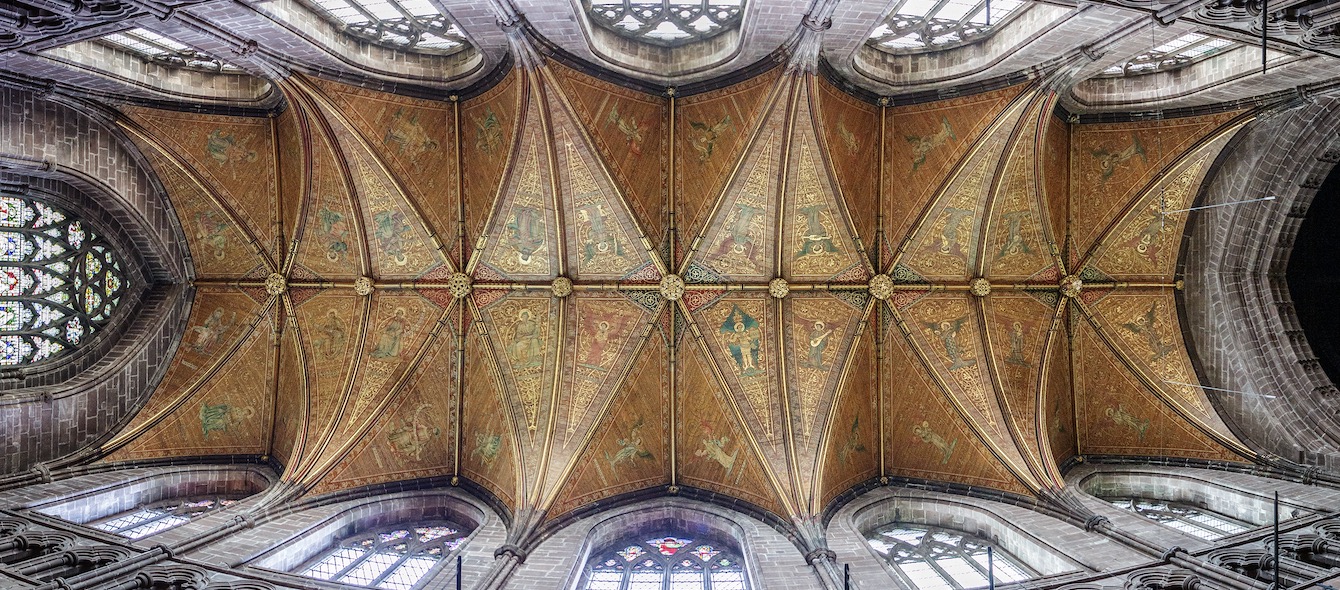
They’ve survived significant religious upheaval, two world wars and the British weather…but these soaring arches, timeless stone, carvings, paintings and intricate detail invite just one thing: “Lift up your eyes.”
#AlwaysLookUp is our summer campaign that invites visitors and worshippers to turn their eyes upwards, lift up their gaze and stay awhile to discover a treasure trove of centuries-old carvings and paintings and an explosion of colour on the ceilings of our cathedrals.
There they can find carved wooden angels playing golden instruments and hundreds of roof bosses depicting figures and images from Bible stories and Medieval history that have inspired generations of churchgoers to glimpse a little piece of heaven from their place on earth.
These are the very best feats of engineering, soaring, spectacular fan vaulting and chancel cloisters, so if you only do one thing this summer, lift up your eyes, always look up … and see what you might discover.
All the photos and stories are supplied by the Cathedrals themselves, their best photographs of their best ceilings.
Cathedral Ceilings – Always Look Up
We’re running through these in alphabetical order starting with Birmingham.
Birmingham
The chancel ceiling at Birmingham Cathedral features an intricate pattern of rosettes in its plasterwork, adorned with stunning gold gilding.

This design weaves around six Corinthian pillars – three on either side. The chancel was added to the then-parish church in the late 1800s to accommodate changes to Anglican worship.
The Baroque architecture created by Thomas Archer in the early 1700s is seamlessly blended with the later work of J.A. Chatwin, who is well-known and respected for his contributions to the building in the latter half of the 19th century.
This intricate detailing survived damage to other parts of the cathedral roof during the Second World War.
Blackburn
An iconic shot looking up from the high altar at Blackburn Cathedral. Even the sun is shining through the Lantern Tower, adorning the Corona, and helping the six-winged seraphim to shimmer!
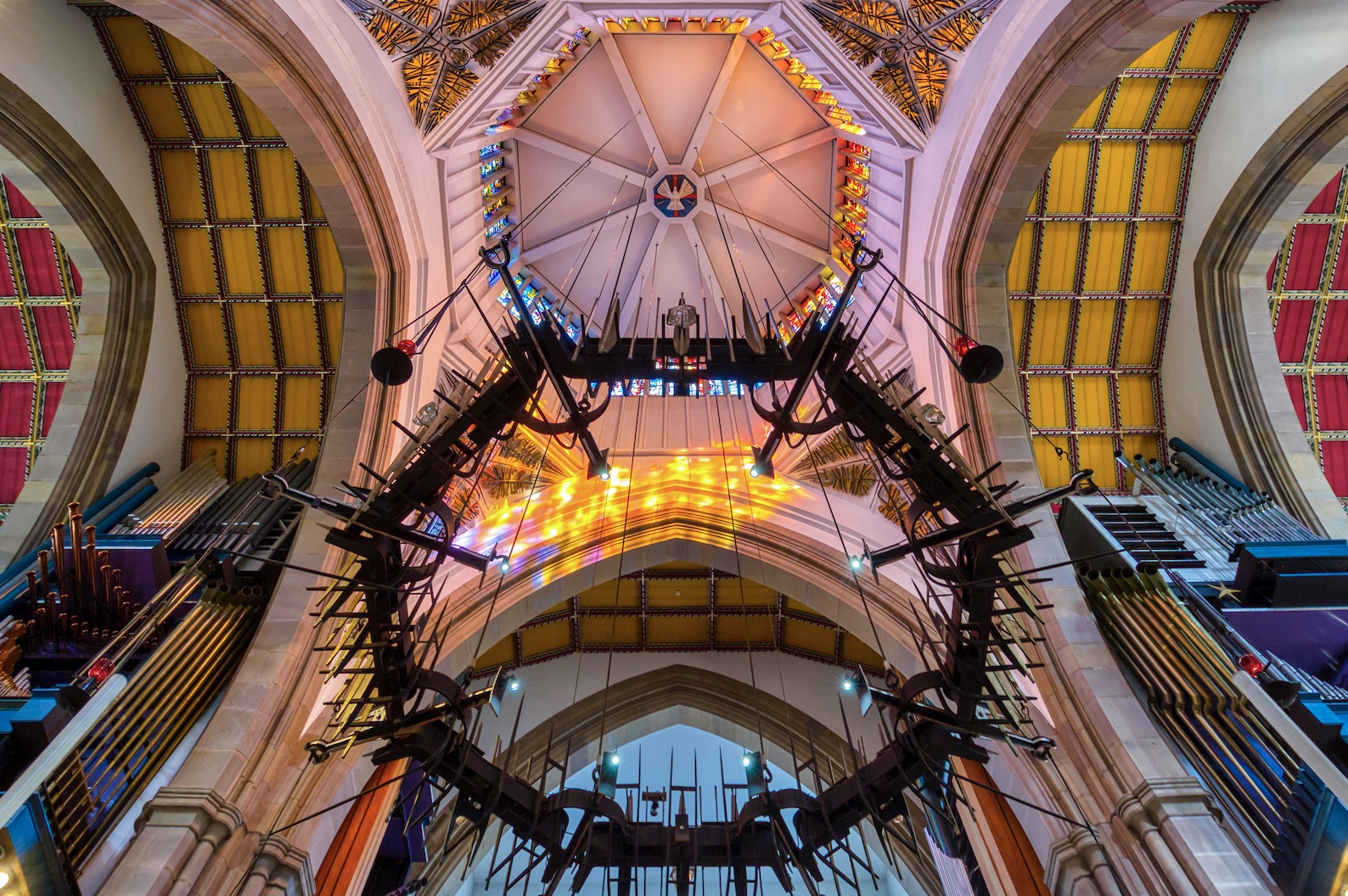
Bradford – Terrific timbers
When you visit Bradford Cathedral, you can’t help but be impressed by the beautiful oak ceiling above the nave. It was put in place in 1724, with the oak timbers coming from nearby Tong Forest. Previous church ceilings and roofs prior to this were probably roofed in thatch or other traditional local materials and there are old church wardens’ records mentioning the roof leaking prior to its renewal in 1724 and referring to repairs. Despite objections from churchwardens in the parish, the vicar went ahead with the new oak-timbered ceiling. The church rate for 1724 was considerably increased to £210, presumably to cover the large costs.
In the late 1700s, during the religious revival, galleries were put up over the north and south aisles and later at the west and east ends. The church was plastered and a flat, whitewashed ceiling was put up, thus covering up the beautiful timbered ceiling. The oak ceiling was later uncovered and the walls restored to their original colour from the 1860s.
The striking angels supporting the beams were installed after 1860, as part of the renovation work. Many hold musical instruments mentioned in the Bible, with some holding a scroll or shield. They are carved from stone and were gilded and painted in the 1960s, in order to add colour in the nave to balance the brightness and colour of the newly extended east end of the Cathedral. The two angels near the tower hold shields of royal lords of the manor and patrons of the living, John of Gaunt and Thomas, 2nd Earl of Lancaster.
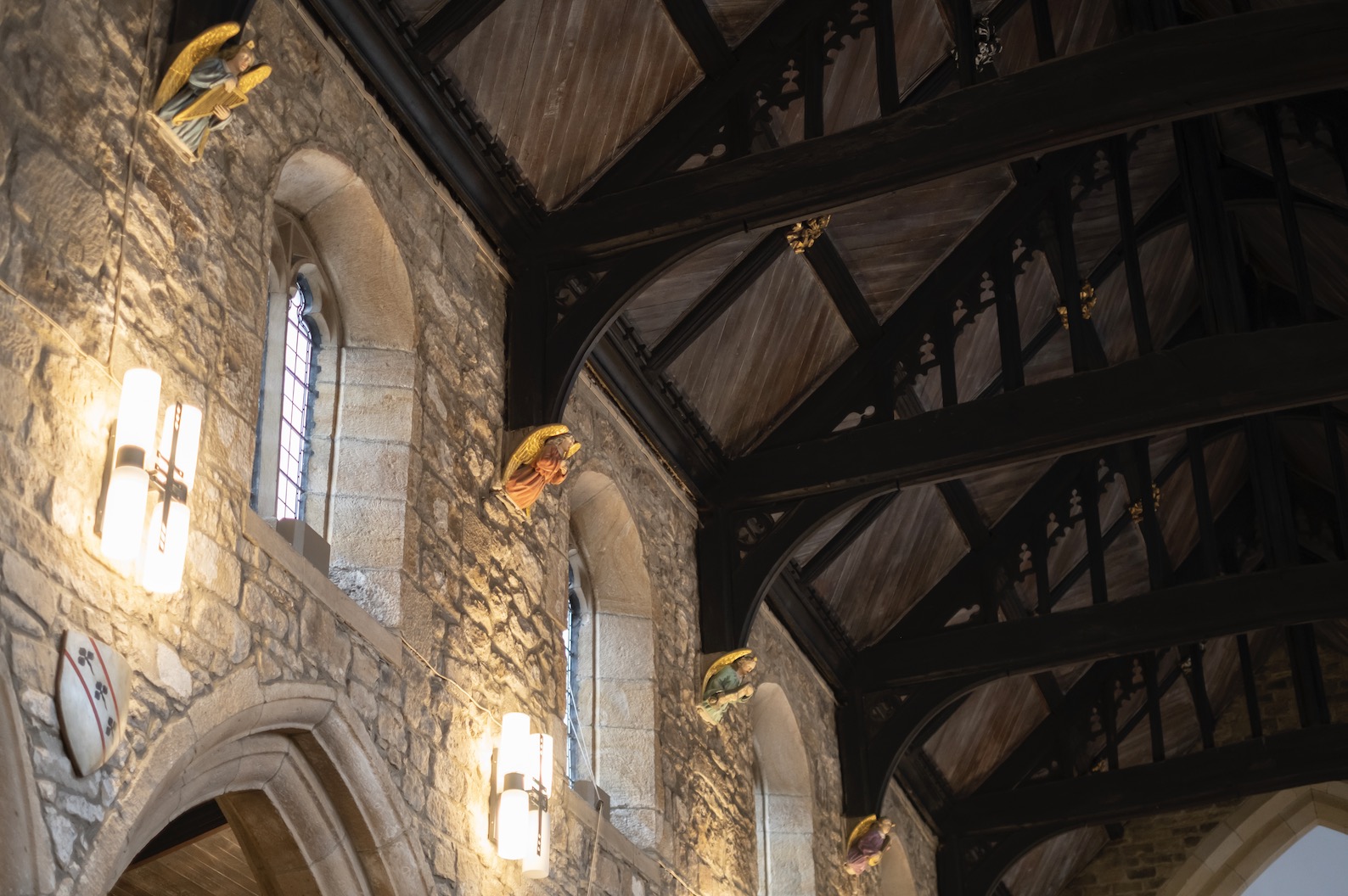
Bristol – The Lord Mayor’s Chapel: Poyntz Chapel Ceiling
Background:
The church, on College Green, was originally part of the Hospital of Saint Mark, founded in 1220, it used to be part of the Abbey of St Augustine, known today as Bristol Cathedral. The nave and south aisle were built in the 13th century in early decorated gothic style. The chancel, south aisle chapel and reredos are the result of rebuilding by Miles Salley, Bishop of Llandaff in about 1500.
The Tudor Ceilings:
The nave’s roof (below) is early 16th century and is a fine example of Tudor architecture.

The “Chapel of Jesus” or “Poyntz Chapel” was built in 1523 as a chantry chapel by Sir Robert Poyntz of Iron Acton, Gloucestershire, a noted supporter of King Henry 7th at the Battle of Bosworth.
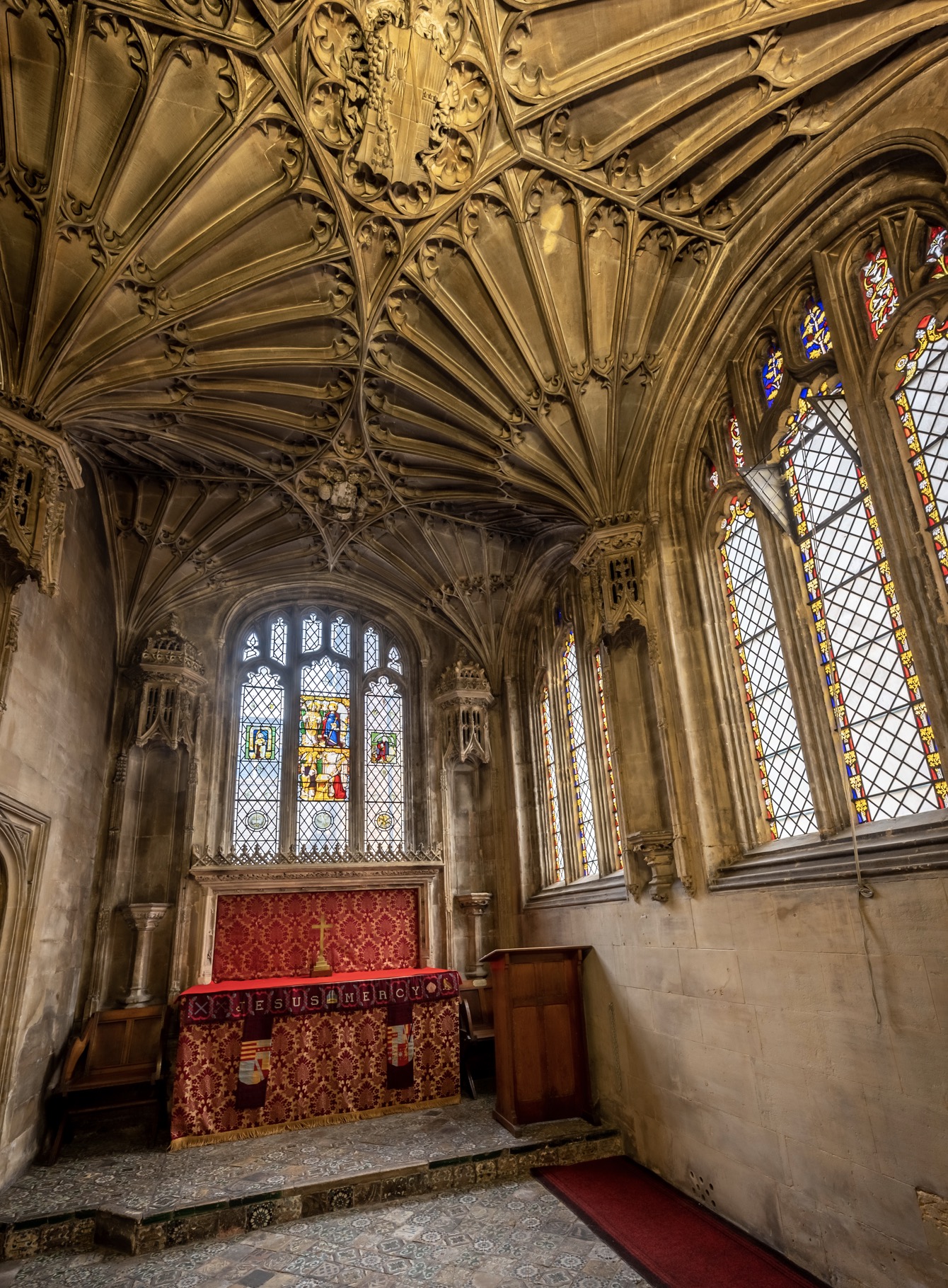
The Poyntz Chapel is fan vaulted with an escutcheon showing the arms of Poyntz, Henry VIII and Catherine of Aragon. It is one of only two in the country.
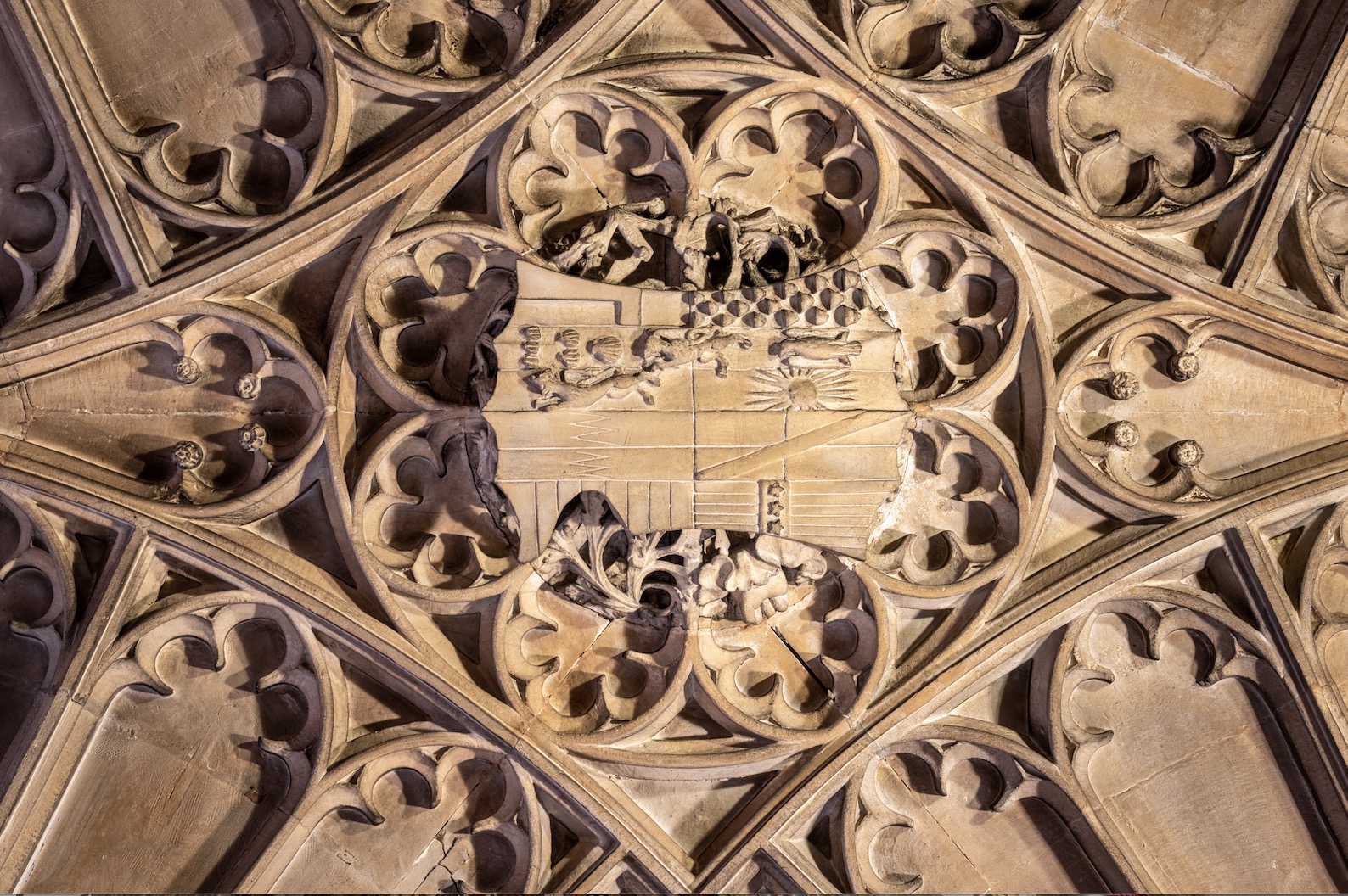
After the dissolution of the monasteries, the chapel, then part of Gaunt’s Hospital, was leased to Sir Edward Carne in 1539. In 1540, it was acquired by Bristol Corporation (now Bristol City Council). Since then, it has been used by a school (1590 – 1767) and by those who couldn’t worship anywhere else (e.g. Huguenots and John Wesley).
It’s remarkable to think that this building has endured through the most significant religious upheaval in England, and that its relics have survived to this day. Since last year, it has come back into the care of Bristol Cathedral and remains a gem of our city’s hidden history.
Canterbury
This photo (below) shows the exquisite vaulting in the Dean’s Chapel
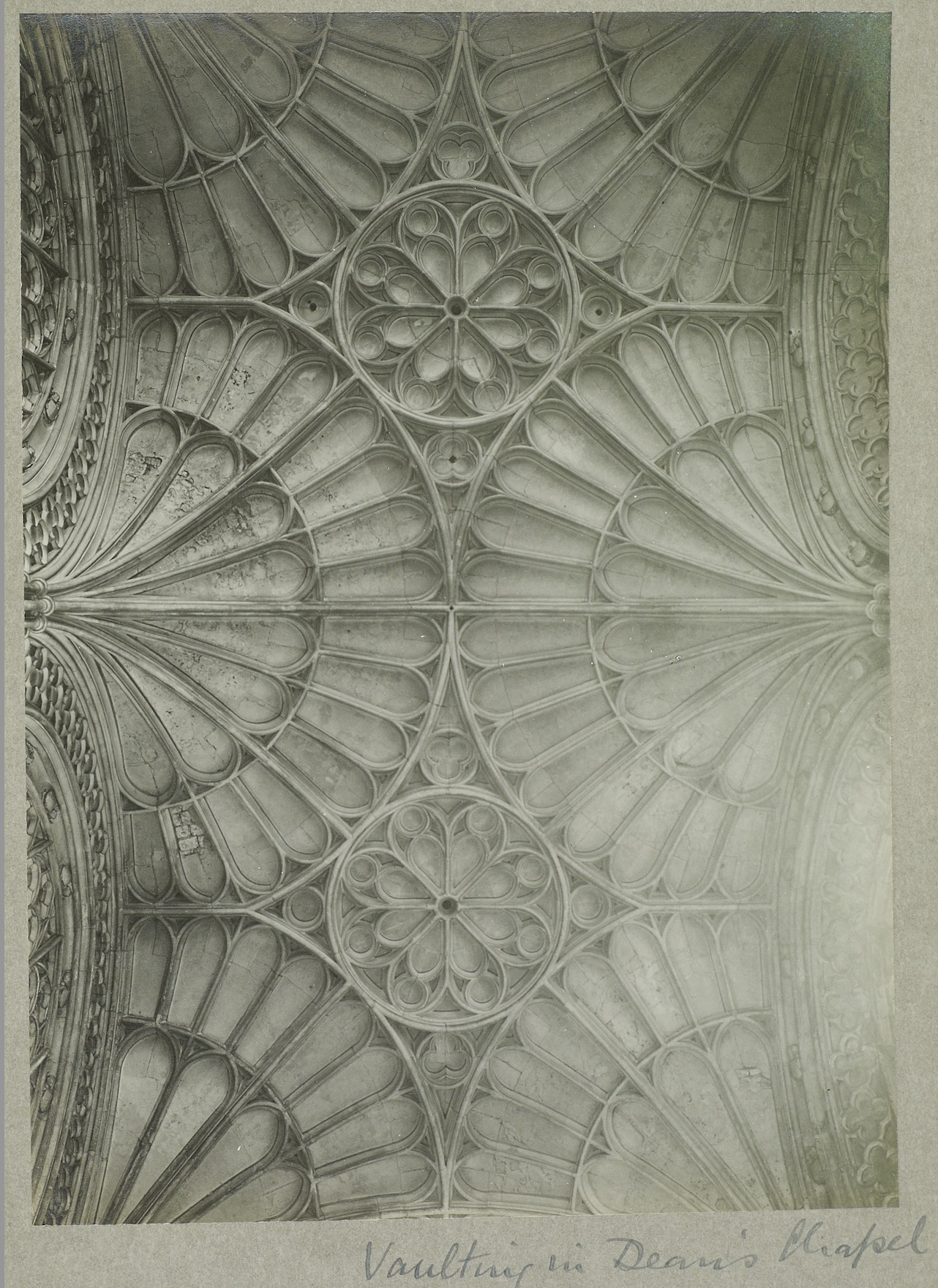
Here we showcase 4 bosses in the ceiling of the Black Prince’s Chantry Chapel/Huguenot Chapel
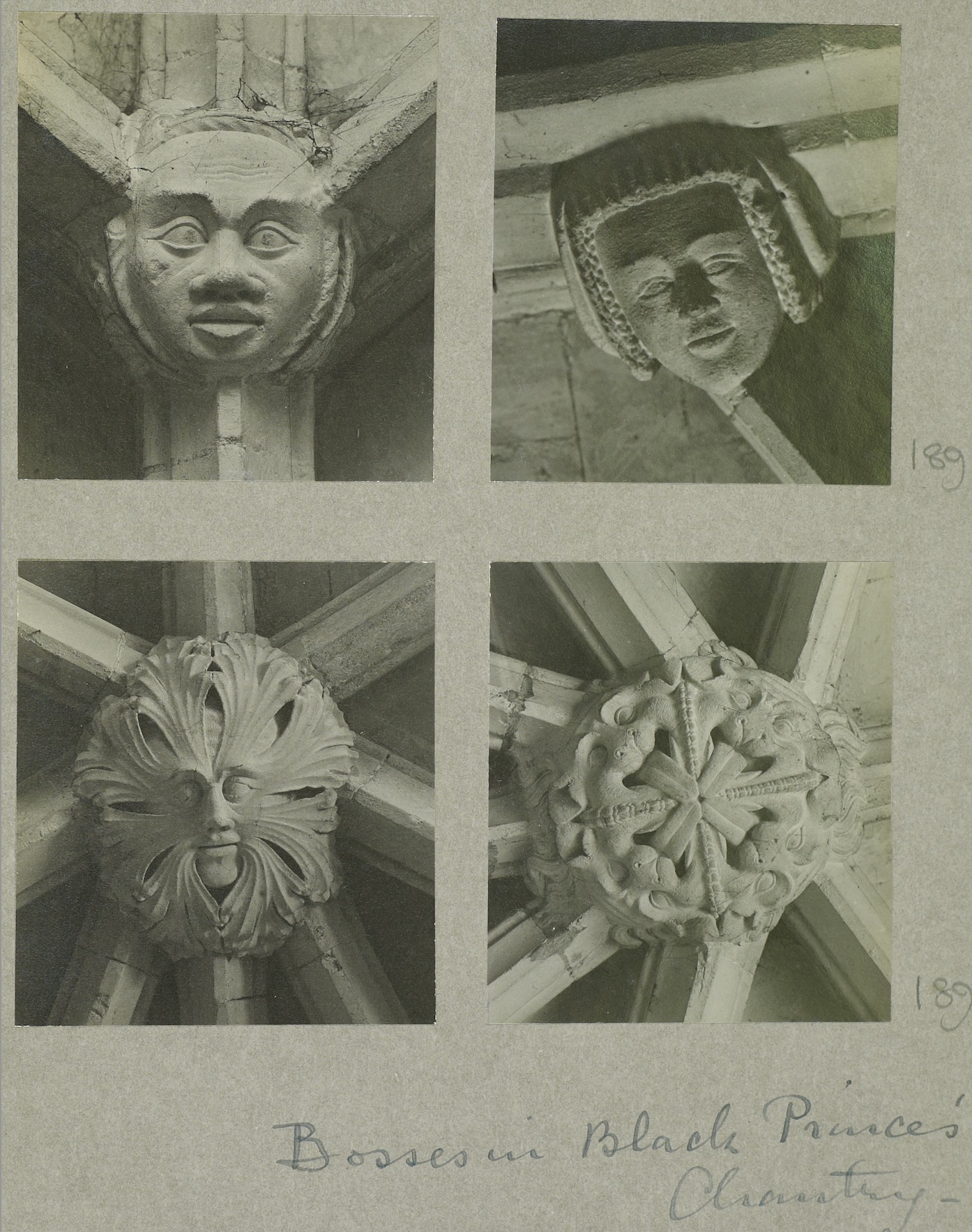
The final picture shows two photographers capturing images of the Cloister ceiling with folding/bellows cameras.
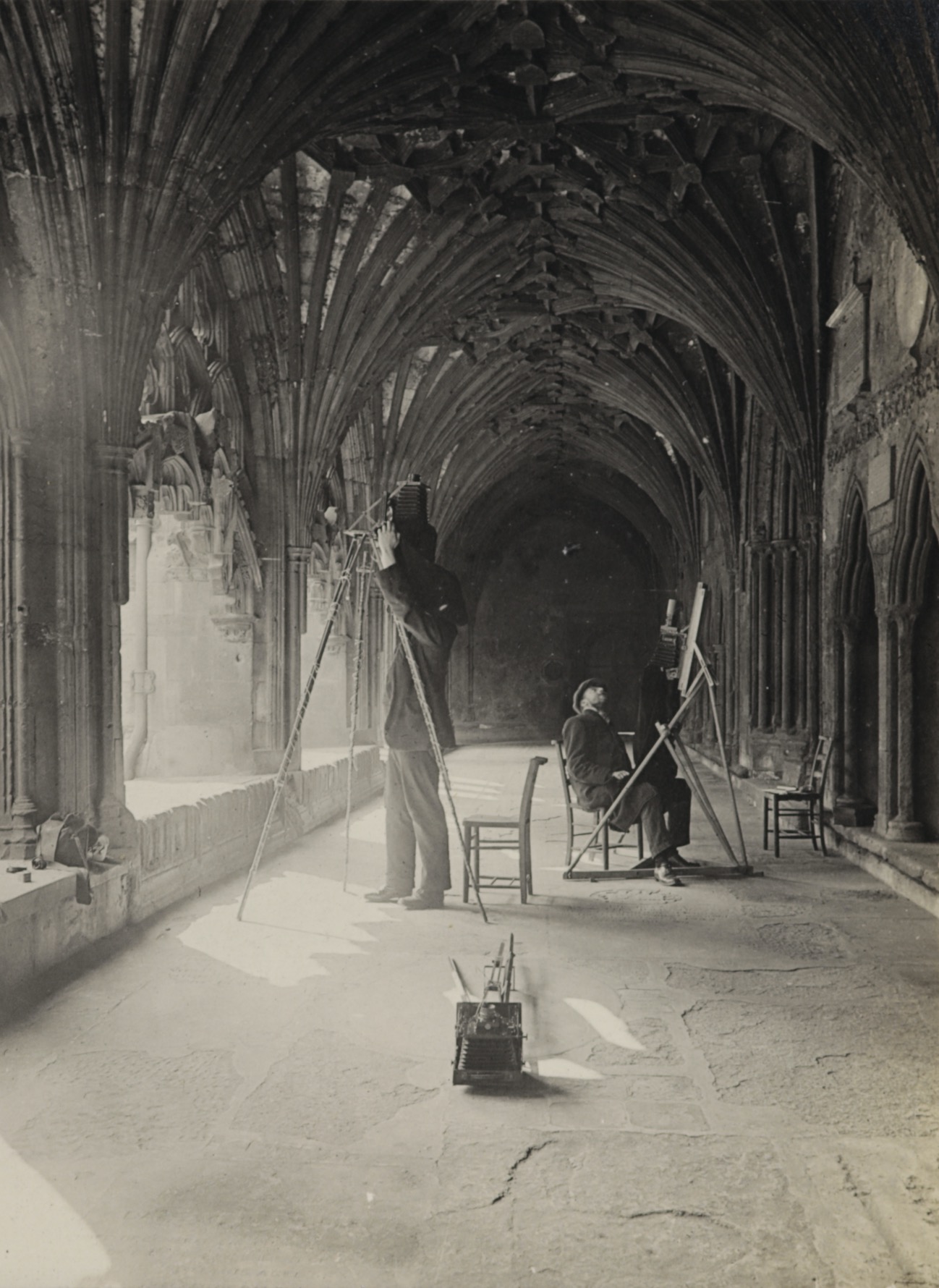
Carlisle
We adore this starry ceiling! The decorative scheme dates from Ewan Christian’s restoration of the Cathedral 1853-6. The style follows the medieval original, but the detailed design and colour (angels and stars) was the work of Owen Jones (1809-1874), one of the great decorative artists of the day. The ceiling was last repainted in 1970. The story of this iconic ceiling is available in the book Heaven’s Above, by Jim Palmer, available from the Cathedral or our online shop.
The ceiling has inspired many events, school visits and workshops, including the ‘Rest Under The Stars’ project, developed with Prism Arts (a local arts charity), which encouraged visitors to rest on deckchairs (designed by the artists and inspired by the Cathedral), under our starry ceiling, whilst listening to a bespoke soundtrack inspired by the sounds of the city of Carlisle and county of Cumbria.

Chelmsford
The Nave ceiling and clerestory were the result of architect John Johnson’s restoration after the collapse of 1800. The ceiling was beautifully coloured and gilded in 1961.
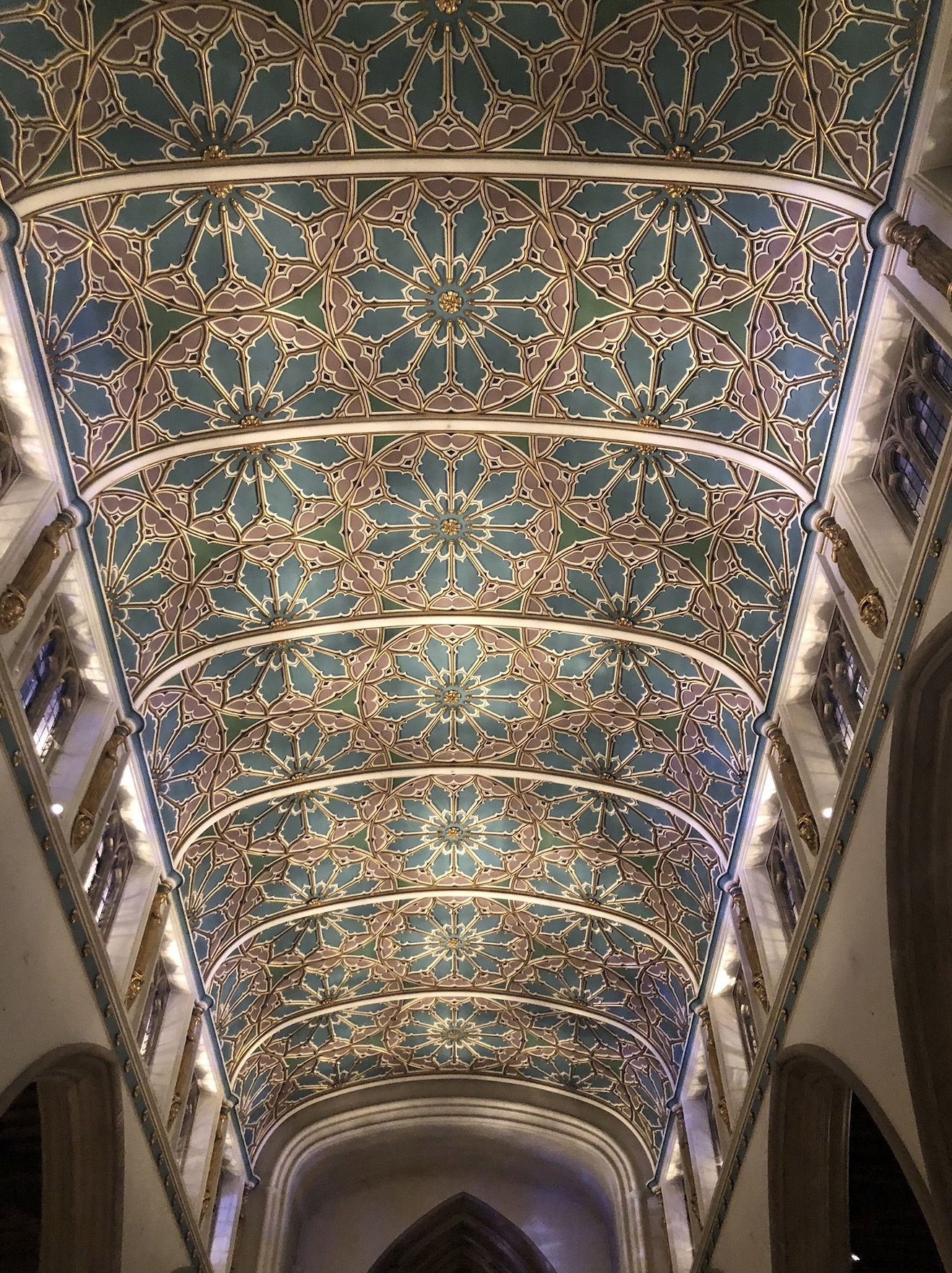
In the know guides at the Cathedral often encourage visitors to find the intentional flaw in the design made to symbolise that while God doesn’t make mistakes, people do.
See if you can spot it below or better still, on your next visit!
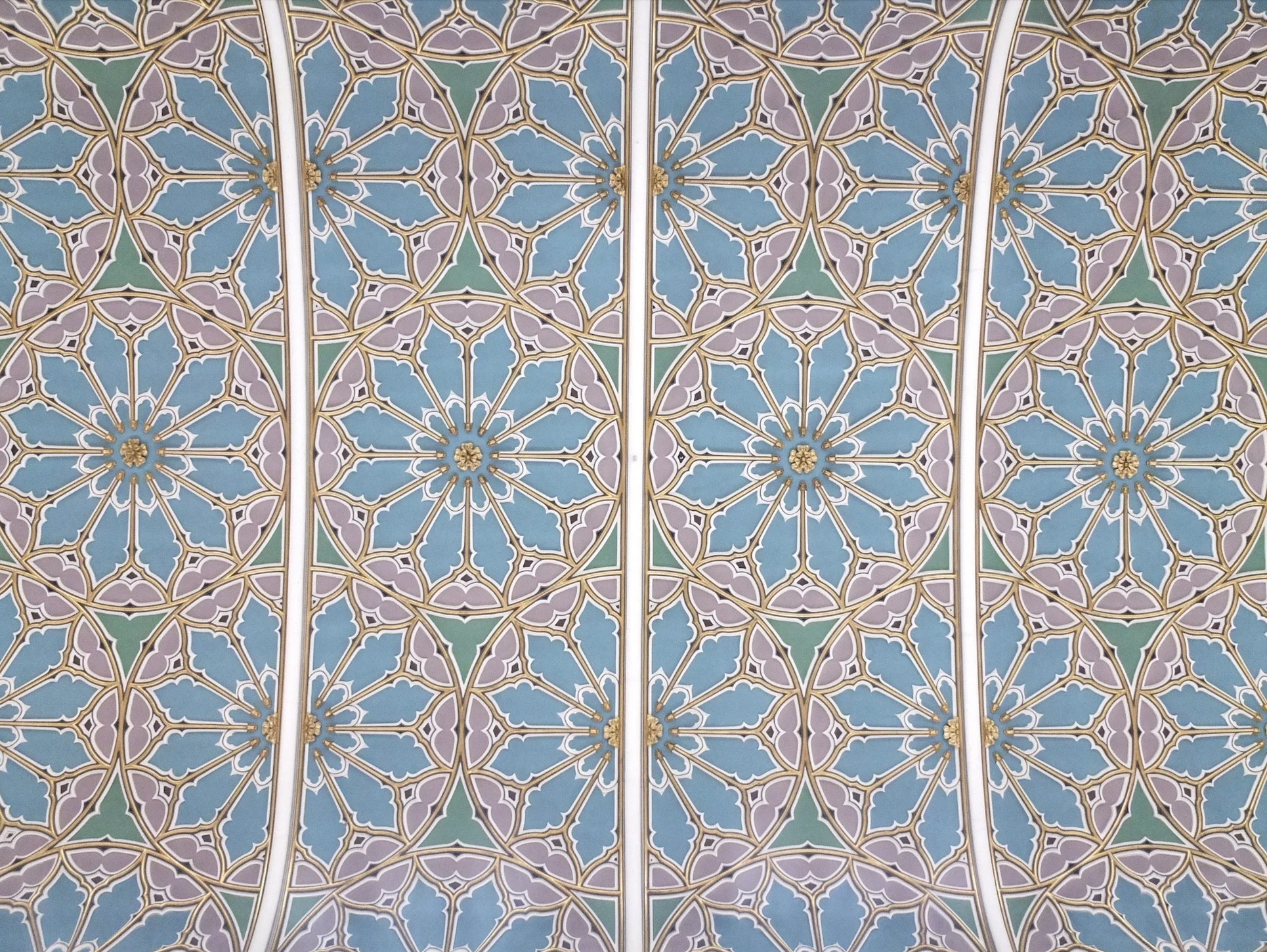
Chester
Originally constructed at the start of the fourteenth century, Chester Cathedral’s beautiful Quire ceiling was hand-painted as part of nineteenth-century restoration work under Sir George Gilbert Scott. The groined oak ceiling depicts the four major and twelve minor Biblical prophets, surrounded by angels. Evensong often takes place in the Quire with this lovely ceiling adding to the beauty of the sung service.
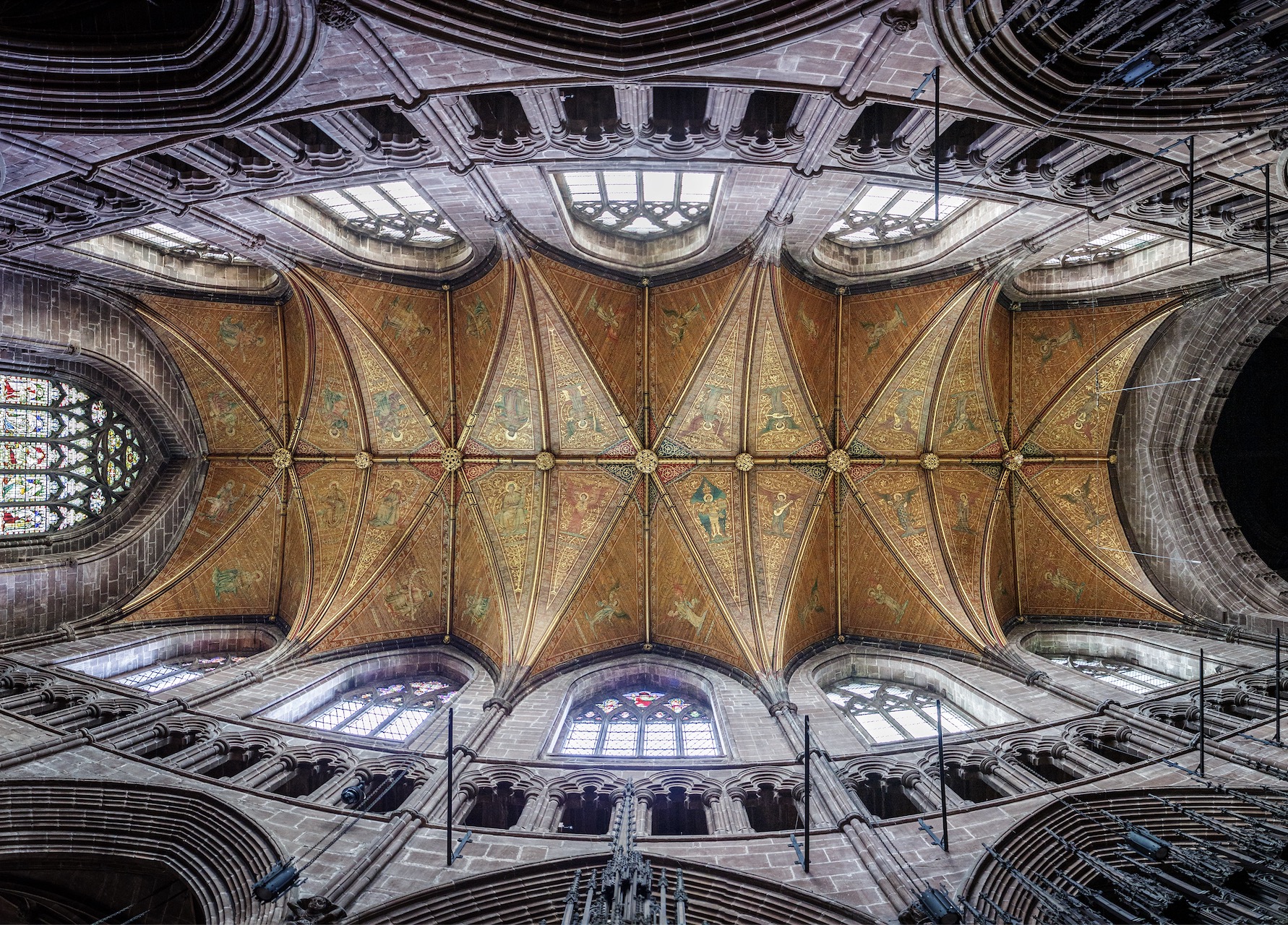
Photo taken by the verger at Chester, Gareth Rainsforth.
Chichester
On the vaulting near the western end of the Lady Chapel is a ceiling painting by Lambert Barnard (1485-1567). This painting narrowly escaped obliteration during work carried out in the early 19th century – it was protected by the stacked bookcases of the Cathedral library which was housed in the chapel at that time.

Christ Church
“Nice chancel fan vaulting” – Jack, Cathedral Communications Office, Christ Church Cathedral.

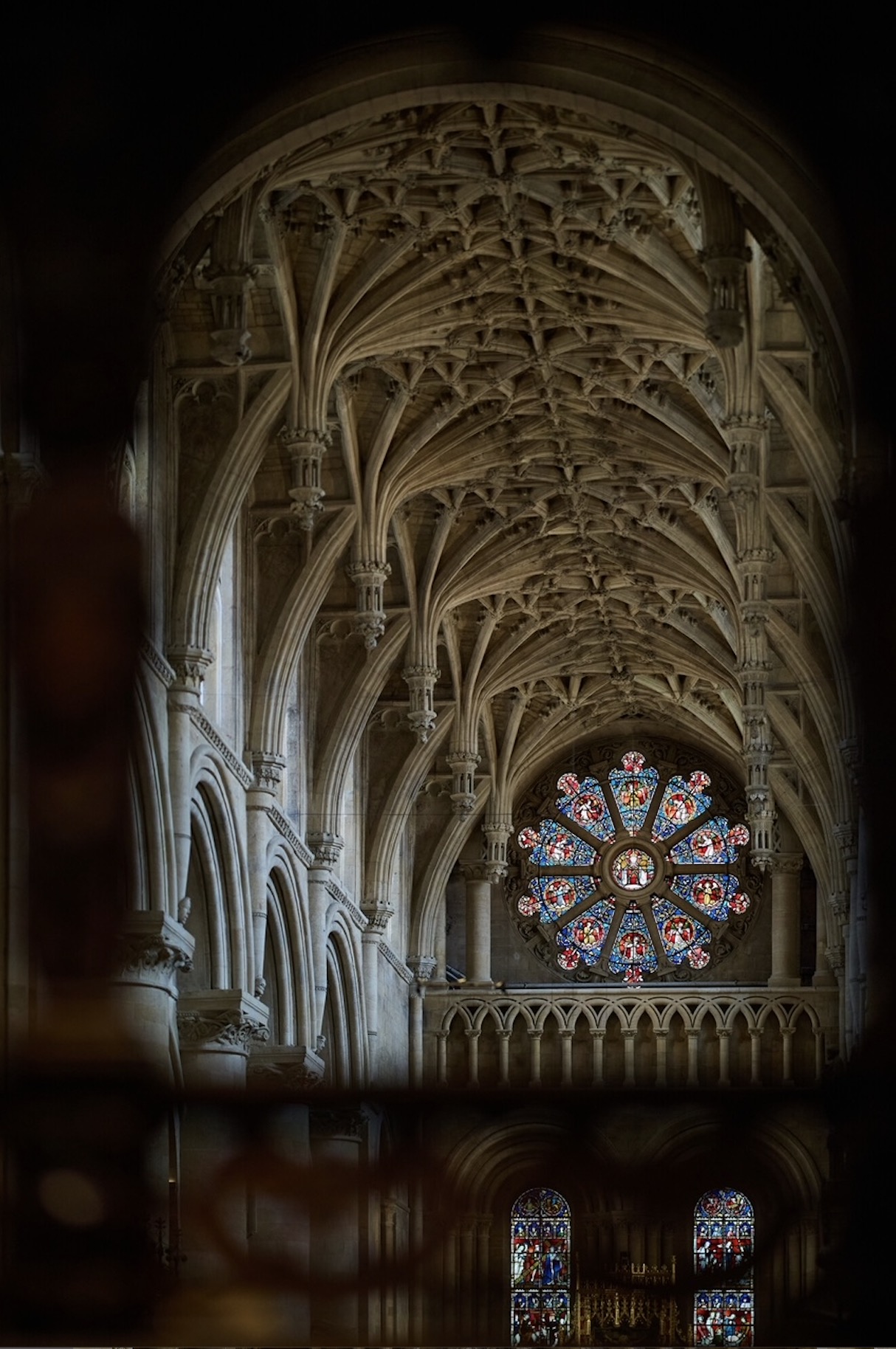
Note: Understatement of the year nominee.
Coventry
The ceiling in the New Cathedral isn’t actually a ceiling – it’s a decorative canopy held only at each end, making the columns throughout the cathedral nave structurally unnecessary.
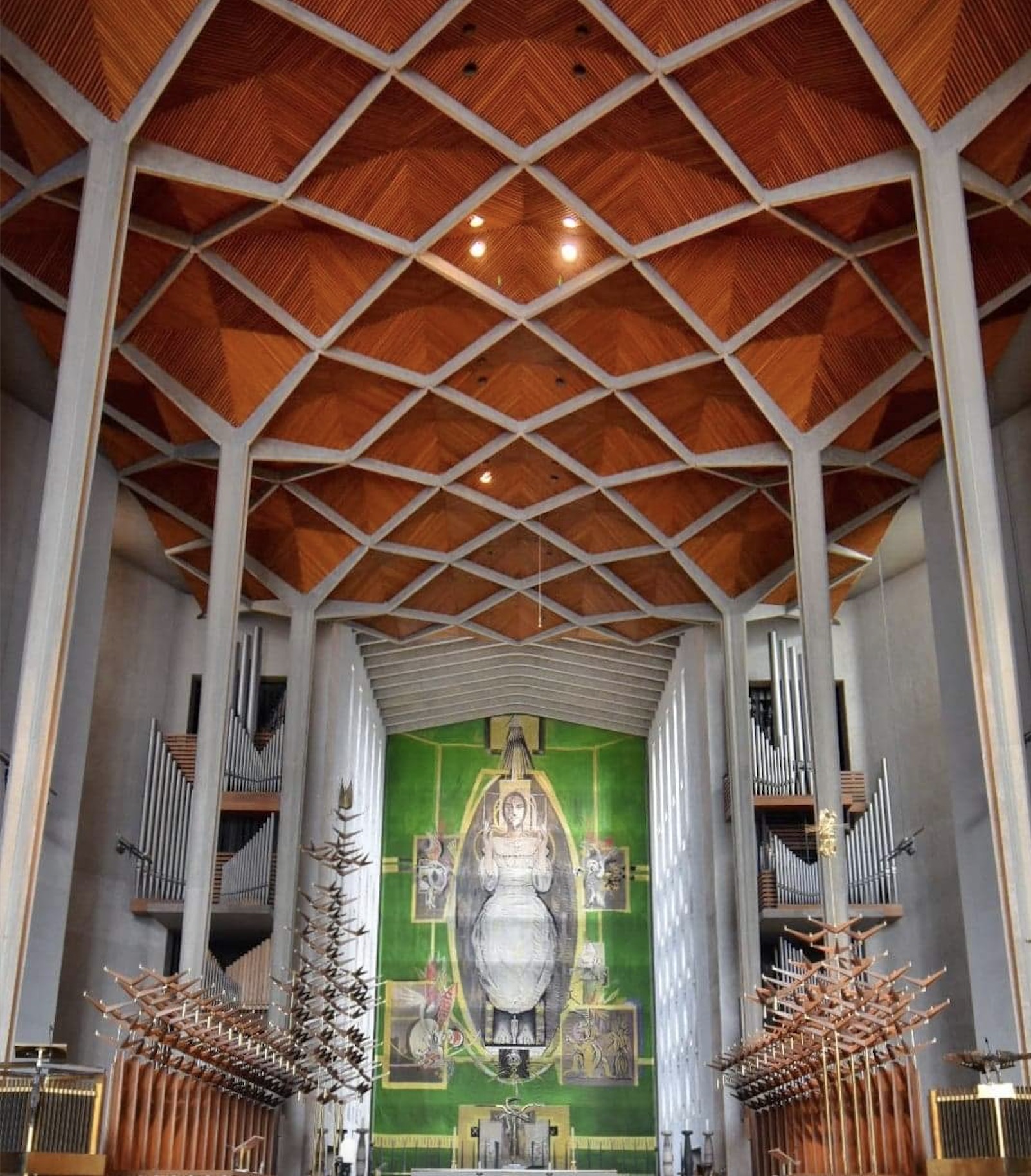
Cathedral architect Sir Basil Spence claimed that the design was partly inspired by an image he had seen of a fly’s eye, which led to press at the time referring to Coventry as the ‘Fly’s Eye Cathedral’.

Photo credit : James Morris, Mark Pemberton
Derby
The photo (below) features the Baldachin, or canopy over the high Altar.
The golden ceiling of the Baldachin was suspended over the altar from 1927. It depicts a dove with the seven gifts of the Spirit radiating from it.
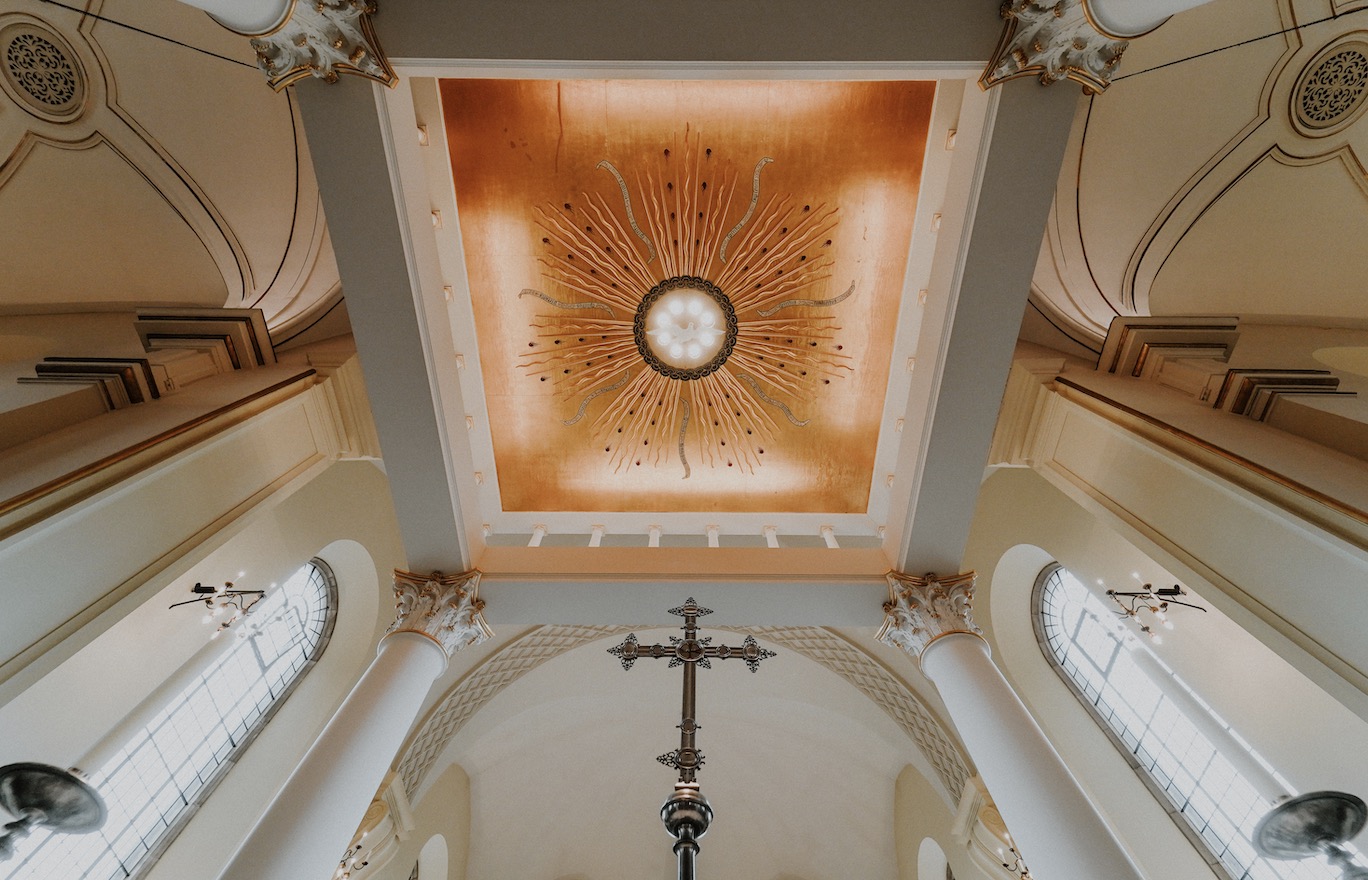
Durham – The Great Kitchen
Before the Reformation, Durham Cathedral was home to a community of around 60 monks who needed to be fed each day. The Great Kitchen was built to provide cooking facilities for the monks, their guests and pilgrims.
Work began on the Prior’s Kitchen, as it was called then, on 11th November 1366. It replaced an earlier kitchen that was part of the south cloister. John Lewyn (died 1398) was appointed as architect he had previously worked on the cathedral cloister.
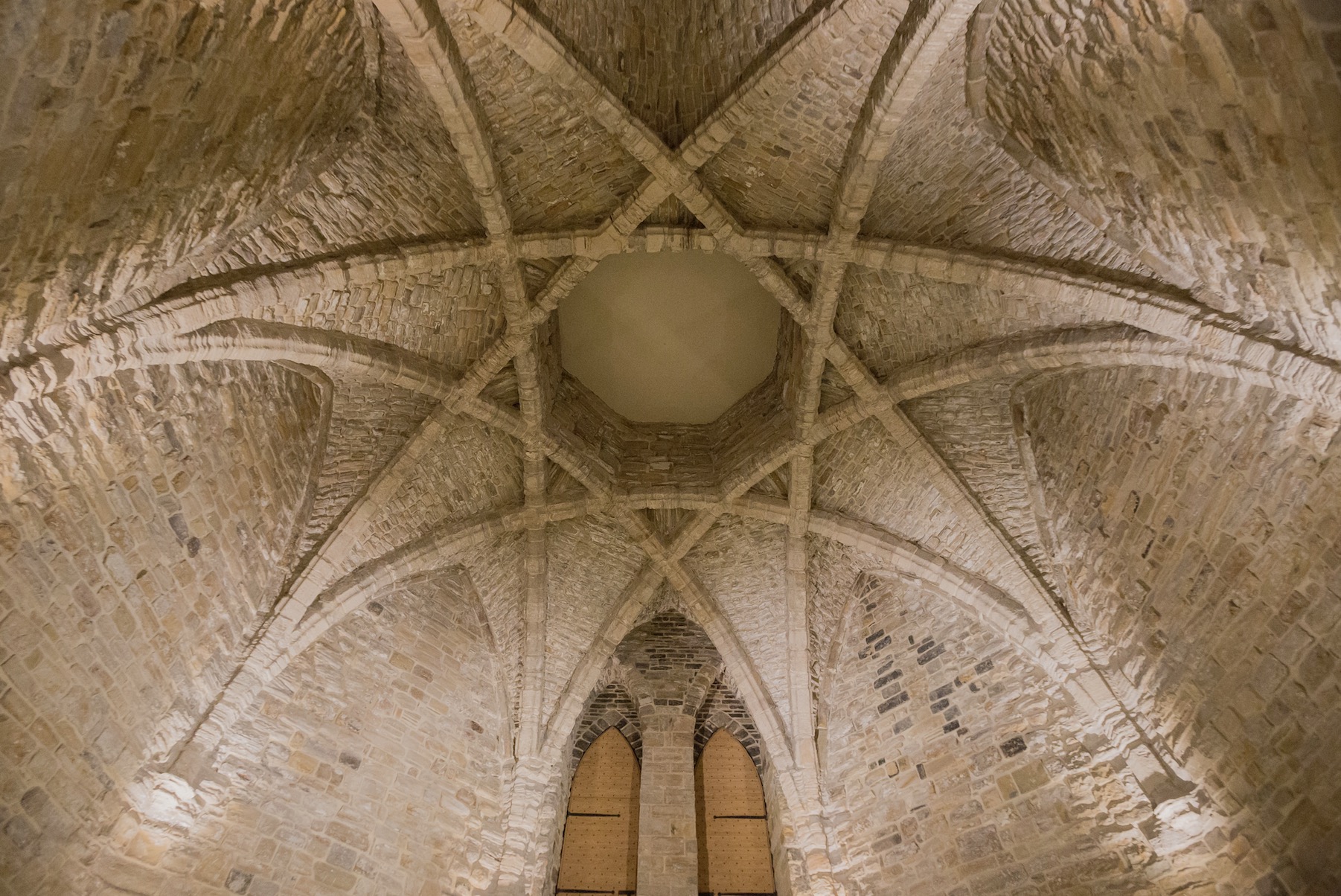
The Kitchen is square on the outside and octagonal (eight-sided) on the inside. Its most impressive feature is its vaulted ceiling. This was inspired by designs in Spanish and Persian architecture, including the Great Mosque of Cordoba in Spain. Each of the fireplaces around the walls has its own chimney built in, to allow smoke to escape. In the centre of the roof was also a ‘louvre’: a structure with slatted vents in the sides to allow smoke out and light in. Today, it is one of the best surviving examples of a medieval monastic kitchen in Europe.
Durham – Monks Dormitory
Completed in around 1404, the Monks’ Dormitory was originally built as sleeping quarters for the Durham Priory monks.
Ellis Harpour was responsible for building the Dormitory’s magnificent wooden roof.
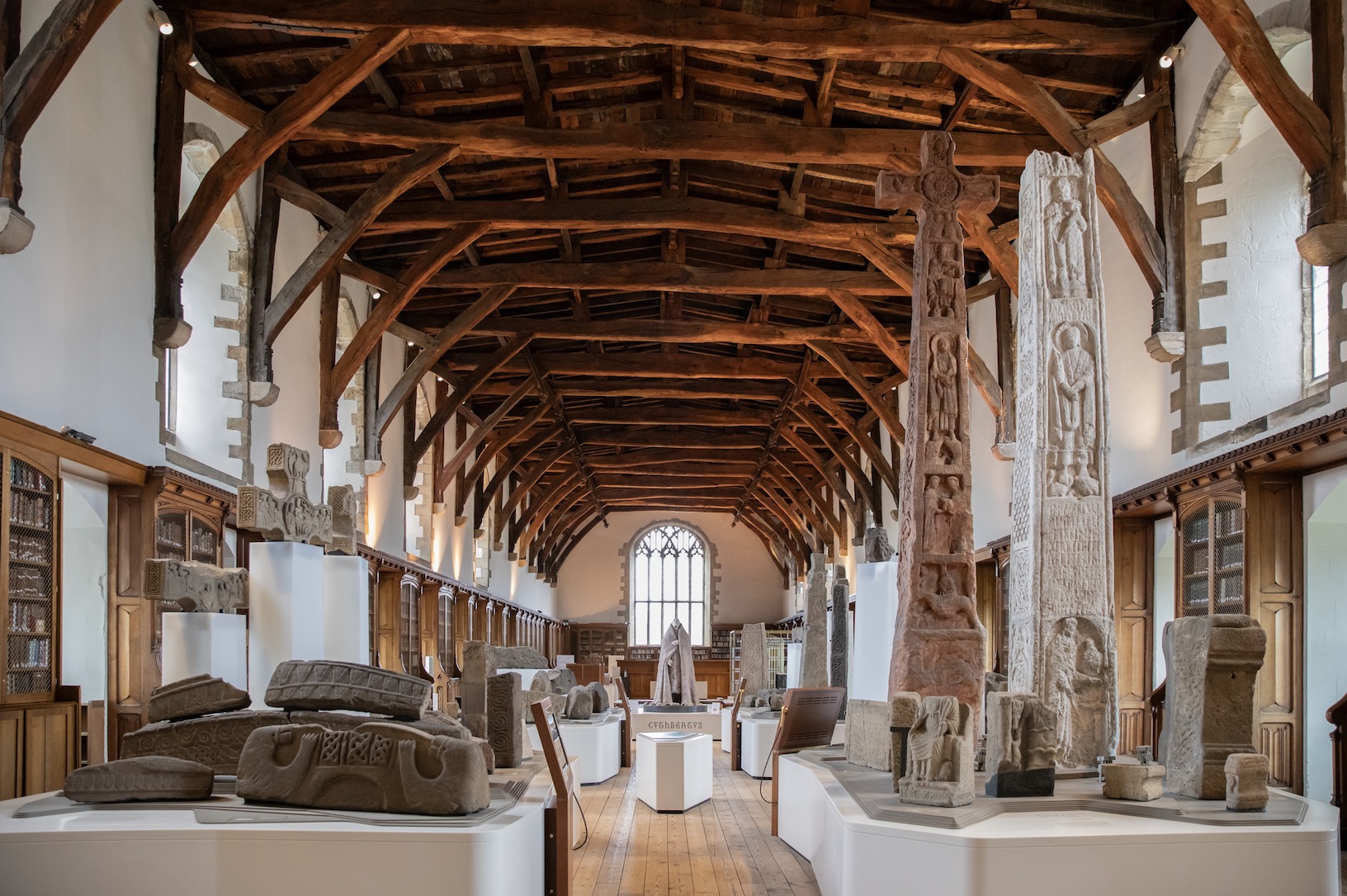
The 21 beams supporting it are made from massive oak tree-trunks. It is so well designed that the weight of the roof puts very little pressure on these beams. Very few medieval timber roofs of this scale and quality survive today and Durham’s is probably the best preserved large monastic dormitory in England.
Ely
When you walk through the main doors of Ely Cathedral and look up, this is the amazing sight you will see.
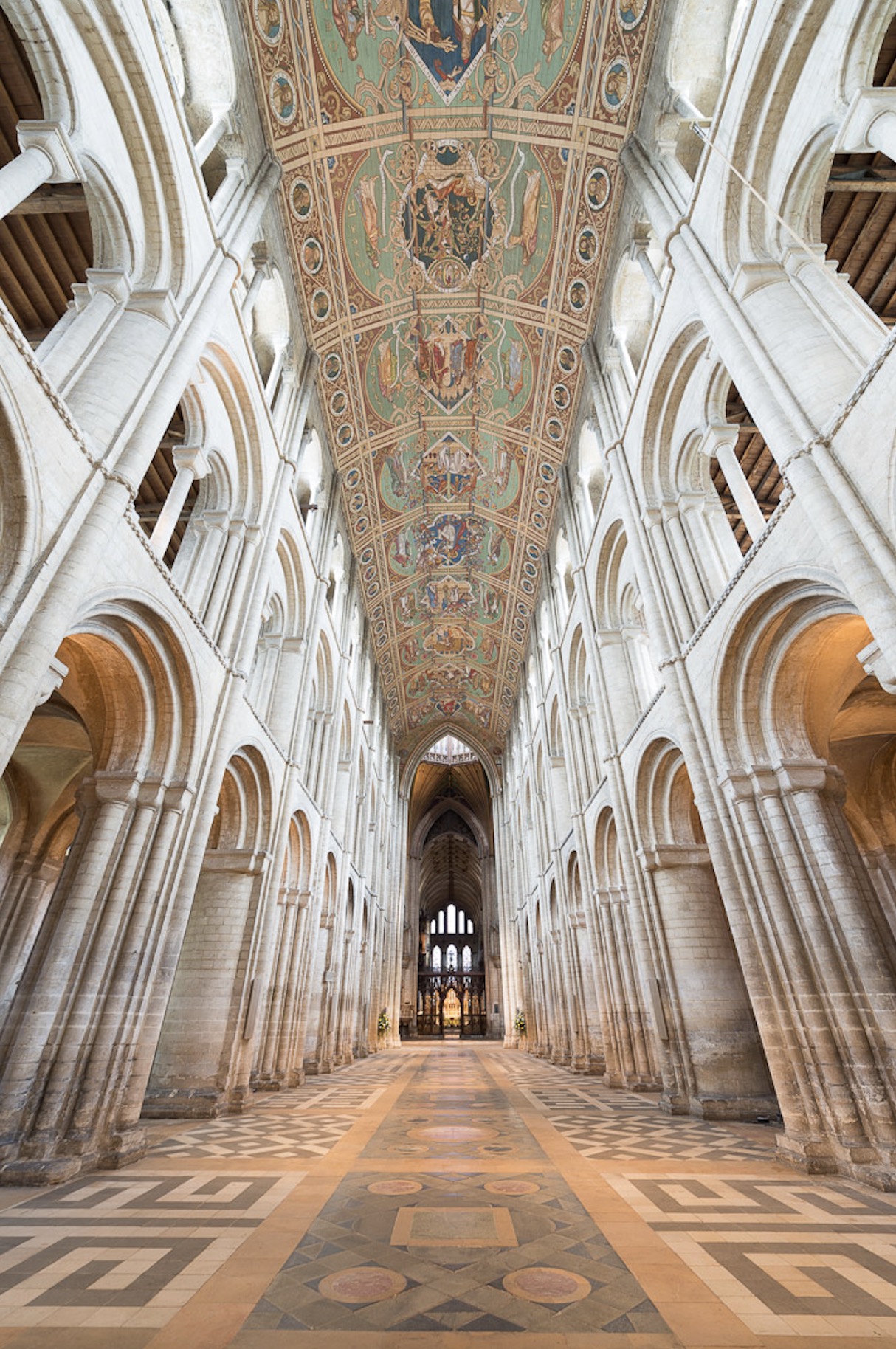
The magnificent Nave ceiling bears a sequence of 12 paintings, begun in 1860, by a man with the wonderful name of Henry Styleman Le Strange, from Hunstanton in Norfolk.
The first six panels from the west door were painted by him, but unfortunately he died before it was completed.
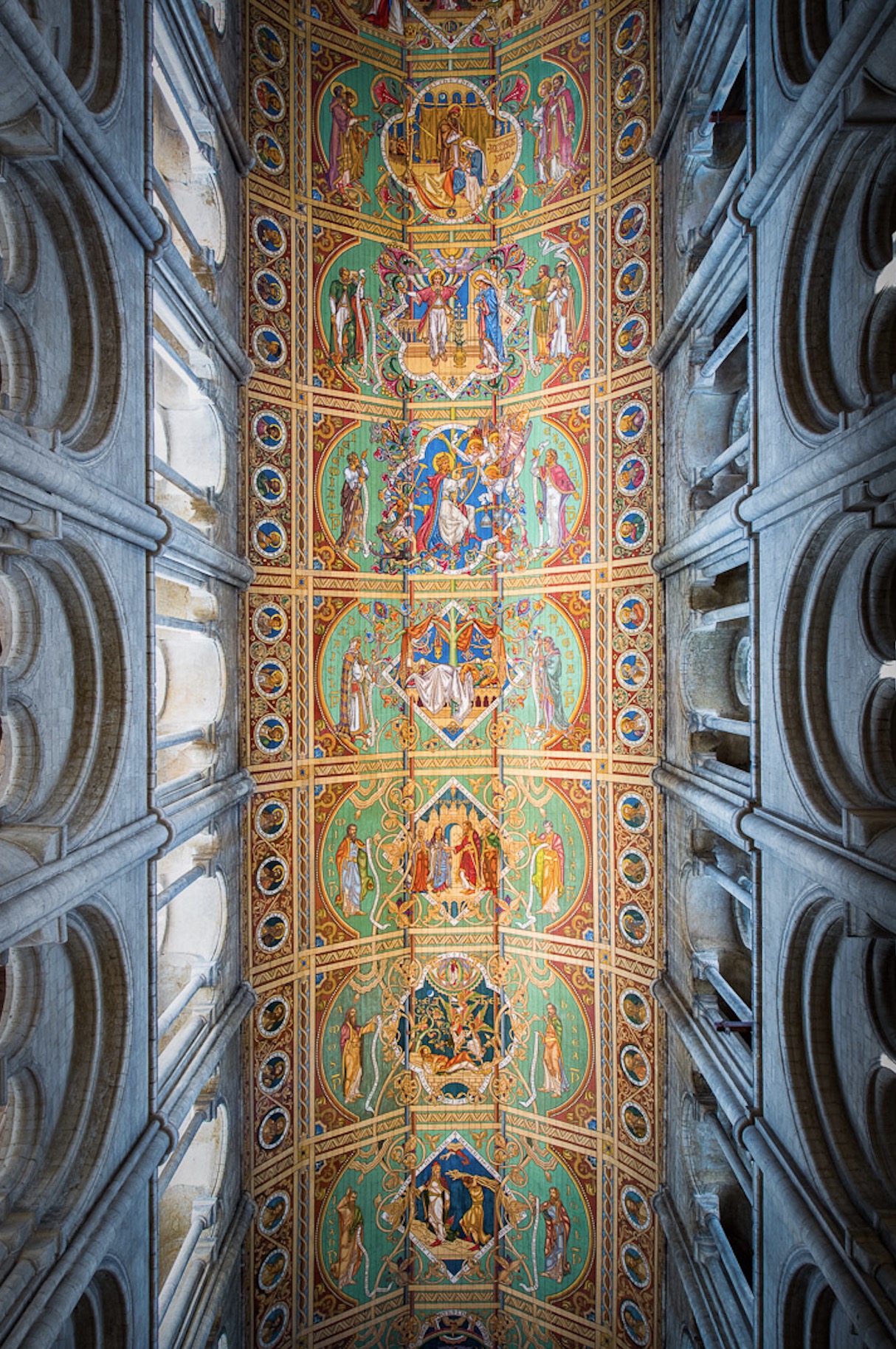
The next six panels had to be finished by his friend, Thomas Gambier Parry – can you spot the difference in the panels?
On panel no. 6 you will see a clean shaven Isaiah – it’s actually the face of Dean Peacock – a close friend of the artist.

Exeter
Exeter Cathedral’s 14th century nave and quire ceiling is the longest continuous medieval stone vault in the world. Because the cathedral has no central tower, the vault can run all the way from the west wall of the nave to the east end of the quire, a distance of approximately 96m (315ft).

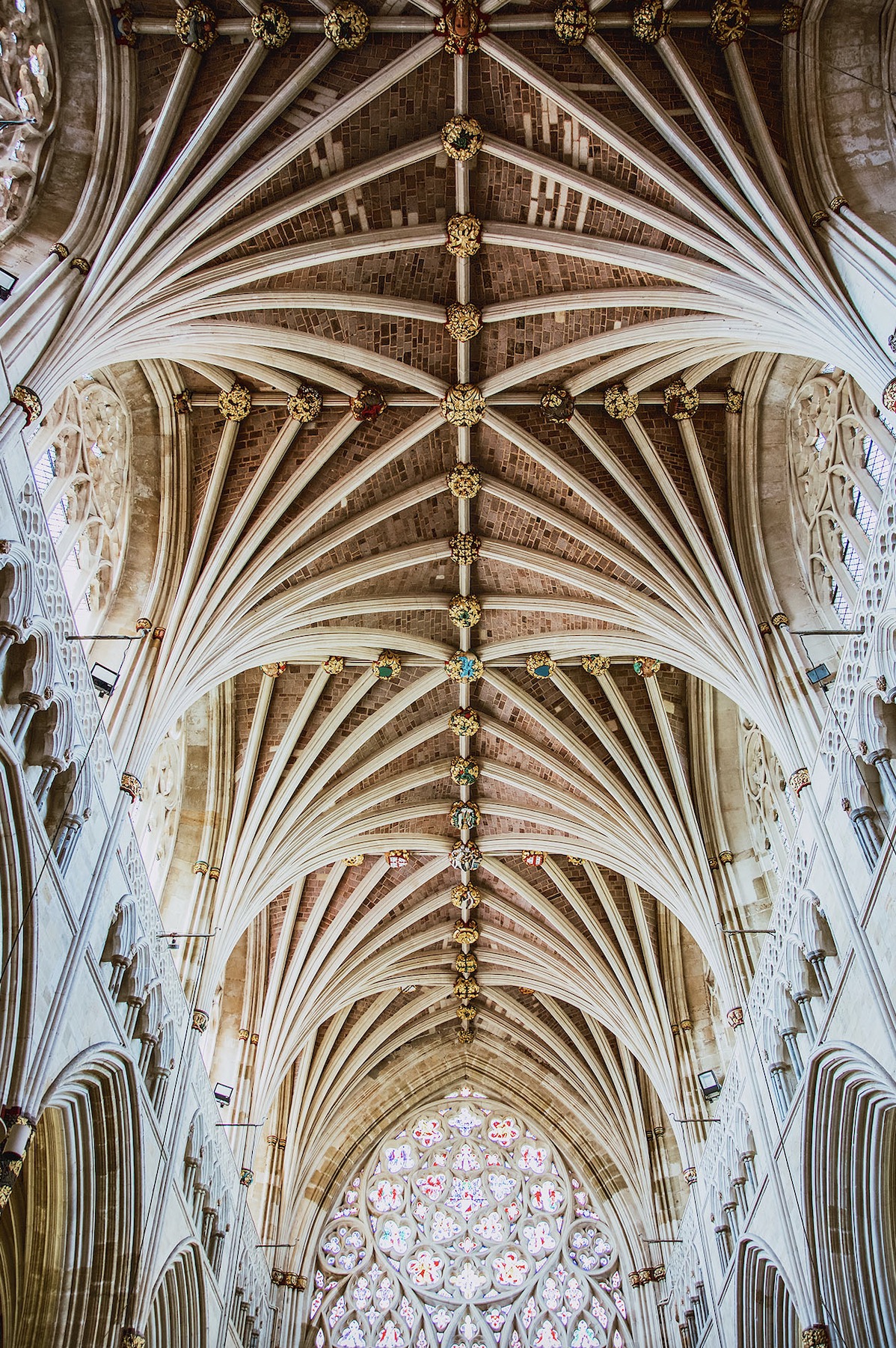
Photo credit : Emma Solley/Exeter Cathedral
Gloucester
When it comes to the ‘wow-factor’, the spectacular vaulted ceiling above Gloucester Cathedral’s Quire doesn’t disappoint – did you know that it is covered in over 400 roof bosses?
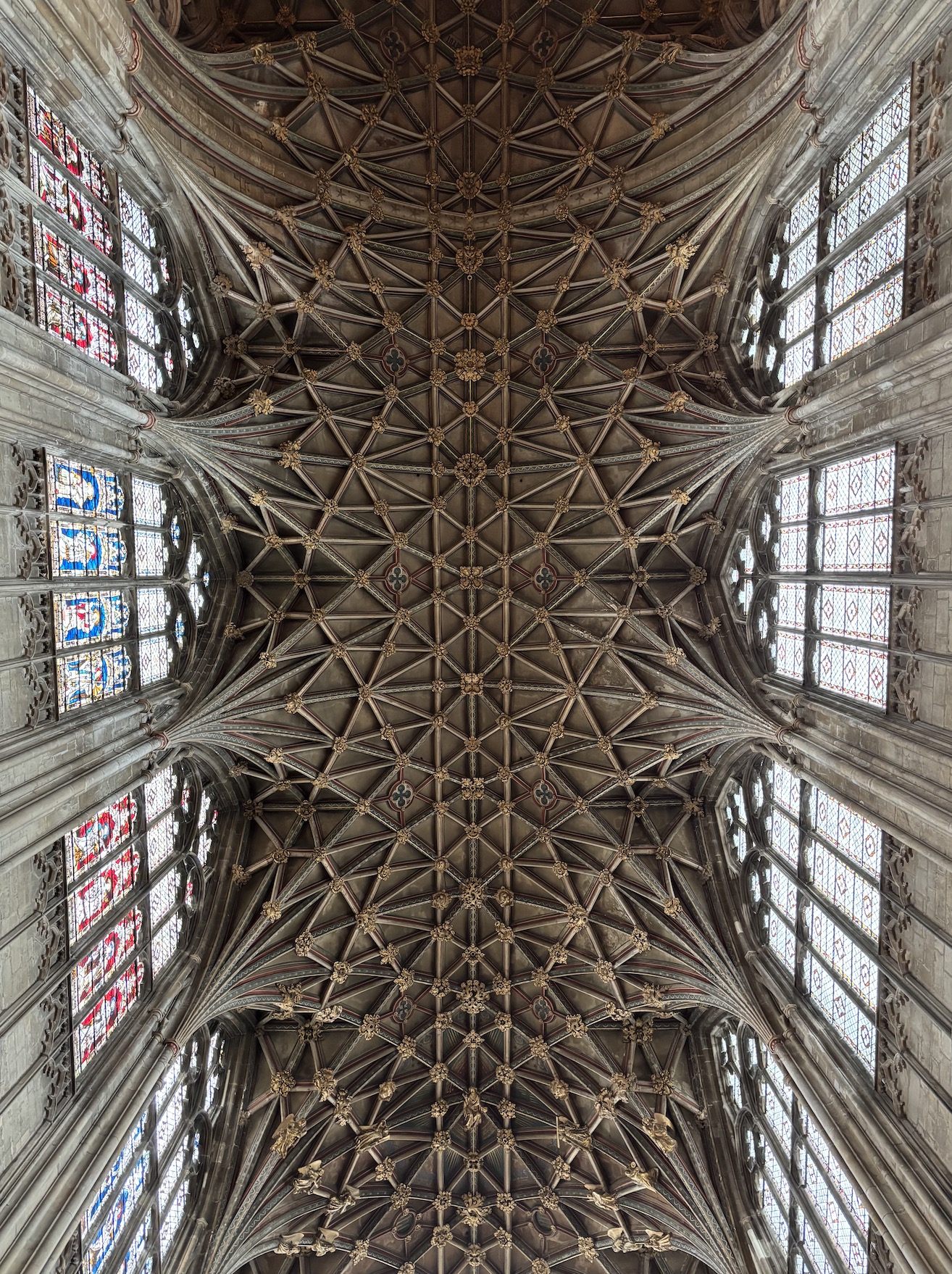
Bosses are carvings at the points where the ribs come together, and they are highly decorative here.
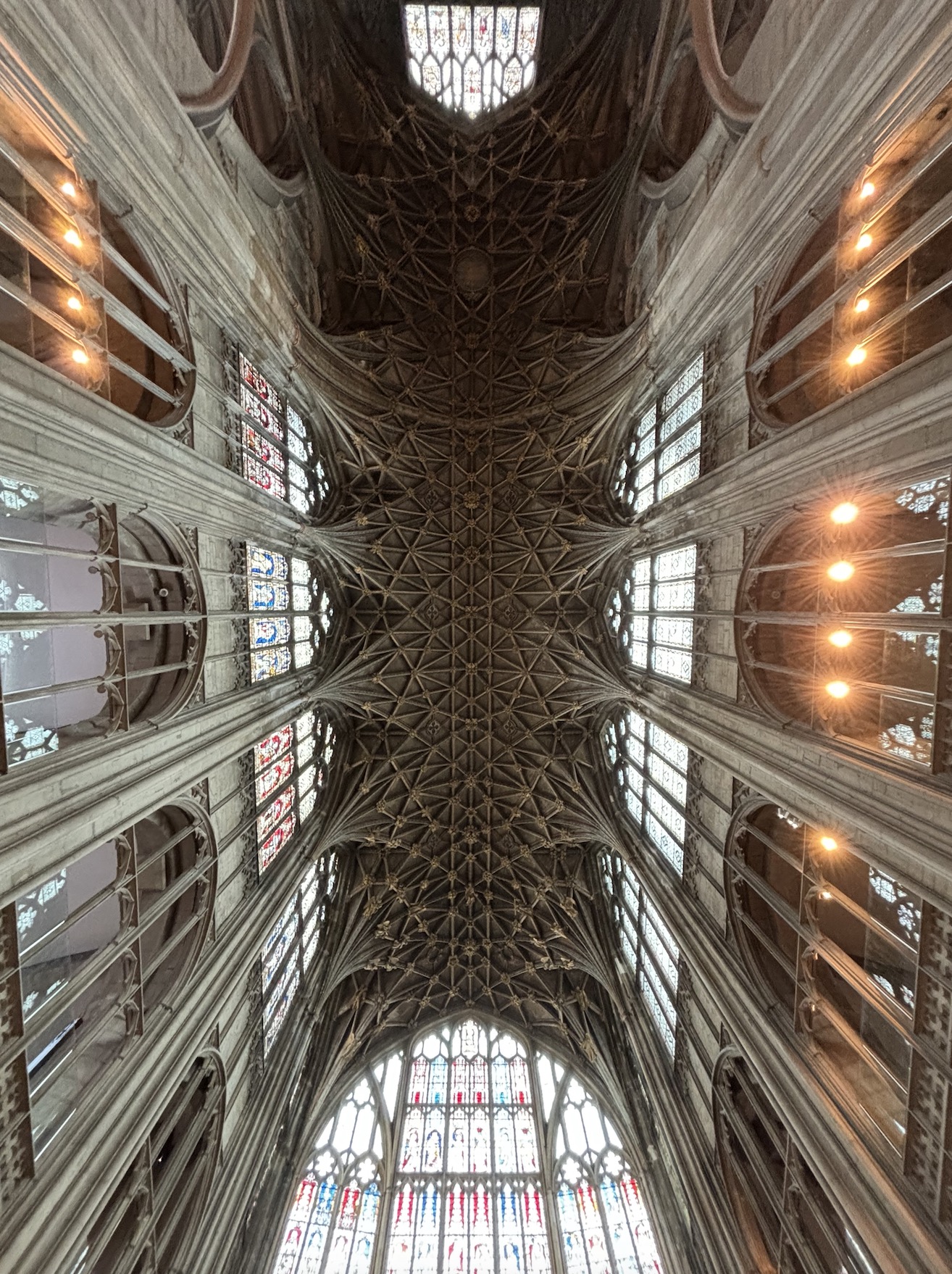
On your next visit, have a look in the mirror just below the High Altar – which gives you a remarkable view of the ceiling’s architecture!
Guildford – The Lady Chapel
Consecrated on 1 May 1964, the stunning painted ceiling was based on designs specified by Lady Prudence Maufe, wife of the architect and designer of the Cathedral, Sir Edward Maufe.
Prudence was an interior designer and Director at the London store Heals.

The Lady Chapel is dedicated to the Blessed Virgin Mary whose monogram is mounted above the entrance surmounted by her traditional five-pointed crown.
The Chapel contains the figure of the Madonna and Child, carved in lignum vitae by Douglas Stephen, the then manager of Barclays Bank, Chelsea.
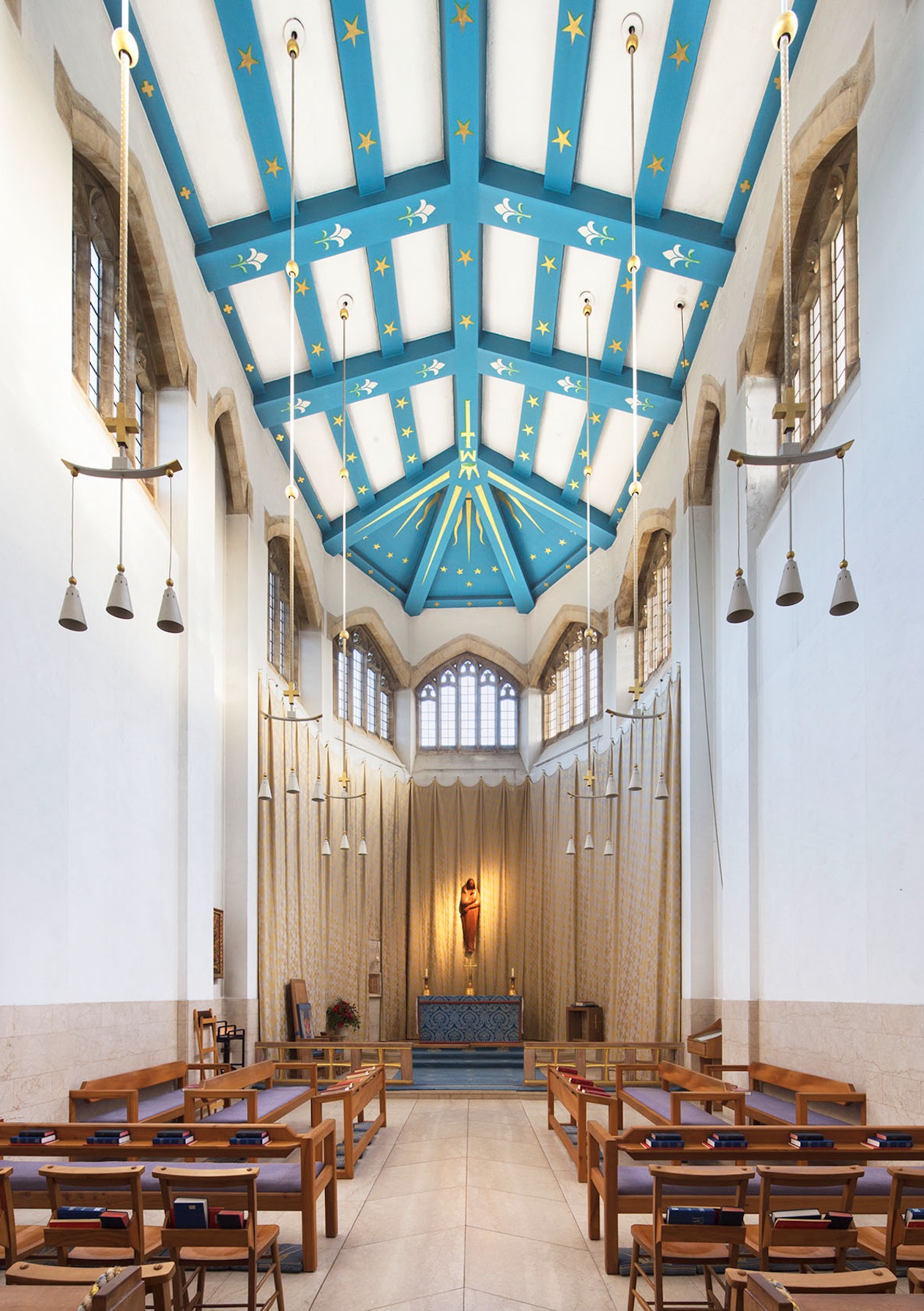
Hereford
The Stanbury Chapel (c 1475) is located in the North Choir Aisle of Hereford Cathedral.

It is a fine example of early Perpendicular architecture, with fan vaulting low enough to allow a clear view of its details and the intricacies of the heraldic carvings nearby.
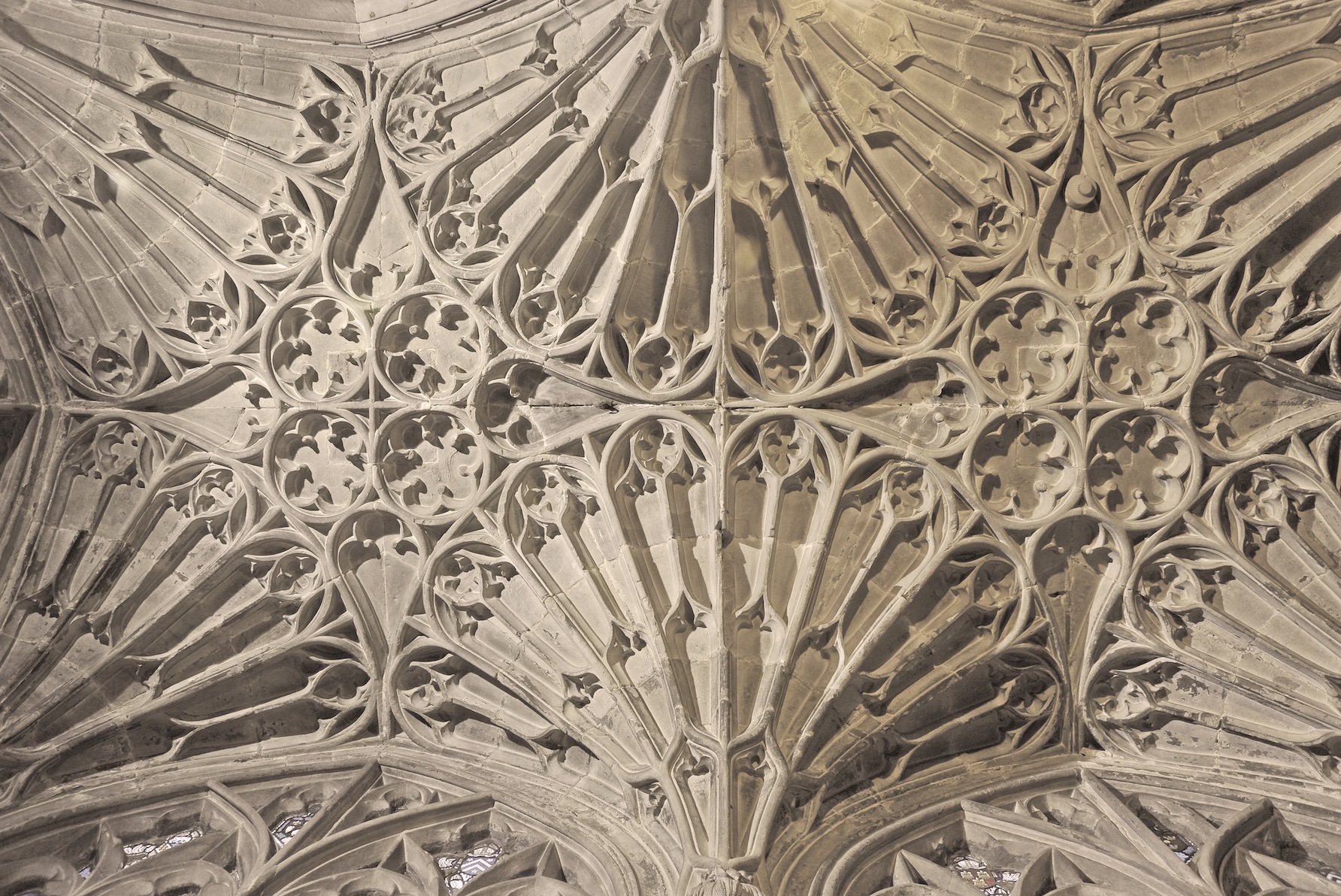
Originally all would have been brightly coloured.
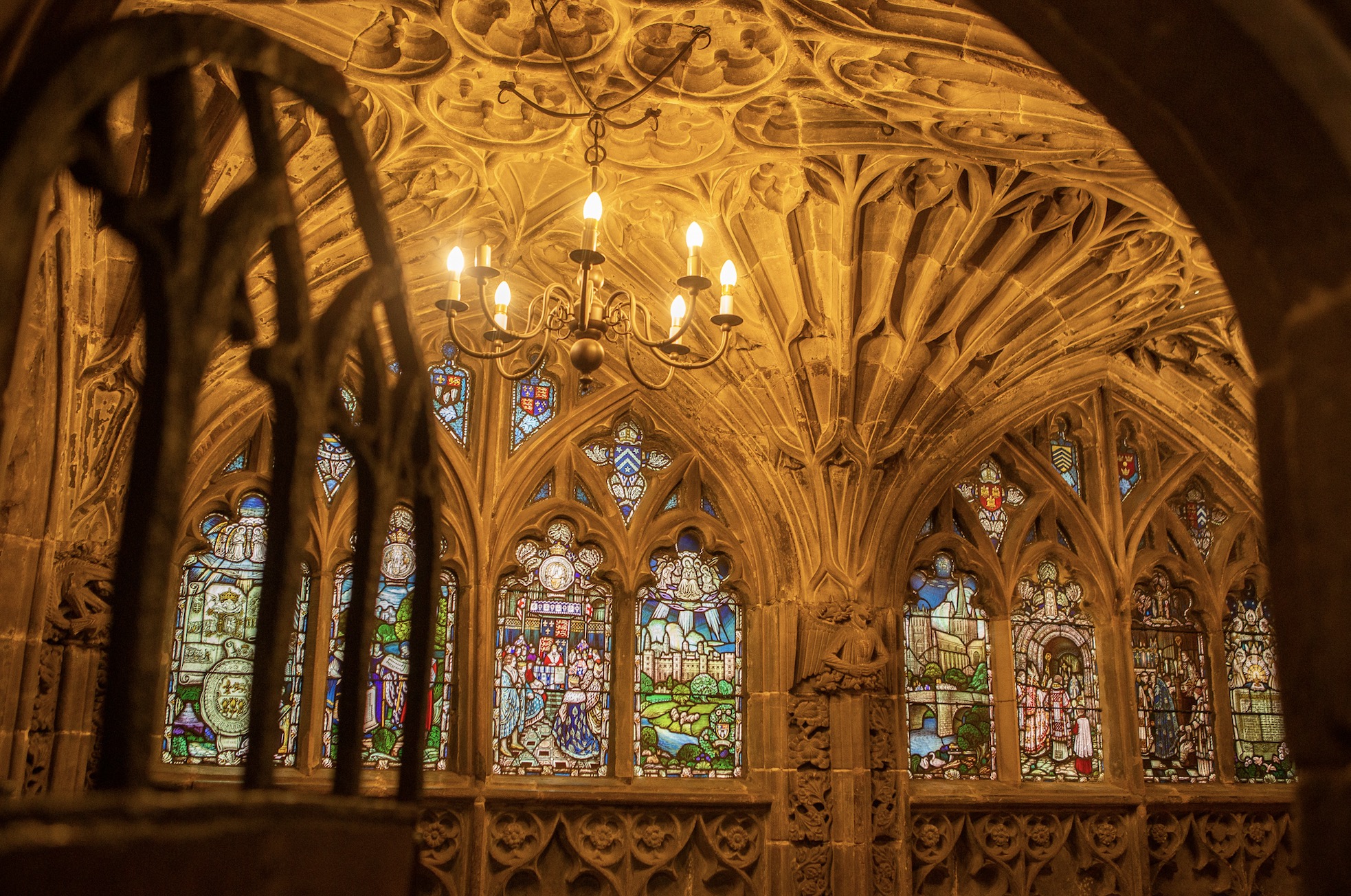
Photo credit : Gordon Taylor and Caroline Potter
Leicester
A recently painted firmament above the tomb of King Richard III in Leicester Cathedral. The stars have been replaced by cinquefoils – the logo of the city.
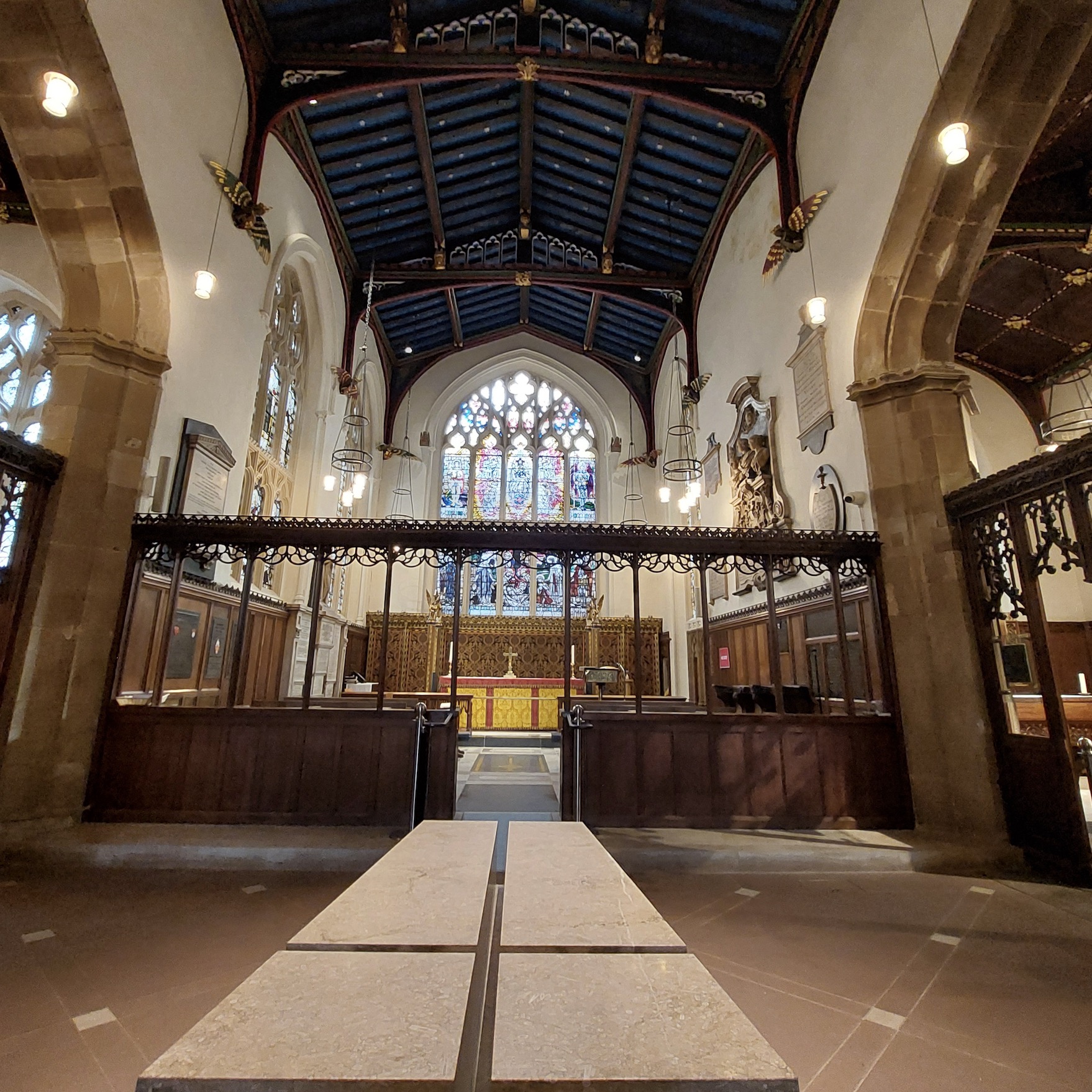
Lichfield
Looking back at Lichfield Cathedral’s Nave arcade pillars, you may notice that they seem to bow, just slightly, in fact at their centre they are 14 inches out from the top! Between 1785-1788 the architect, Wyatt, had around 500 tonnes of stonework removed from the central 5 bays of the nave ceiling and replaced with lath and plaster to reduce any further shifting.

Limerick
Saint Mary’s Cathedral, Limerick was founded in 1168 by the last King of Munster, Donal Mhor O’Brien. The site itself dates to the foundation of the city in 922, when it was established at the Thingmote for the first Viking settlers.

The oak in the ceiling may be traced to nearby Cratloe Woods (adjacent to Shannon Airport). Oak from the same forest was used in the roof beams in Westminster Hall and the Royal Palace in Amsterdam.
Lincoln
The vault of St Hugh’s Choir in Lincoln Cathedral is known as the ‘crazy vault’.

The 13th century ceiling was designed by Geoffrey de Noiers, and features asymmetrical ribbing , which is in fact a clever way of distributing weight and pressure on the masonry.
Liverpool
The vaulted ceiling of the countries largest Cathedral in Liverpool invites visitors to look up and take in the grand architecture of the building.
With a height of 331 feet, Liverpool Cathedral is one of the world’s tallest non-spire church buildings and the fourth tallest structure in Liverpool.

Manchester
Visitors to Manchester Cathedral are able to view a host of angels holding 15th century musical instruments lining the ceiling of the Nave. The carved wooden angels with their golden instruments are believed to have been gifted to the Cathedral by Lady Margaret Beaufort, mother of King Henry VII.
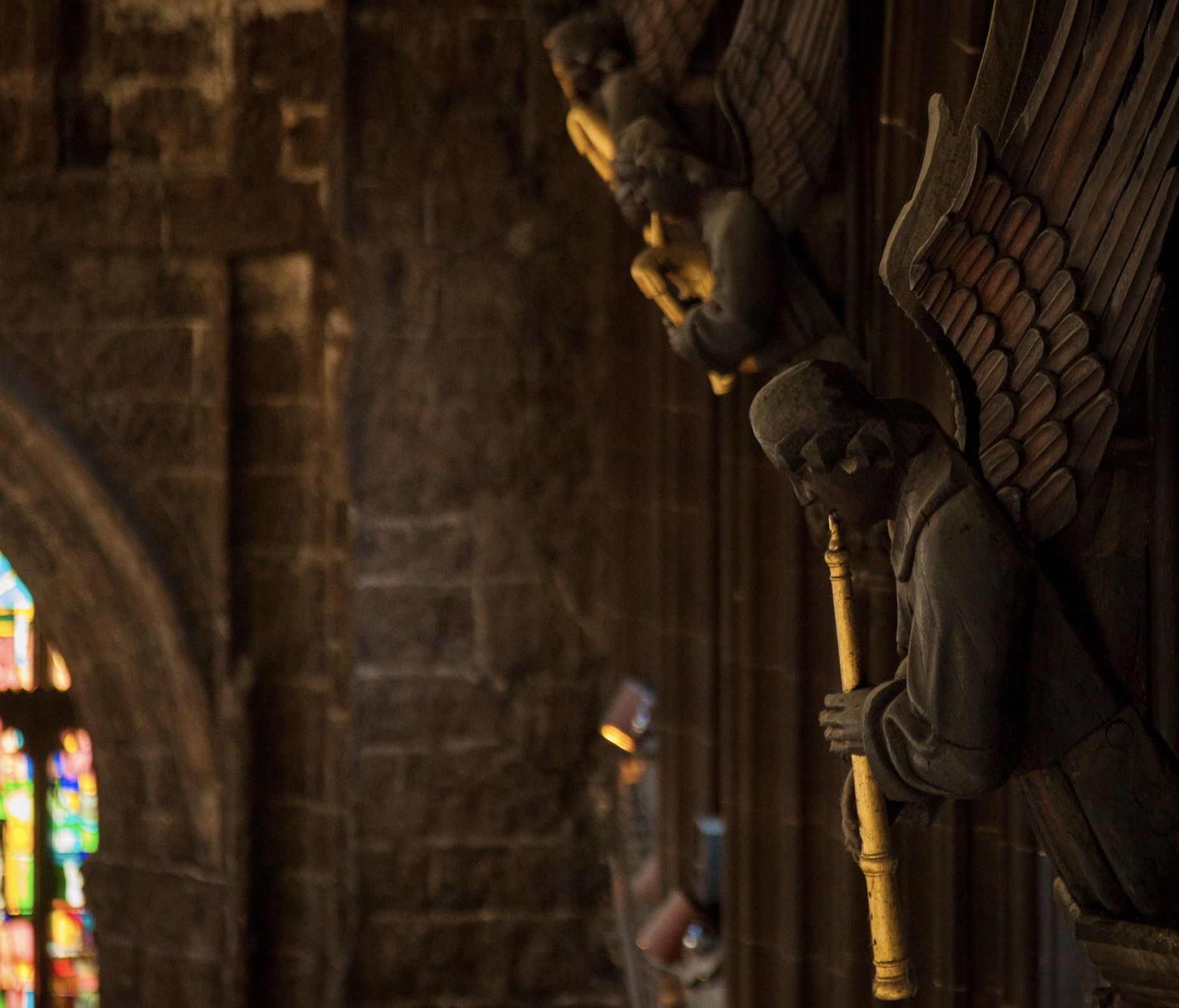
Angels on the north side have wind instruments such a trumpet or clarion, bagpipe and a shawm or oboe. Angels on the south side play strings such a lute, hurdy gurdy and Dulcimer.
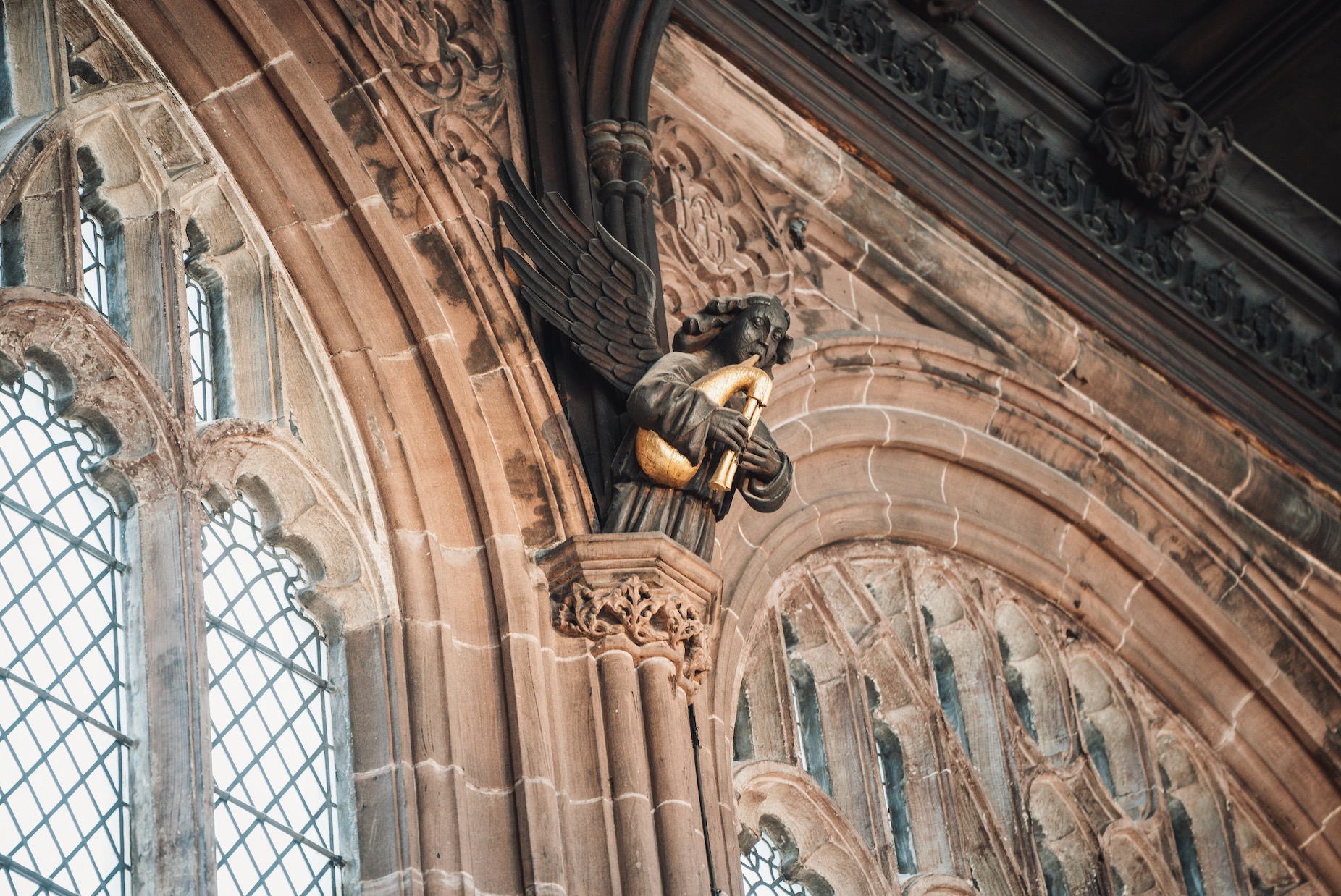
Newcastle
The Arts and Crafts-style ceiling of Café 16 in Newcastle Cathedral’s refectory was designed by the architect W.H. Wood when the Cathedral was extended in 1926.
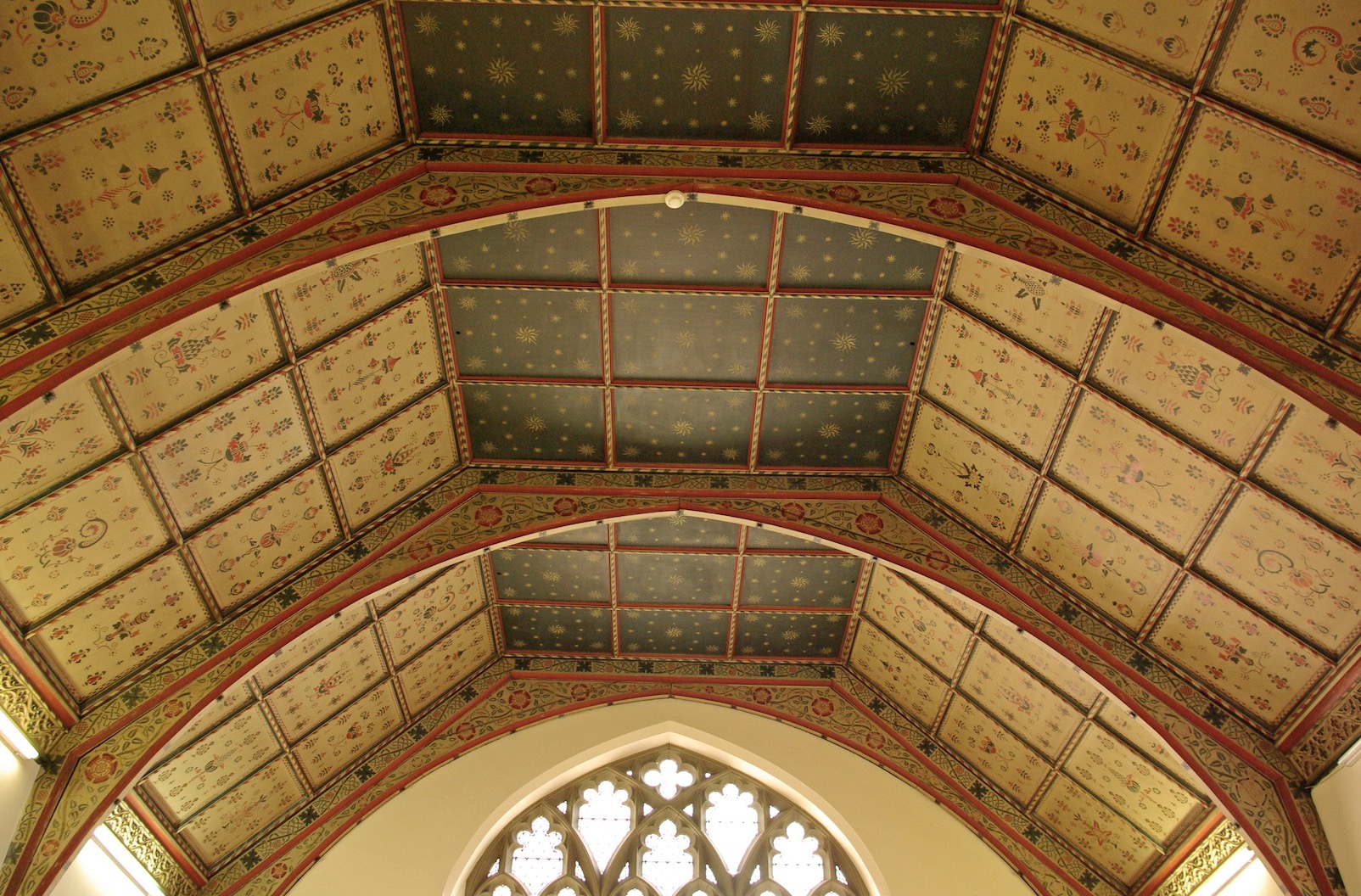
Today, a team of prison leavers staff the café, led, trained and mentored by the Oswin Project.

The café is supplied with fresh produce from the charity’s bakery in HMP Northumberland, where trained bakers allow prisoners to learn new skills and find a new direction on release.
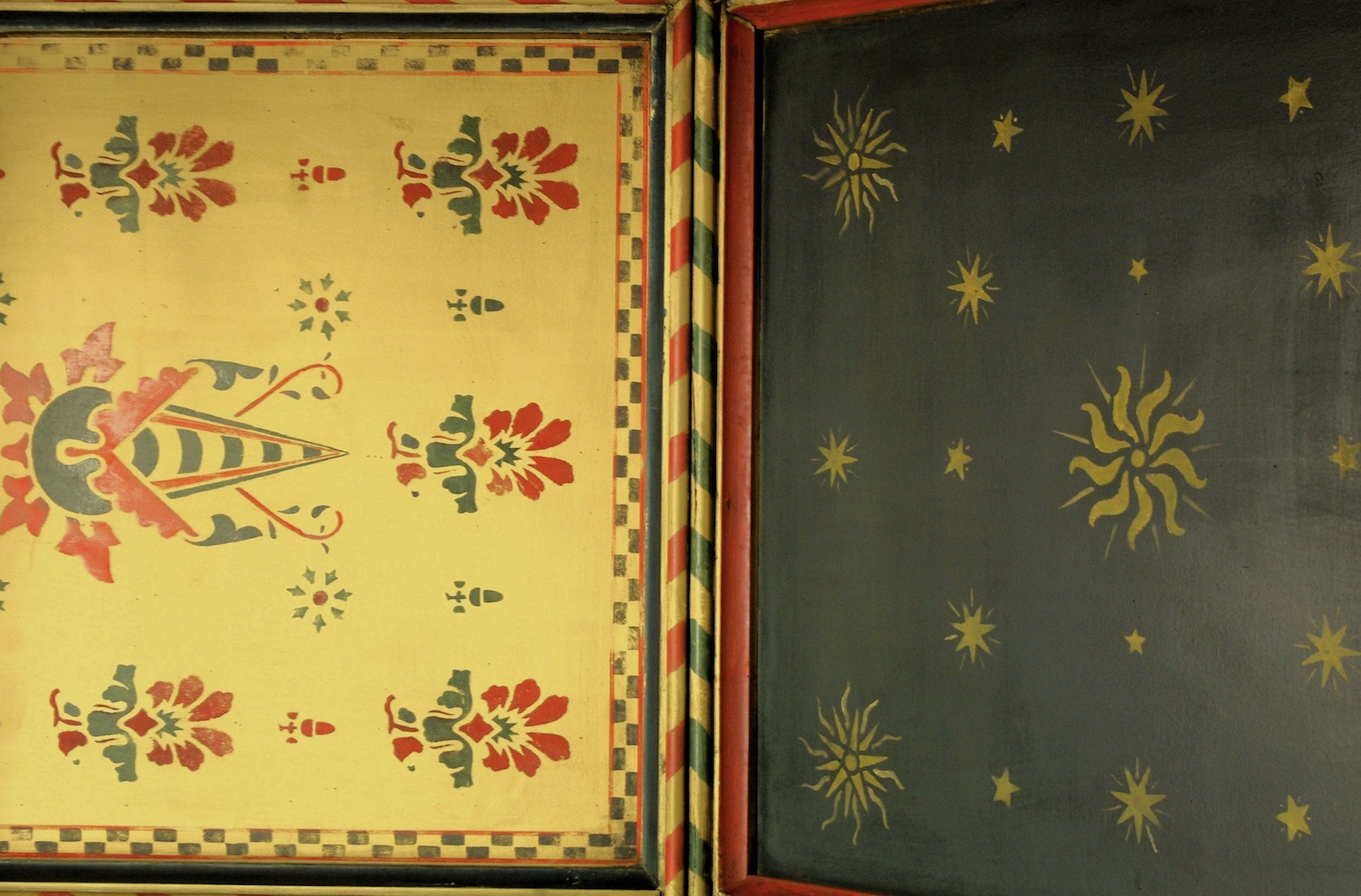
Newport
The nave ceiling in Newport Cathedral. Constructed of wood, it dates from around 1450-60 and is very similar construction to the Newport Ship, being roughly the same length.
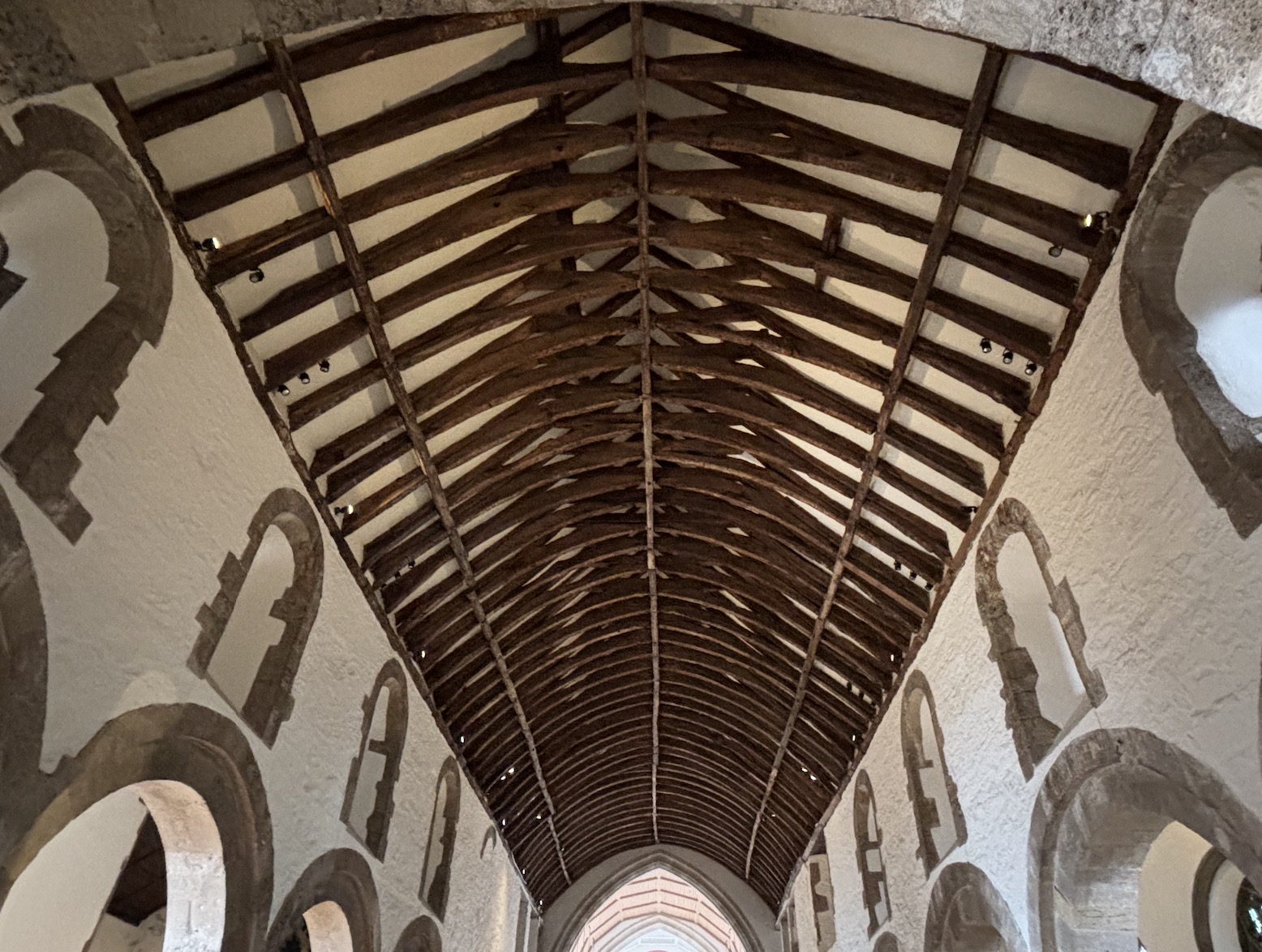
The ship was found in mud in the banks of the River Usk in June 2002 during construction of the Riverfront Theatre. It is a significant find. The nave dates from 11th century.
Norwich
Hundreds of medieval roof bosses decorate the lofty heights of Norwich Cathedral and its Cloister, and this treasure trove of centuries-old carvings is the biggest collection of its kind in the whole world.
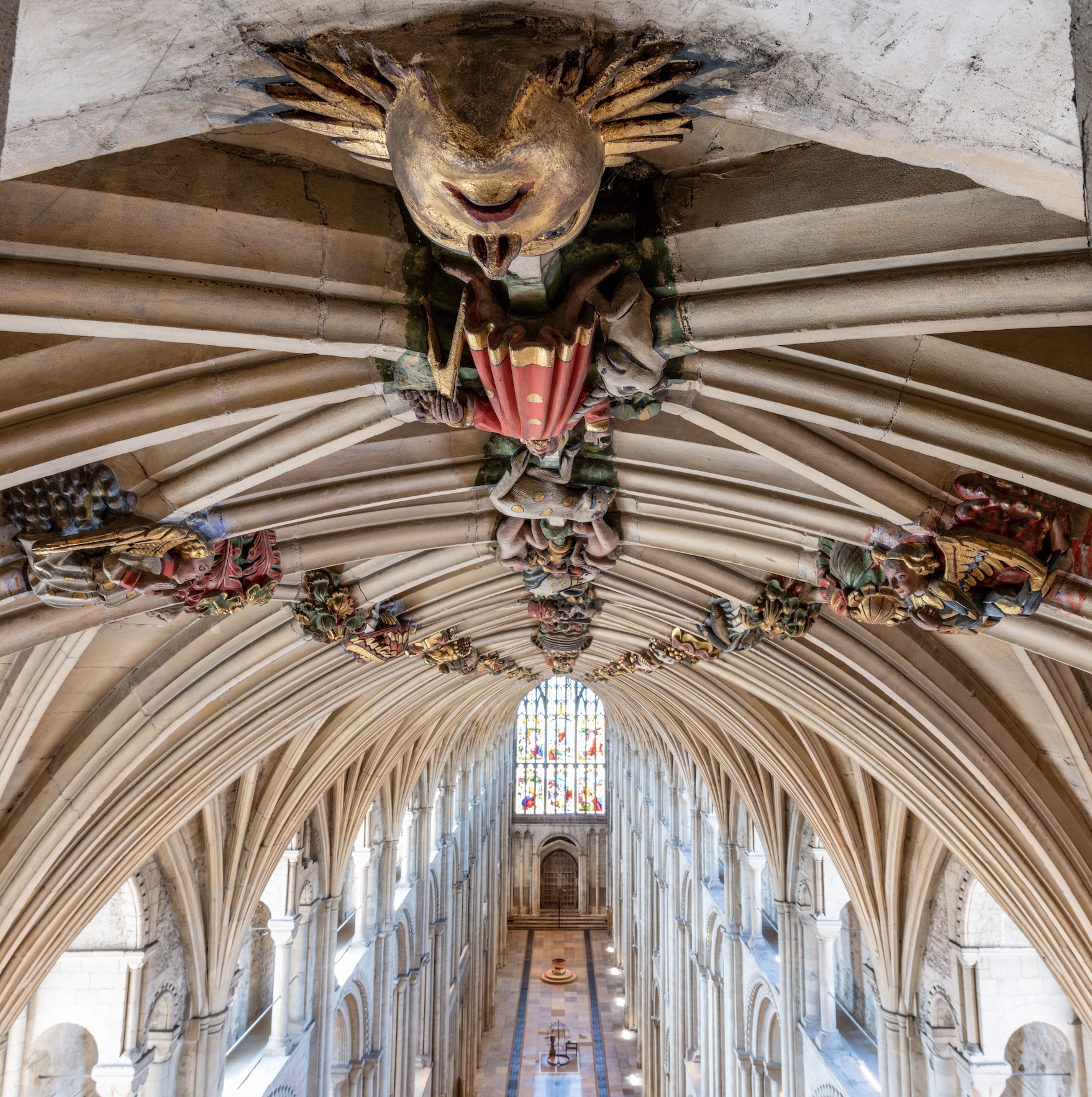
The most impressive roof bosses can be found in the Nave, where they tell the stories of the Bible’s New and Old Testaments from Creation to the Last Judgement, meanwhile there are many more in the Cloister, where the famous Green Man bosses can be seen.

Peterborough
The painted wood ceiling in the nave was completed around 1240.
The 12th century designers of this space certainly knew how to create the ‘wow factor’.
This is certainly an unforgettable space and it is the only one of its kind in Britain and one of only four in Europe. Although the ceiling has been repainted or restored twice, it still follows the original design.
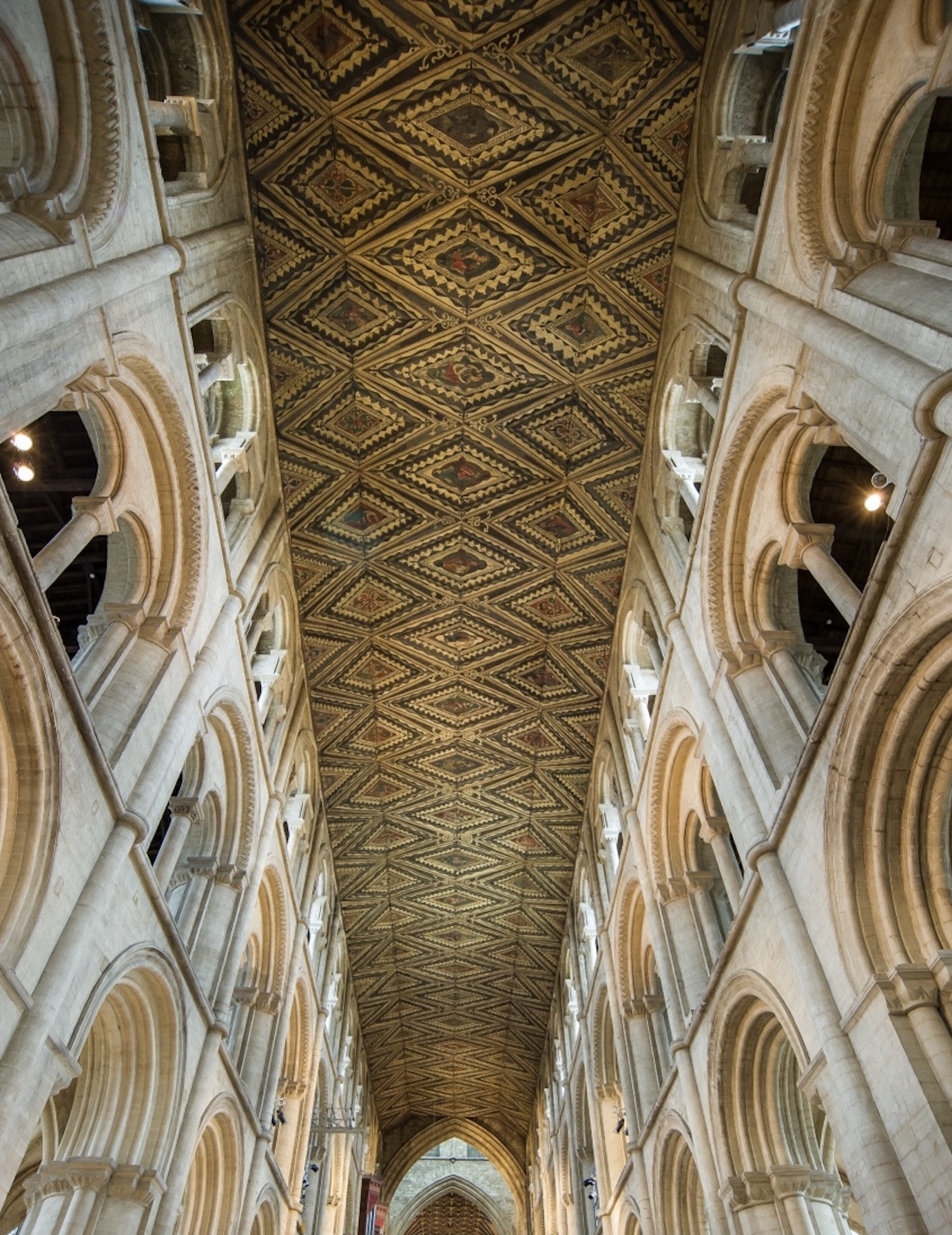
From earliest times, the nave of a cathedral or church has been a public space where business and community life are conducted. It is no different today, and the Nave has been the venue not only for the congregation worshipping on a Sunday, but also for awards ceremonies, formal dinners, concerts, lectures and product launches.
Portsmouth
Below, the roof of the St Thomas Chapel, the most ancient part of this cathedral was built in 1180 as one of the first chapels dedicated to Thomas Becket after his martyrdom. Daily worship has taken place here every since.

The west end of the Nave of Portsmouth Cathedral (below) was completed in 1991 and then the addition of these stupendous en chamade trumpets in 2017.

Named Trompette de Maris or Trumpets of The Sea, they are one of the many aspects of Portsmouth’s iconic building that lead to its designation as Cathedral of The Sea.

Prayers are held daily for those who navigate the waters nearby, for all The Royal Navy and Merchant Navy as well as those who work in fishing, container ships and ferries.
Ripon
When George Gilbert Scott restored the ceiling of the quire at Ripon in the 1860s, he incorporated 13 of the earlier ceiling bosses. It is thought that most of these may well be medieval in origin, dating possibly from as early as the 1180s or as late as the 1480s. Only one is known to be from the 1860s.

Some of the features are enigmatic, but three clearly represent bishops giving a blessing All the bosses are gilded, and some of the figures are as much as 5 feet in height.
Most dramatic of all is the expulsion of Adam and Eve from the Garden of Eden, a garden with a magnificent gateway.
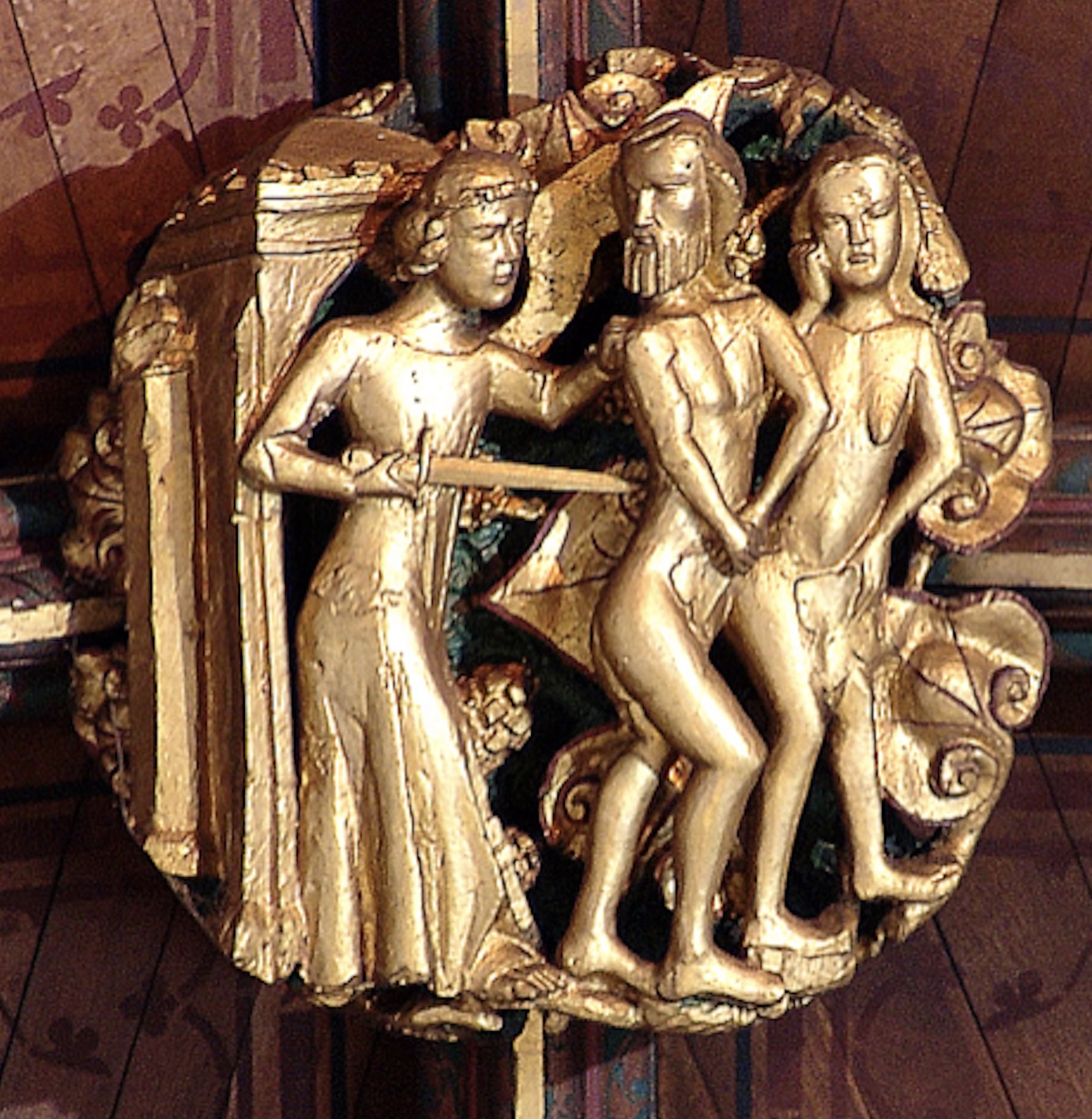
Rochester – Green Men
These carved wooden Green Men can be found in the Cathedral crossing near the Organ. They were created in the 1840s and were repainted in 1992. Green Men are believed to originally be a pagan fertility symbol but were adopted by the Medieval church. It is believed they represent God’s creation and Christ’s resurrection.
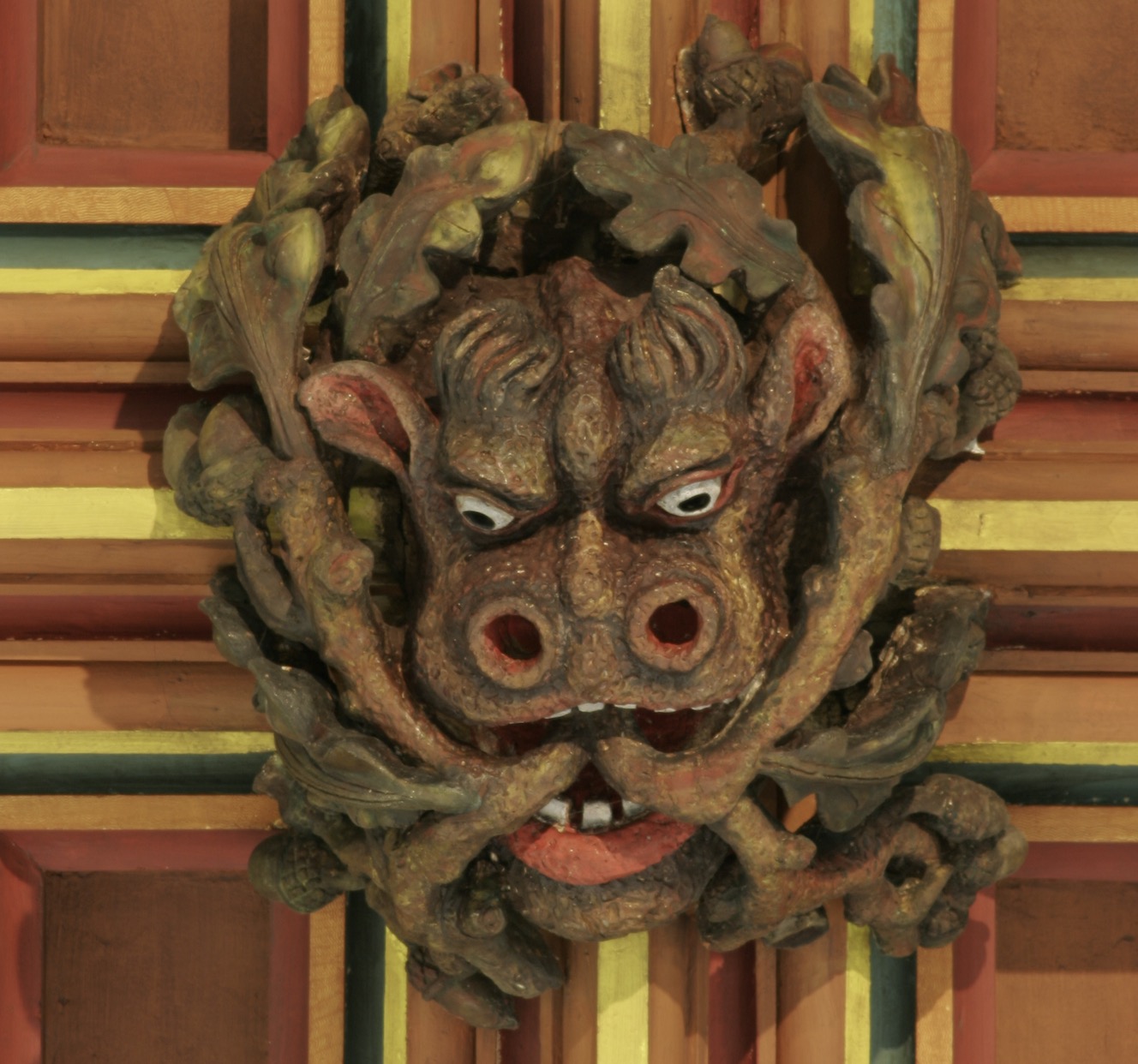
Rochester – Crypt ceiling paintings
If you look carefully at the ceiling in the Crypt of Rochester Cathedral you can discover traces of paintings dating back to the 1290s. In Medieval times Rochester Cathedral would have been covered in paintings and colour. They have discovered traces of paint all over the Cathedral.
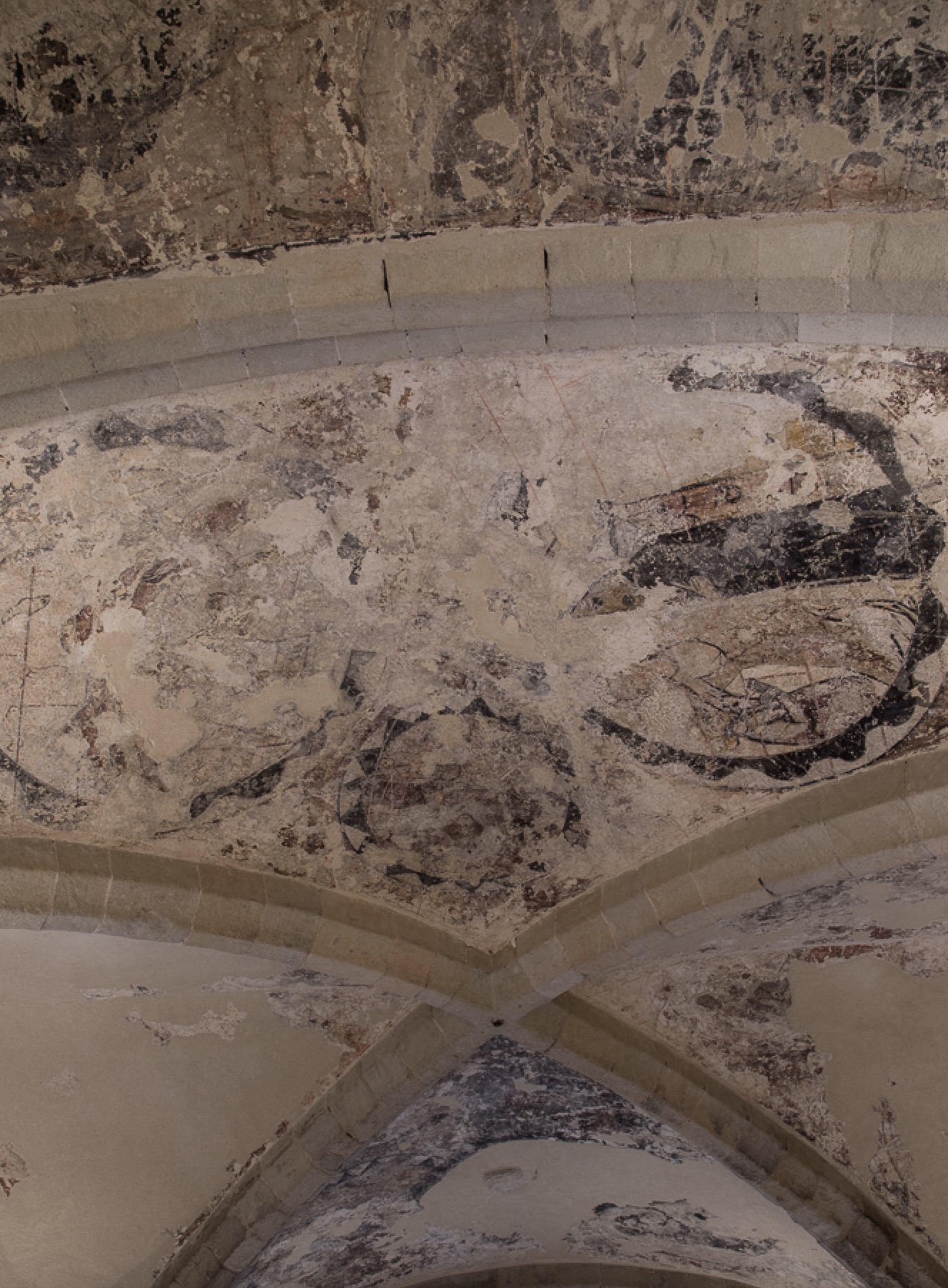
Salisbury
Salisbury Cathedral is a great example of Early English Gothic architecture. Its ceilings are testimony to this and have many Early Gothic features. The spectacular ceilings of the Chapter House, which houses the Magna Carta, are particularly significant and reveal traces of paintings which are imitations of originals from the 1200s.

The Chapter House is home to one of only four surviving original Magna Carta documents from 1215, and is visited by people from all over the world. When visitors first enter the Chapter House, they arrive at a vestibule with a vault (also known as an arched ceiling). Foliage has been painted on the vault and can be seen at the points where the arches meet. The foliage is incredibly detailed, though some of its colour has been lost.

In the main Chapter House, there are more traces of foliage painted on the ceiling. Colourful foliage surrounded by dark red is painted where the webs of the vault meet. Some of the medieval colour has been retained although a lot of this has been done through restoration. These beautiful decorations remain incredible features of the Cathedral’s Chapter House.
Sheffield
Old St George’s Chapel is located in an area of the cathedral which formed part of the 1930s Sir Charles Nicholson extension. World War II broke out and these plans were curtailed. OSGC was originally intended to be the Regimental Chapel of the York and Lancaster Regiment and in the 1960s it was decided to dedicated the unfinished chancel to the York and Lancaster Regiment instead.
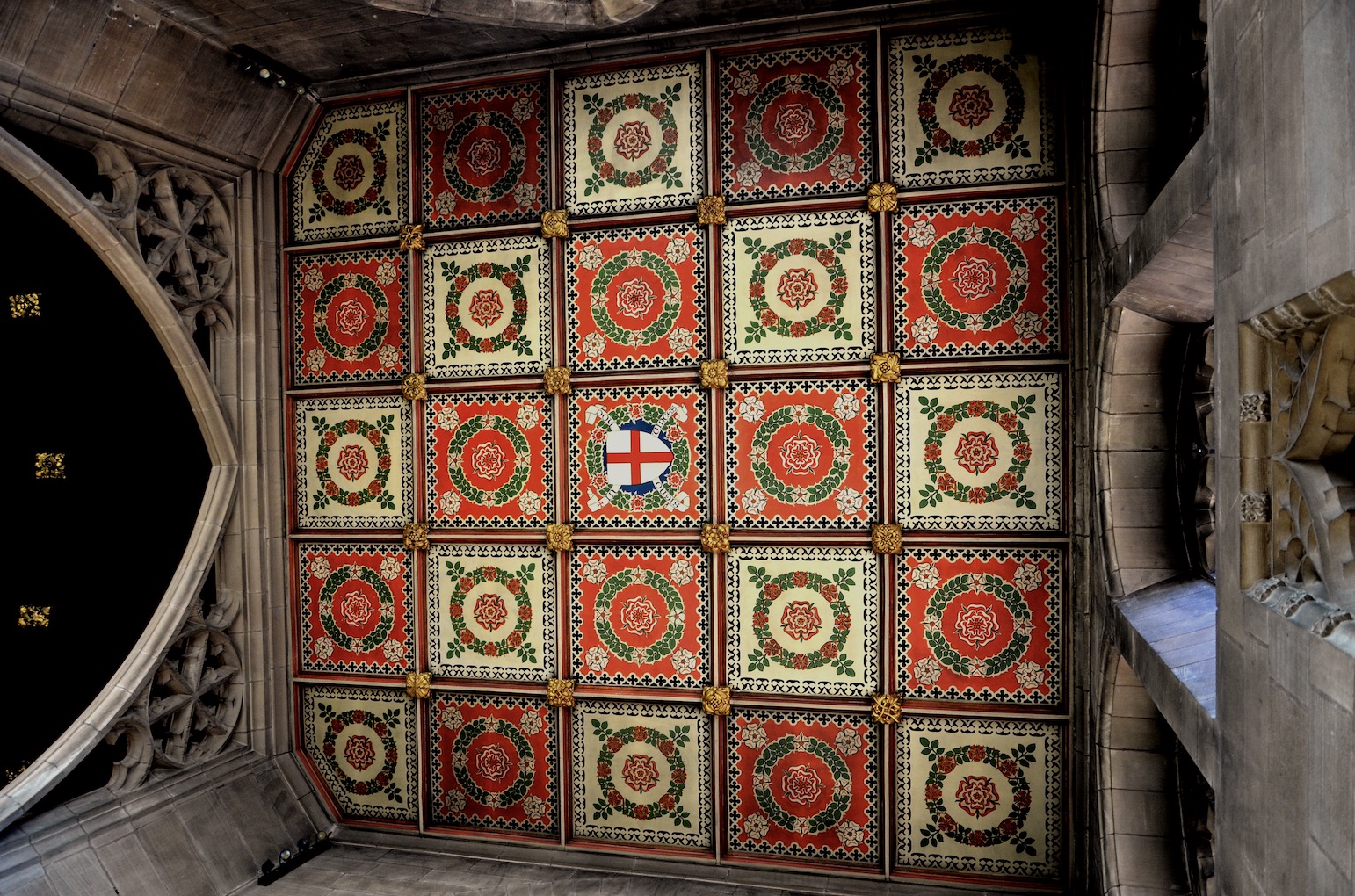
The ceiling of Old St George’s Chapel is decorated with white and red roses of the York and Lancaster Regiment. The Regiment was formed in 1758 and disbanded in 1968; the 12th Battalion of the Regiment, the Sheffield City Battalion, was established in 1914 and included the ‘Sheffield Pals’. The battalion served at the Battle of the Somme, where many of its members lost their lives on the first day, 1 July 1916.

On June 10 1944, the Hallamshire Battalion of the York and Lancaster Regiment landed on Sword Beach, Normandy, and fought German infantry and Panzer tank divisions at Fortenay on 25 June.
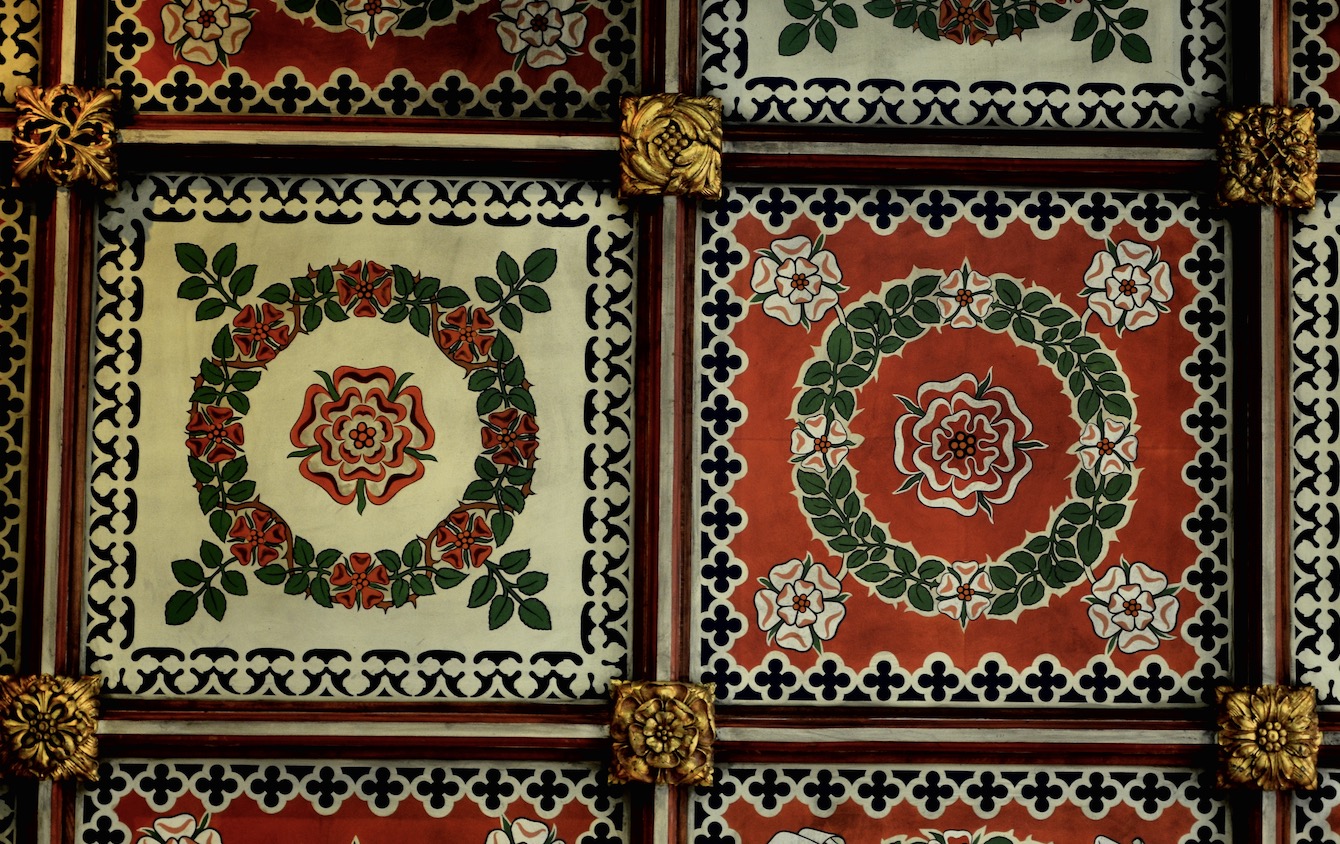
Hanging from the ceiling in (new) St George’s Chapel are the regimental colours of the York and Lancaster Regiment. These are all seen battle including dating back to the American War of Independence.
Southwark
When you enter the Nave you are greeted soaring arches, a dramatic ceiling, and timeless stone. However, it is actually a nineteenth century reconstruction, designed by Sir Arthur Bloomfield and completed in 1897.

What you see today replaced an elaborate fifteenth century wooden ceiling which had decayed, leaving much of the Nave roofless for over 50 years.
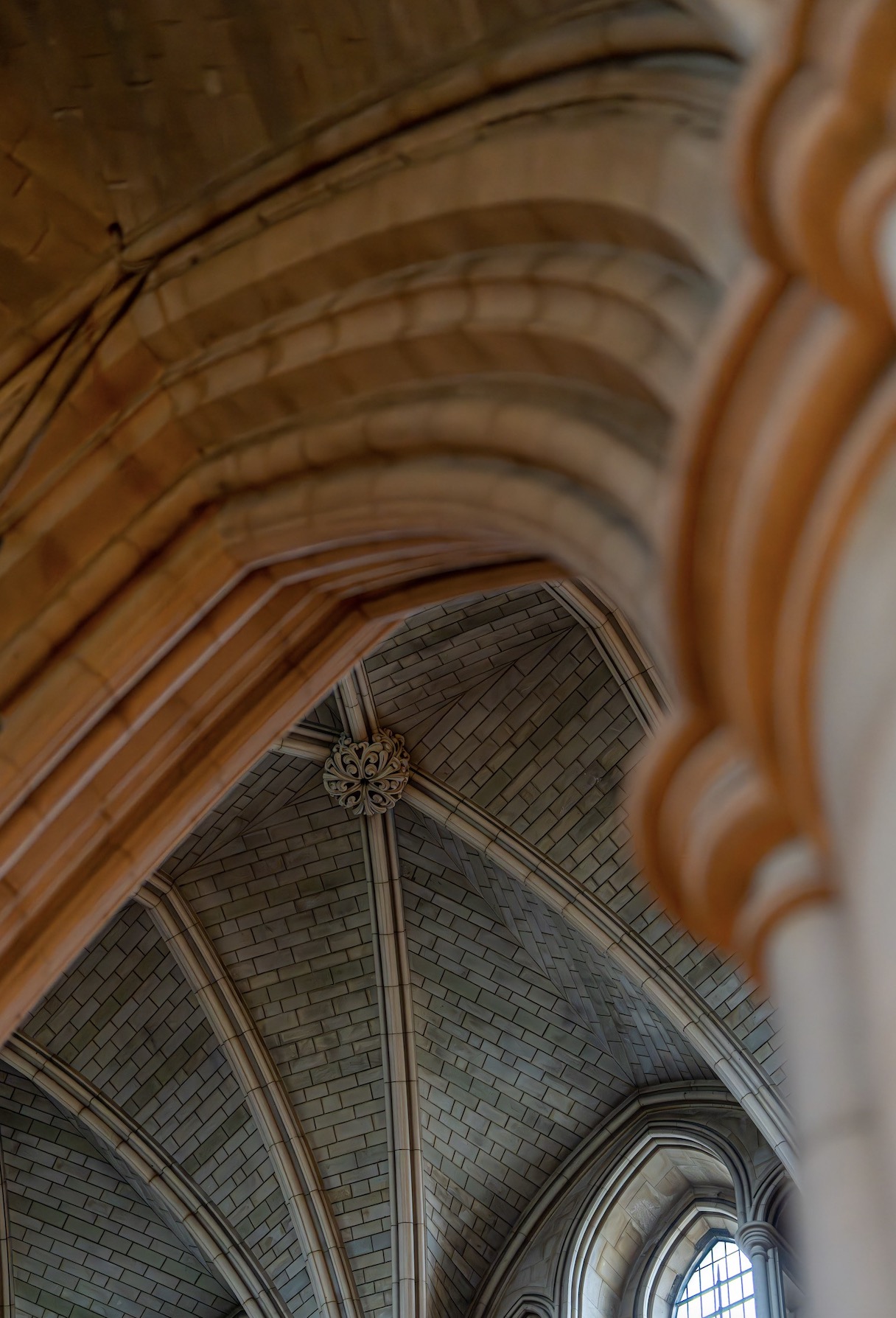
Southwell Minster
Southwell Minster’s Chapter House ceiling dates back to the 13th century and is the only stone-vaulted Chapter House ceiling in the country without a supporting central column – what incredible skill and precision from the architects and stonemasons of the time!

Southwell Minster’s Chapter House is also home to ‘The Leaves of Southwell’, voted the UK’s #1 Cathedral Treasure last year!

Photo credit : Andy Marshall @fotofacade.
St Albans – Presbytery ceiling
Abbot John of Wheathampstead redecorated the presbytery ceiling. Originally having been a painted design of foliage, he had it emblazoned with numerous representations of an Eagle and Lamb, symbols of the two saints he saw as his patrons: John the Evangelist and John the Baptist.

As is sometimes told to visitors on tours, if you can read the symbols then you will see the ceiling repeats one word over and over again “John, John, John…..”
St Albans – Tower Ceiling
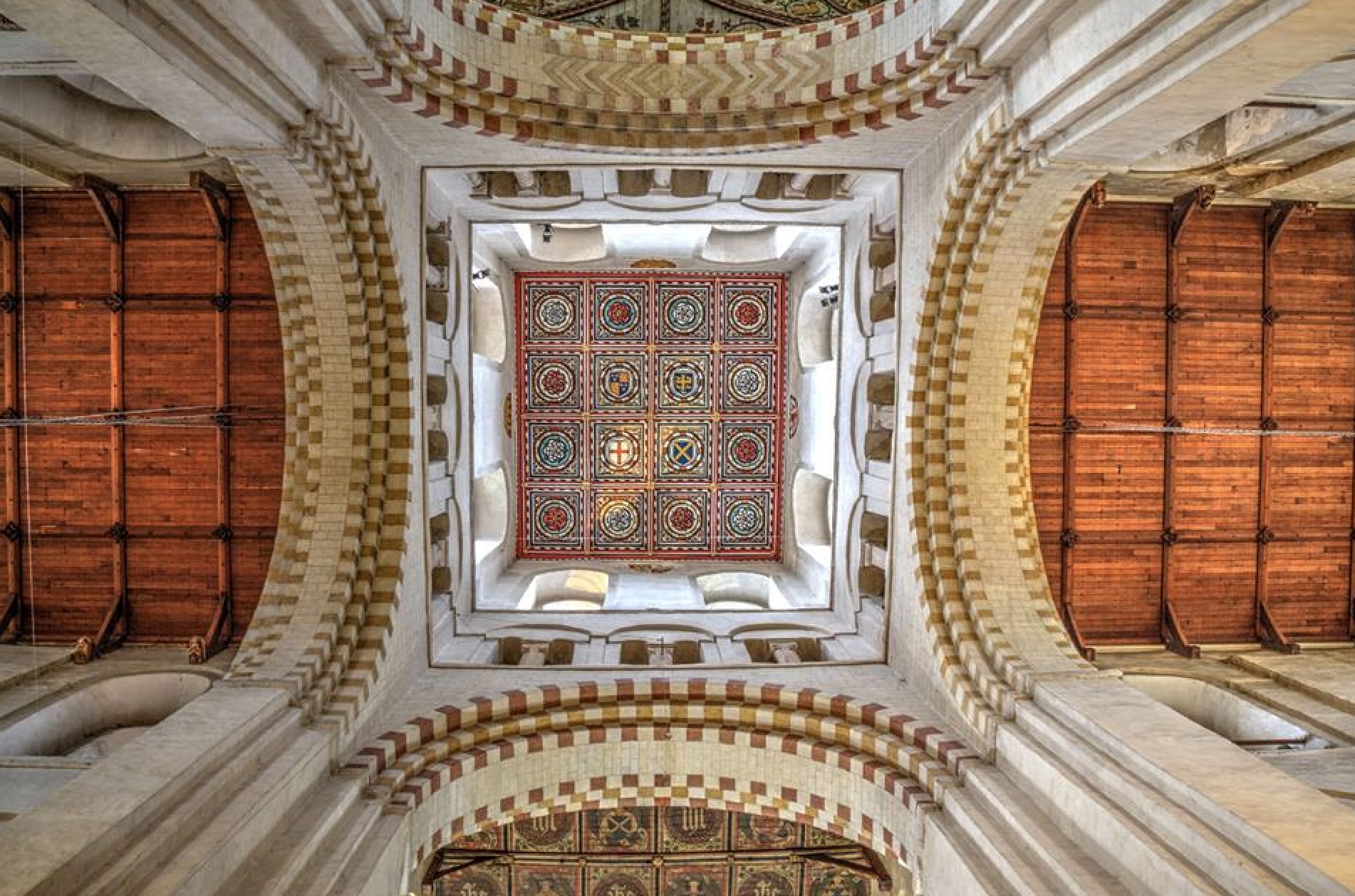
There was an occasion recently when there was cause for a big old bell to be winched up.
A brave photographer lay on the floor underneath taking a picture of the bell from below as it was ascending, when suddenly the winch slipped a few inches and it felt like the whole building shuddered.
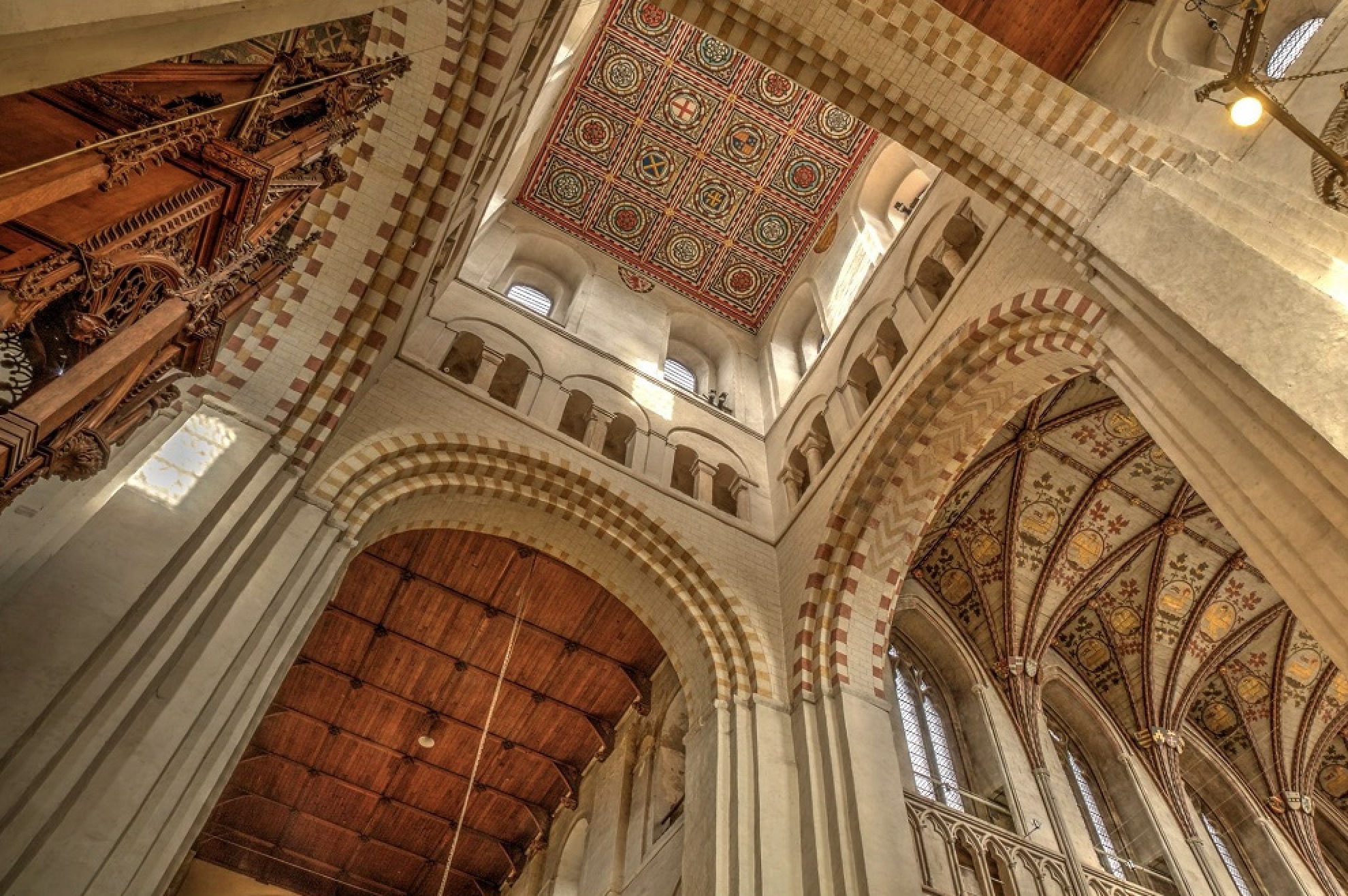
It was reported that whilst the photographer turned whiter than a sheet.
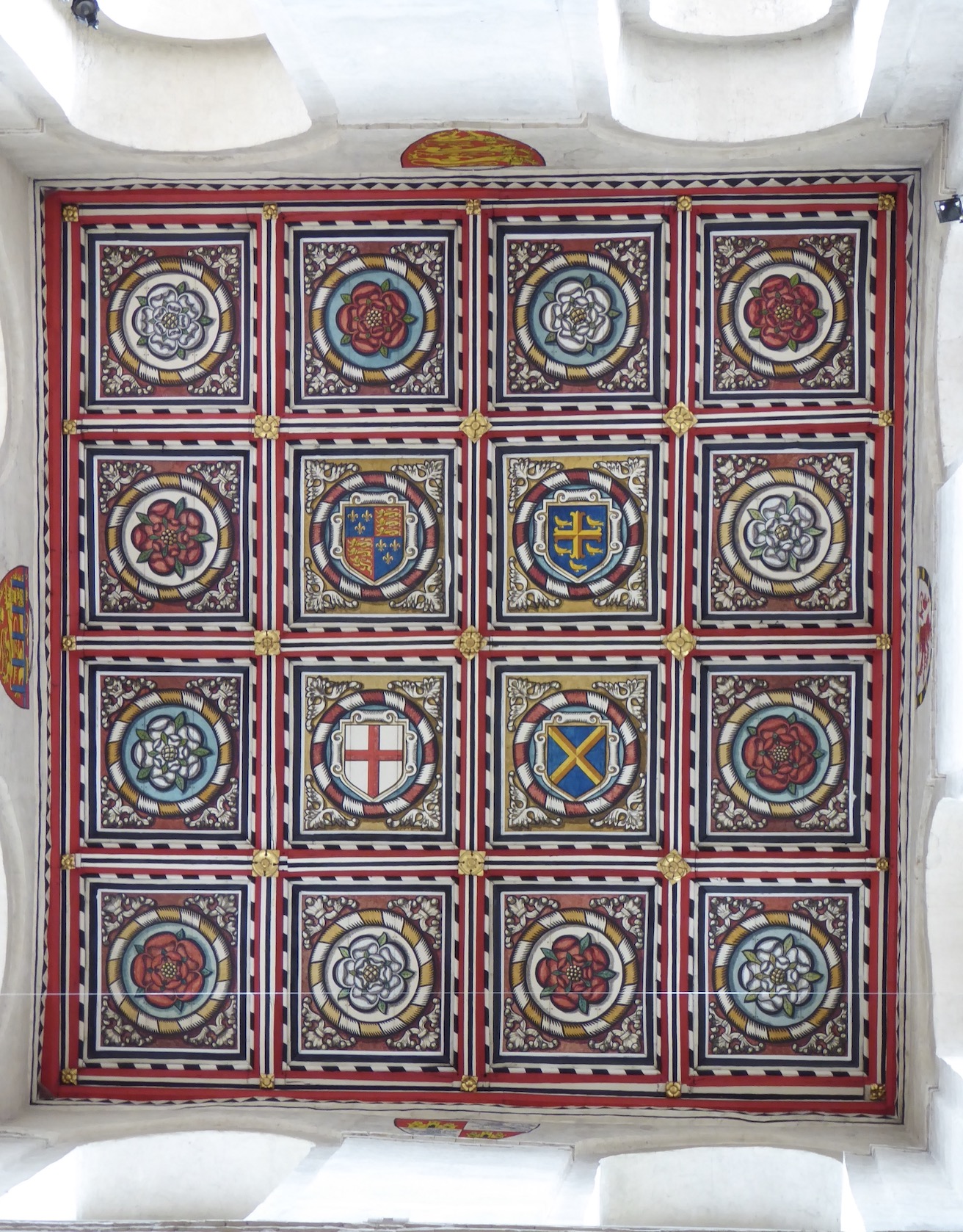
St Davids
The painted ceiling of the tower lantern at St Davids Cathedral.
The tower has had several rebuilds since the 12th century. The original tower collapsed in 1220 although it survived an earthquake in 1247.
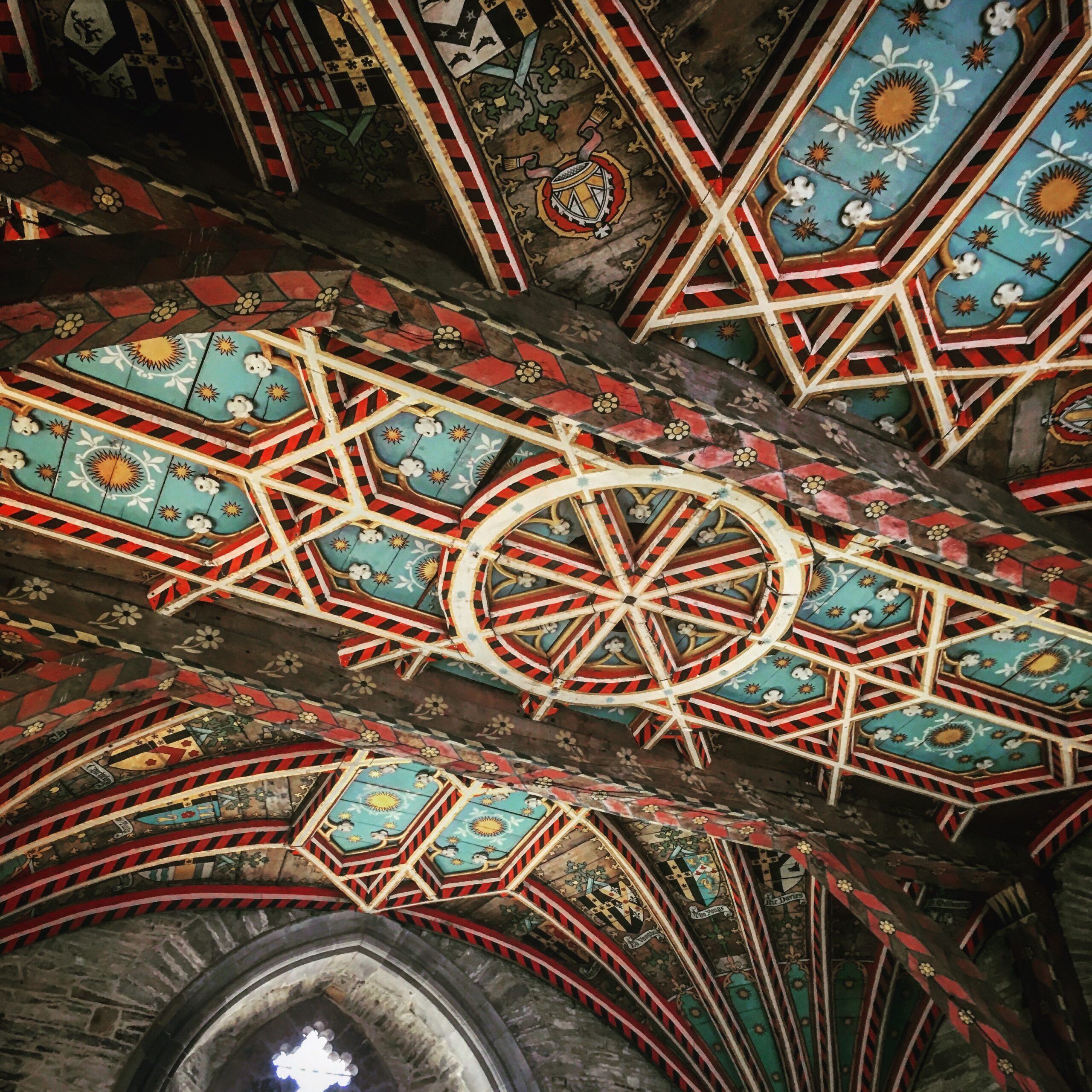
Structurally shaky from this event, it still managed to carry the weight of an additional upper storey added in the 16th century and the destruction wrought on it by Parliamentarian dragoons in 1648, when the troops made a large breach in the south face of the tower to remove at least one of the bells.
The Tower was in a fragile state at the time of George Gilbert Scott’s extensive restoration in the 1860s which included, in his own words, “little short of the reconstruction of its two western piers”.
Scott also raised the ceiling up one tier of the tower. This brought in the light from the lantern windows and enabled this striking ceiling to be seen much more clearly.
The painted ceiling dates from this restoration, and displays a wealth of coats of arms of previous bishops of St Davids alongside an approximation of the medieval decoration.
St Edmundsbury – Vaulted Ceiling
The ceilings of St Edmundsbury Cathedral are a burst of colour.
The crowning glory of these is the Cathedral tower’s vaulted ceiling, which was added in 2010. The design drew upon the vaulted ceiling at King’s College, Cambridge, which was designed by John Wastell, who also helped construct the sixteenth-century portions of St Edmundsbury Cathedral.
The gold ‘trees’ on the ceiling are one of the characteristic signatures which Wastell used on many of his works. The colours are inspired by those used in the Bury Bible, a giant illustrated Bible written by Master Hugo at Bury St Edmunds Abbey between 1121 and 1148.

The vaulted ceiling was designed by Henry Freeland and constructed by Taylor Made Joinery, a local firm, who applied modern technology to a medieval architectural problem, carrying out a ‘cloud survey’ to measure the inside of the tower.
This consisted of collecting 29 million digital reference points with which to produce a 3D model and took just one day to carry out. Each and every one of the 3,000 pieces of frame, panels, centrepiece, mouldings and tracery were put together to ensure that they fitted perfectly before being dismantled and brought to the Cathedral. The ceiling was hoisted up in sections and put together like a giant jigsaw before being painted by decorators Hare and Humphries.
One of the painters had been an apprentice working on the Cathedral extension in the 1960’s and had painted one of the nature-themed ceilings over 40 years previously. The gilding used 9,000 sheets of 25 carat gold leaf.
The Rev’d Canon Matthew Vernon, the Canon Pastor and Sub-Dean at St Edmundsbury Cathedral, highlighted a multi-faith tradition of putting deliberate mistakes in art, following the premise that ‘only God is perfect’. With this suggestion made, the vaulted ceiling has a deliberate (but hard to spot) painting mistake!
Photo credit : Tom Soper
St Paul’s
Looking up at the inside of the most famous dome in the UK!

When St Paul’s Cathedral was first completed in 1710, the dome interior was left undecorated. Between 1716 and 1719, artist Sir James Thornhill painted murals of the life of St Paul in ‘grisaille’, meaning entirely in shades of grey to create the illusion of sculpture when viewed from below. Today, the ceiling murals can be viewed from the ground, or from the Whispering Gallery some 30m (or 257 steps!) above the Cathedral floor, with the added benefit of a beautiful new lighting scheme.
Photo credit : Graham Lacdao (On Instagram, @glacdao).
Truro
The central tower of Truro Cathedral (as you stand in the middle of the cathedral and look up).
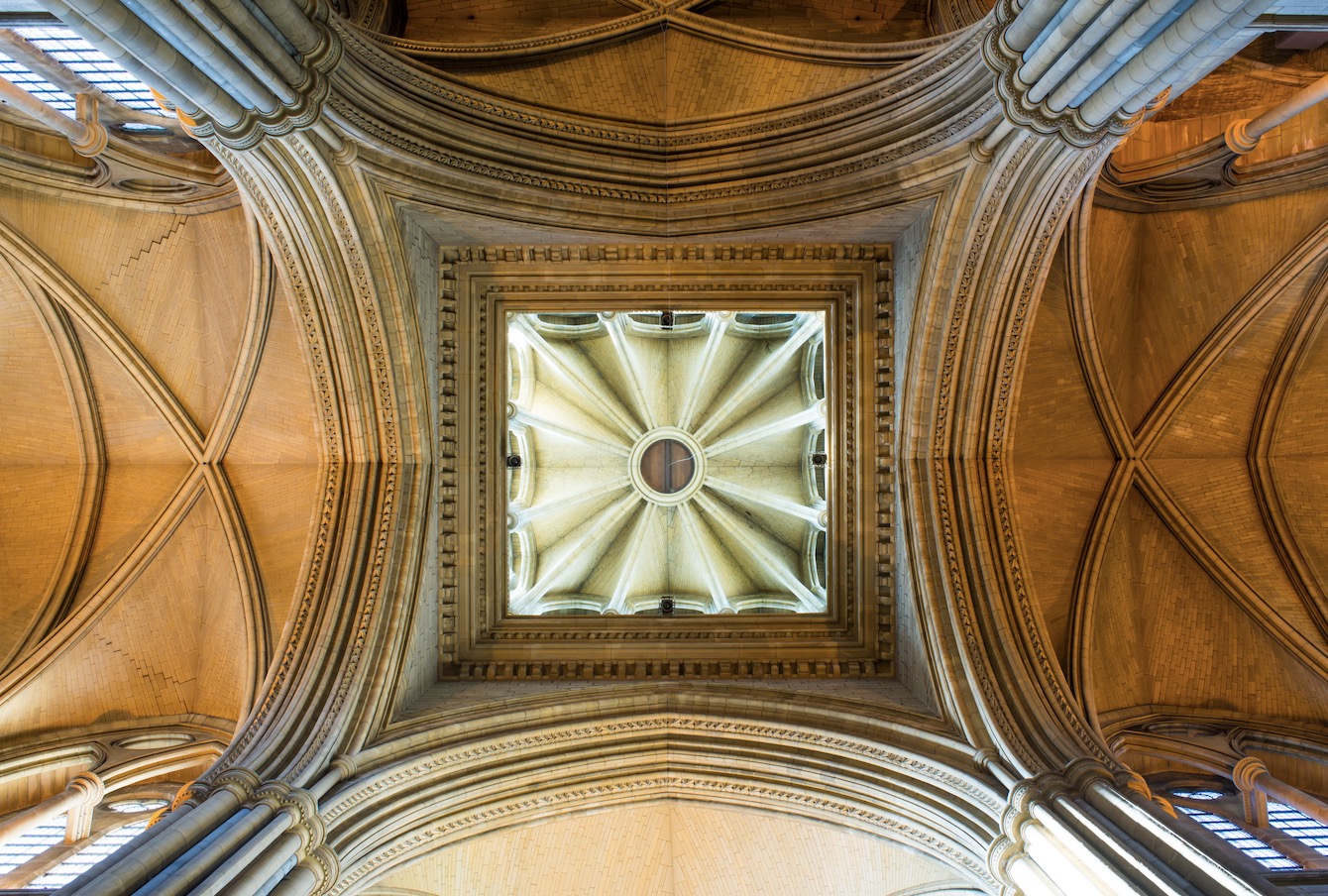
North aisle of Truro Cathedral.
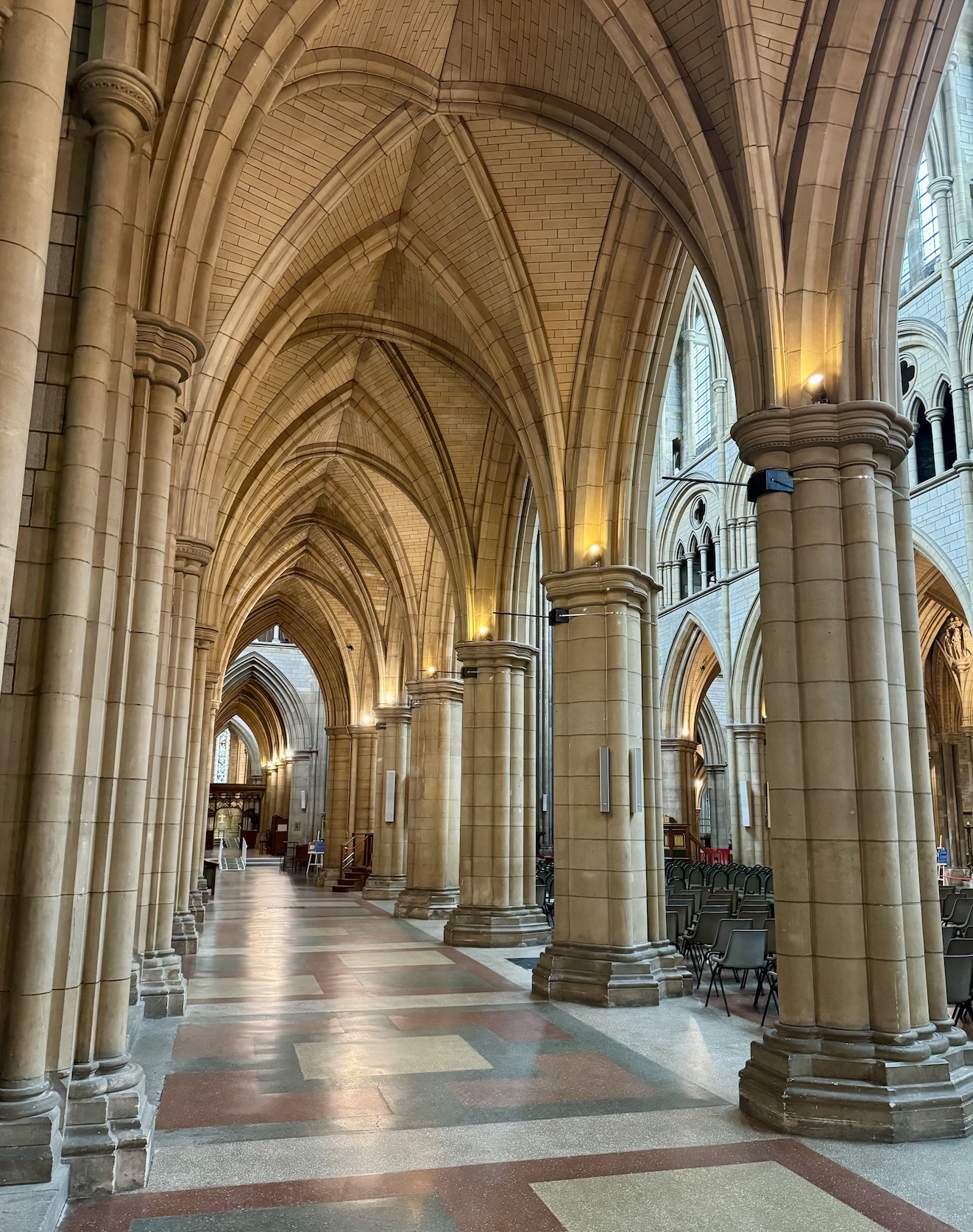
North transept from above.
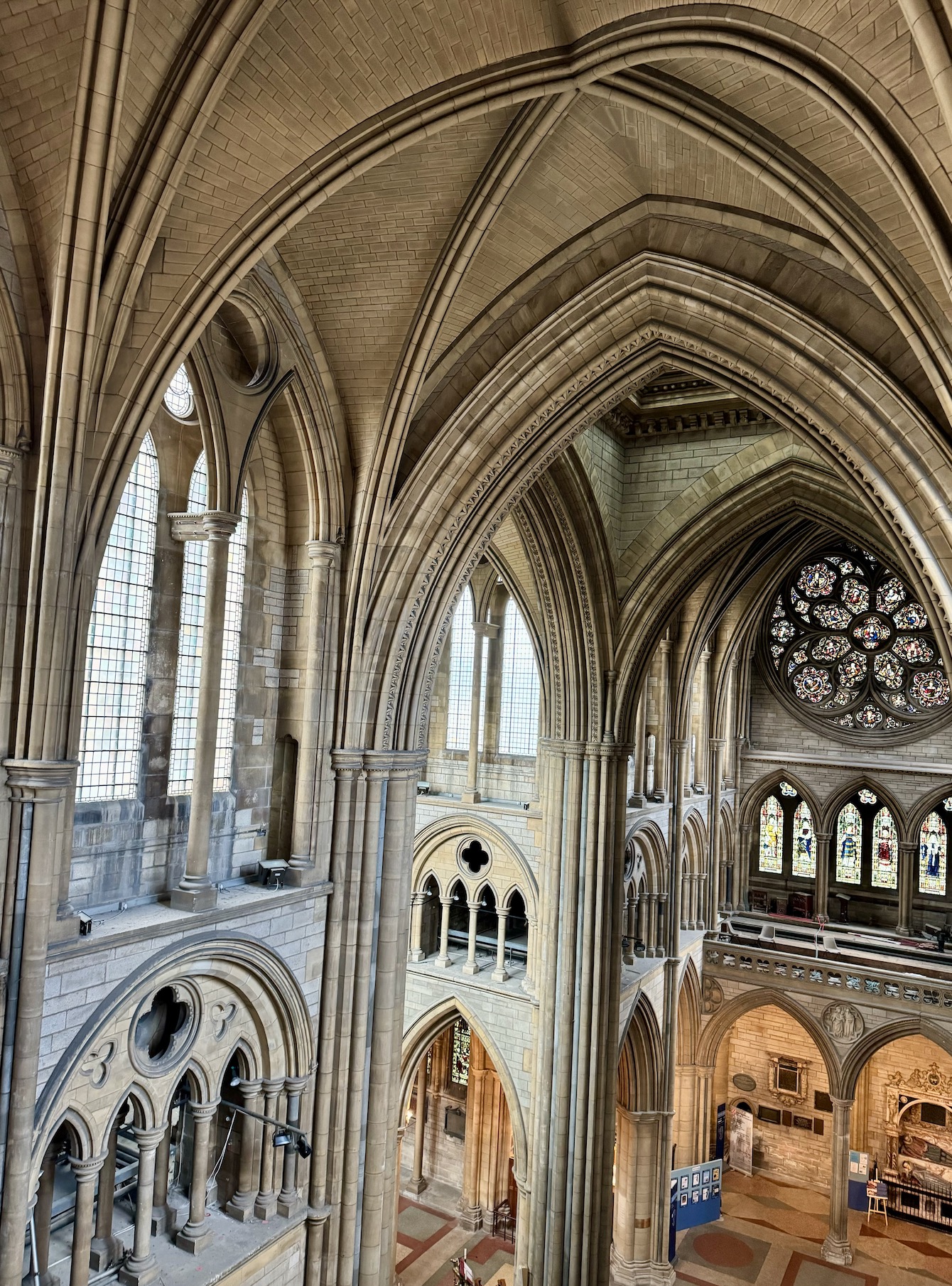
View of the central tower from the 70ft level
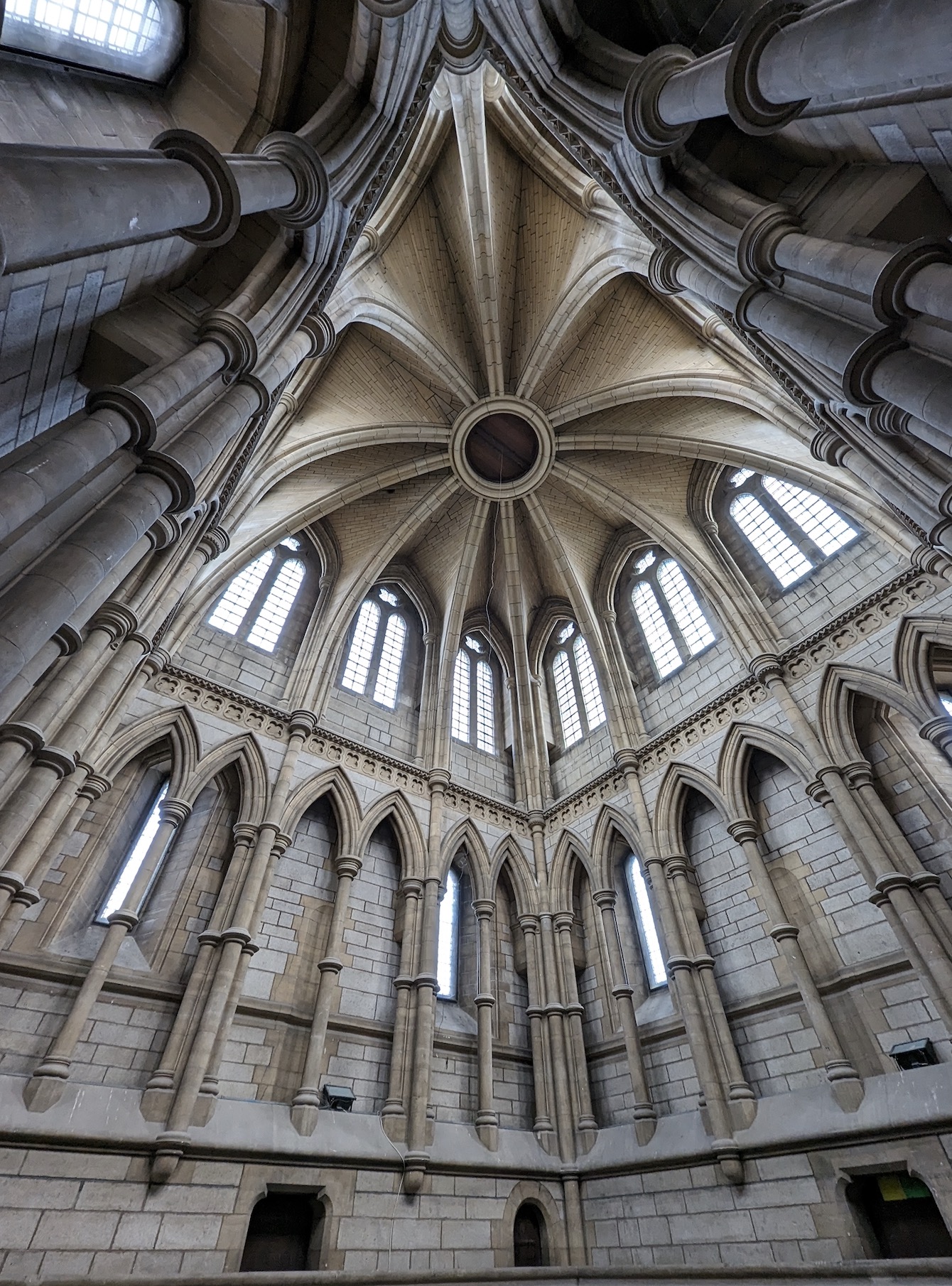
The cathedral ceilings were built alongside the rest of the cathedral between 1880 and 1910. The central tower was finished in 1901 (the same year Queen Victoria died). The architect overseeing the project was John Loughborough Pearson. He initially worked as a restorer for churches and designed many restorations for cathedrals around the UK.
However, Truro Cathedral was a unique proposition for him as it was the designing of an entirely new cathedral. Unfortunately, he died suddenly in 1897 and was never able to see the project through to completion. However, his son, Frank, took over the project and saw it through.
The ceilings are made of Bath Stone.
Wakefield – Wakefield Cathedral quire.
The bright painted ceiling is a Victorian restoration, but the gilded bosses are original medieval.

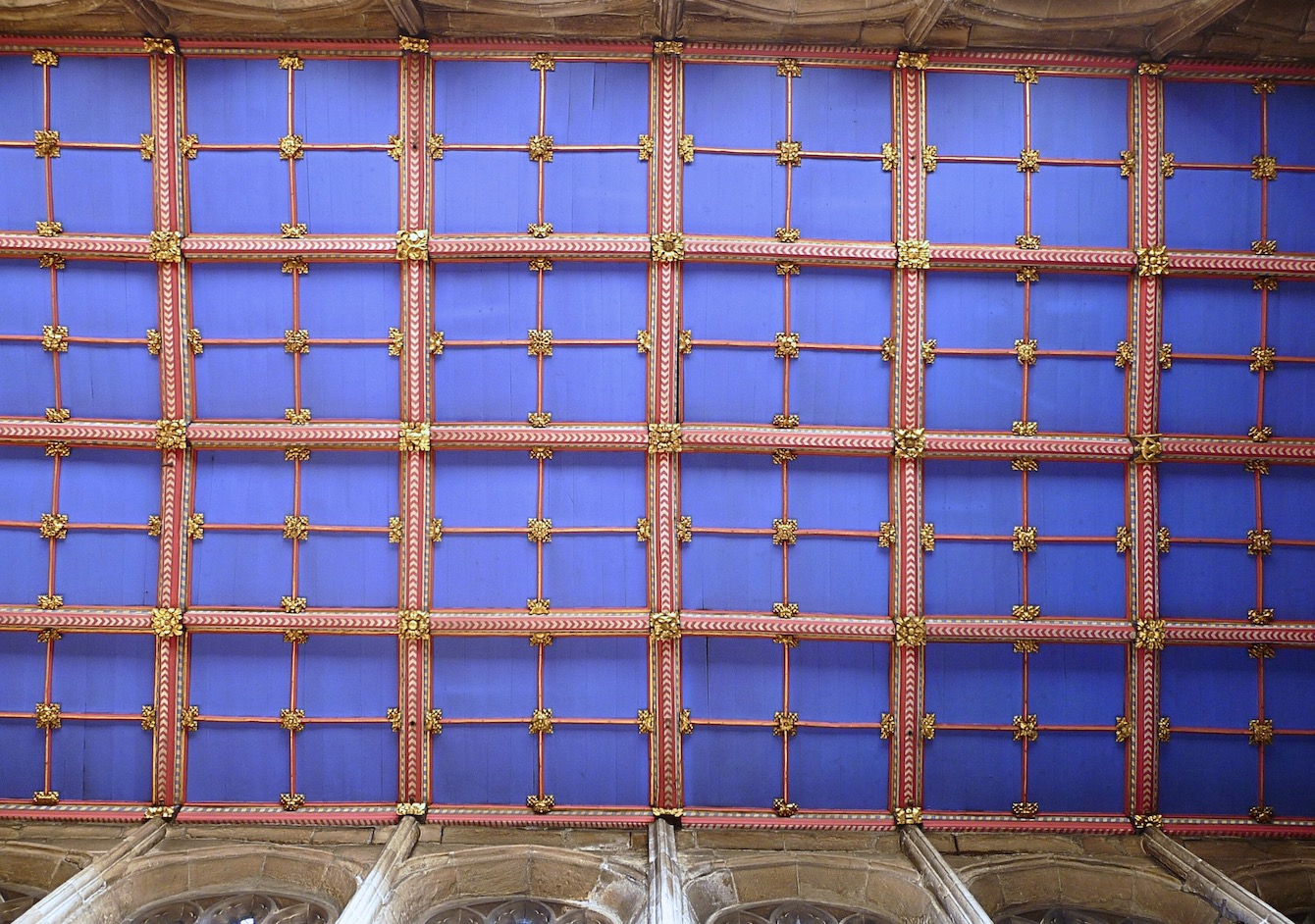
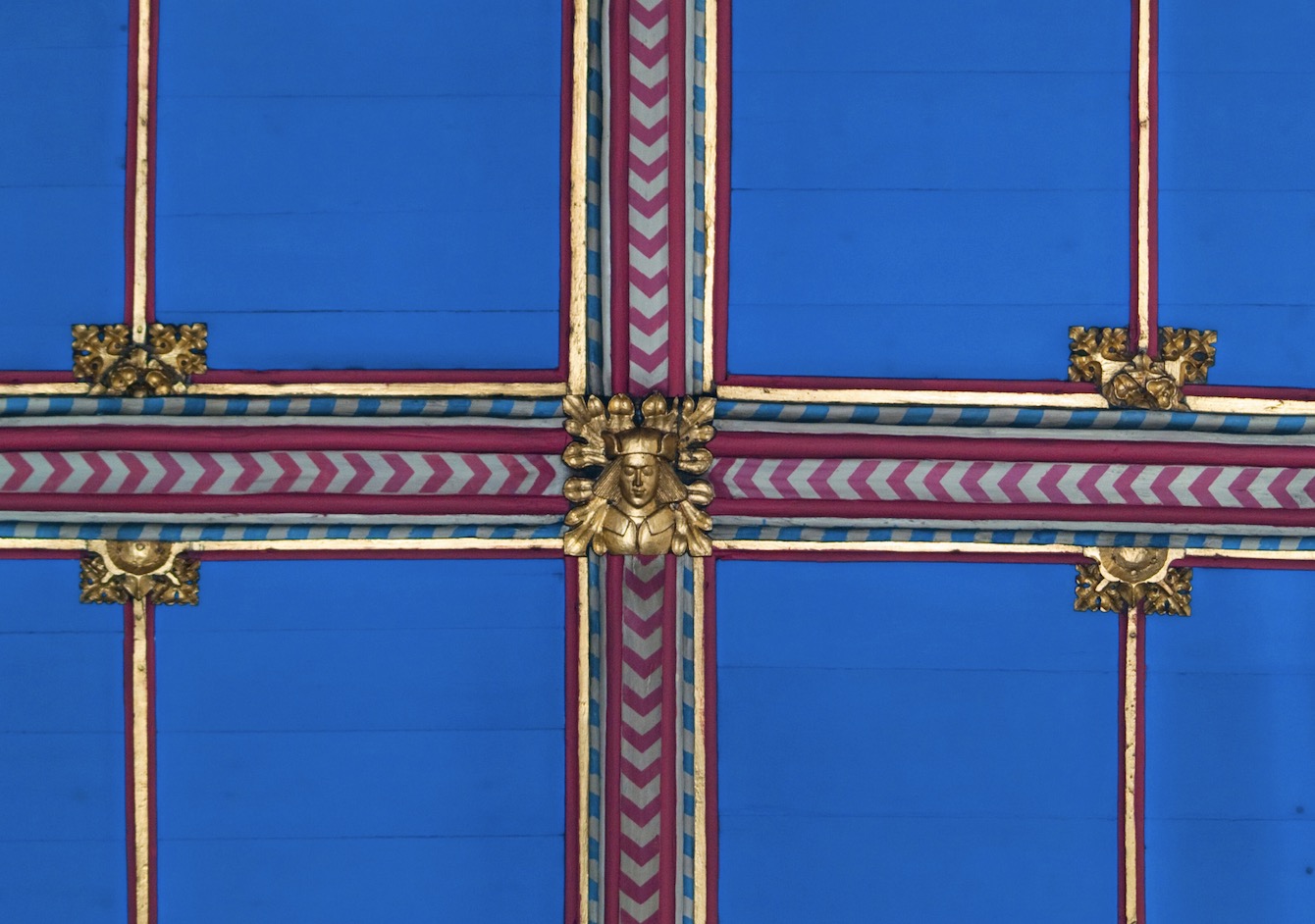
Wells – Star vault — Lady Chapel of Wells Cathedral
A figure of Christ in Majesty sits at heart of this striking design which radiates star-like about the chapel. The linking bosses have fine foliate designs of vine, acanthus, oak and rose.
Although the vault would certainly have been painted in medieval times, what can be seen now is the work of Thomas Willement (1786–1871), who restored the east window in the mid-nineteenth century.
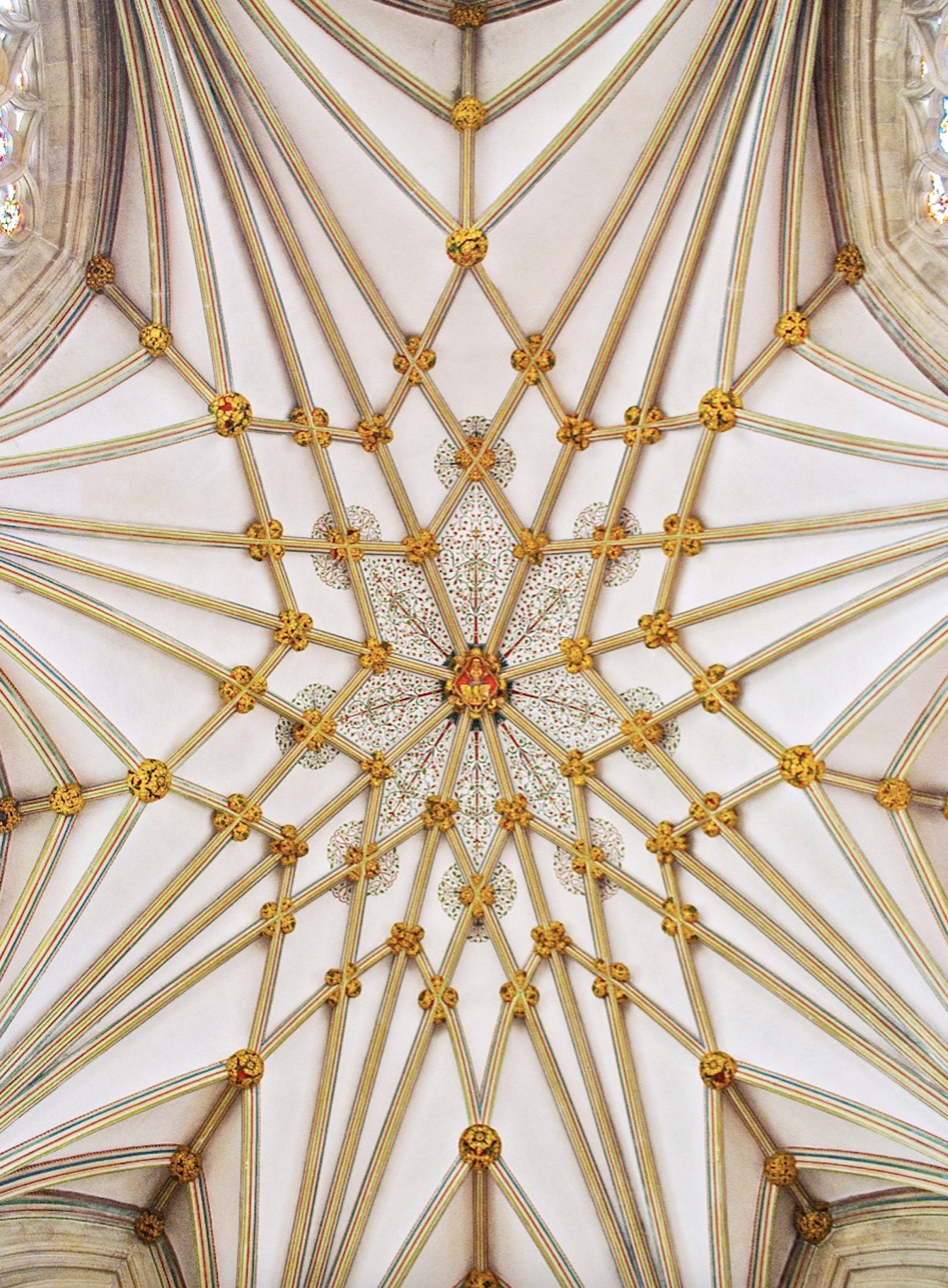
It is said Willement offered to paint the vault free of charge because of unbelievably prompt payment by the Dean and Chapter for his work on the window!
Five designs were put forward, of which the largest was selected. All the designs are preserved in the cathedral archives.
Westminster Abbey
Westminster Abbey’s Lady Chapel was built by Henry VII and consecrated in 1516, some six years after his death.
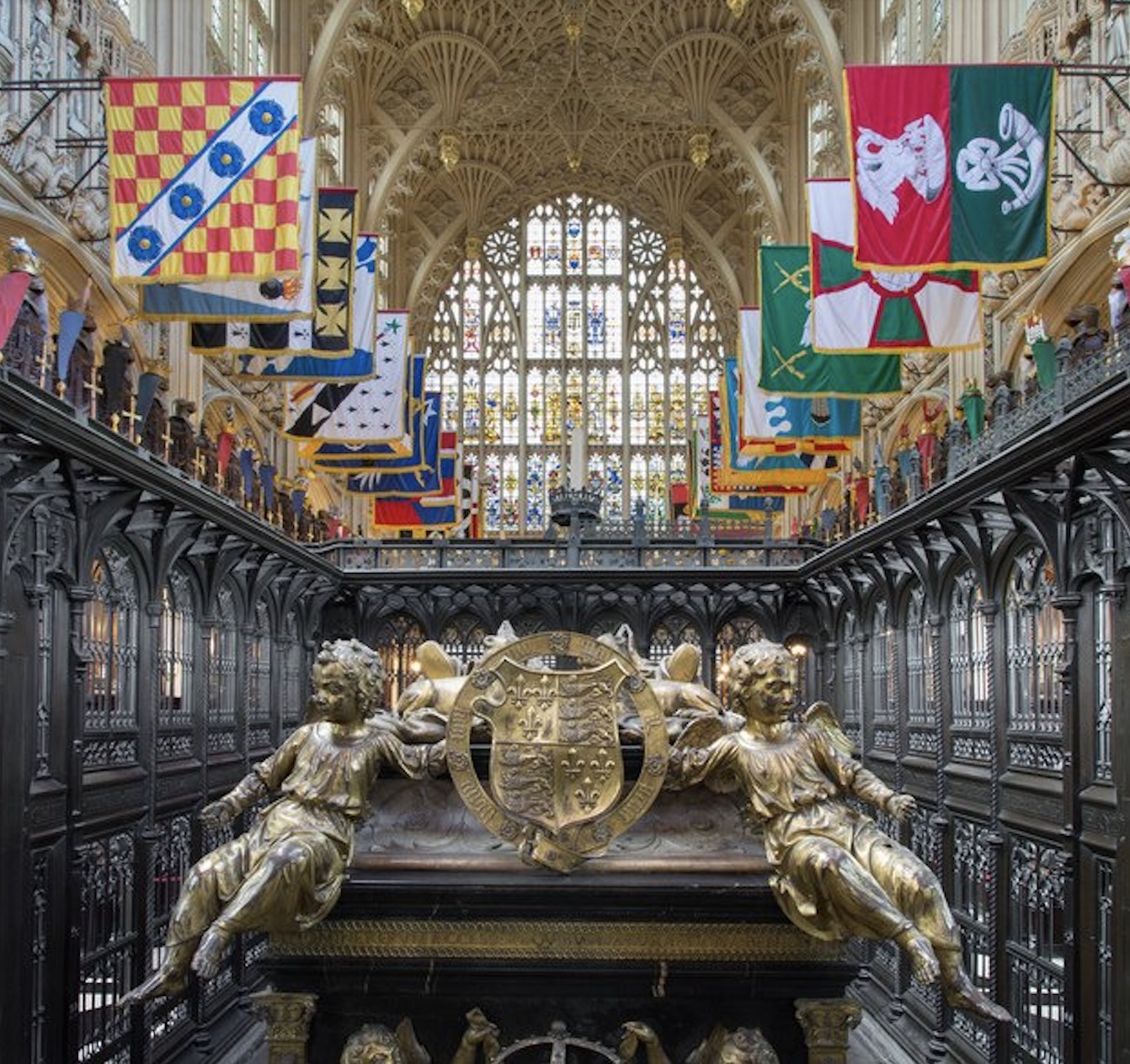
It’s a glorious example of late medieval architecture, and was described by 16th century historian John Leland as ‘the wonder of the world’.
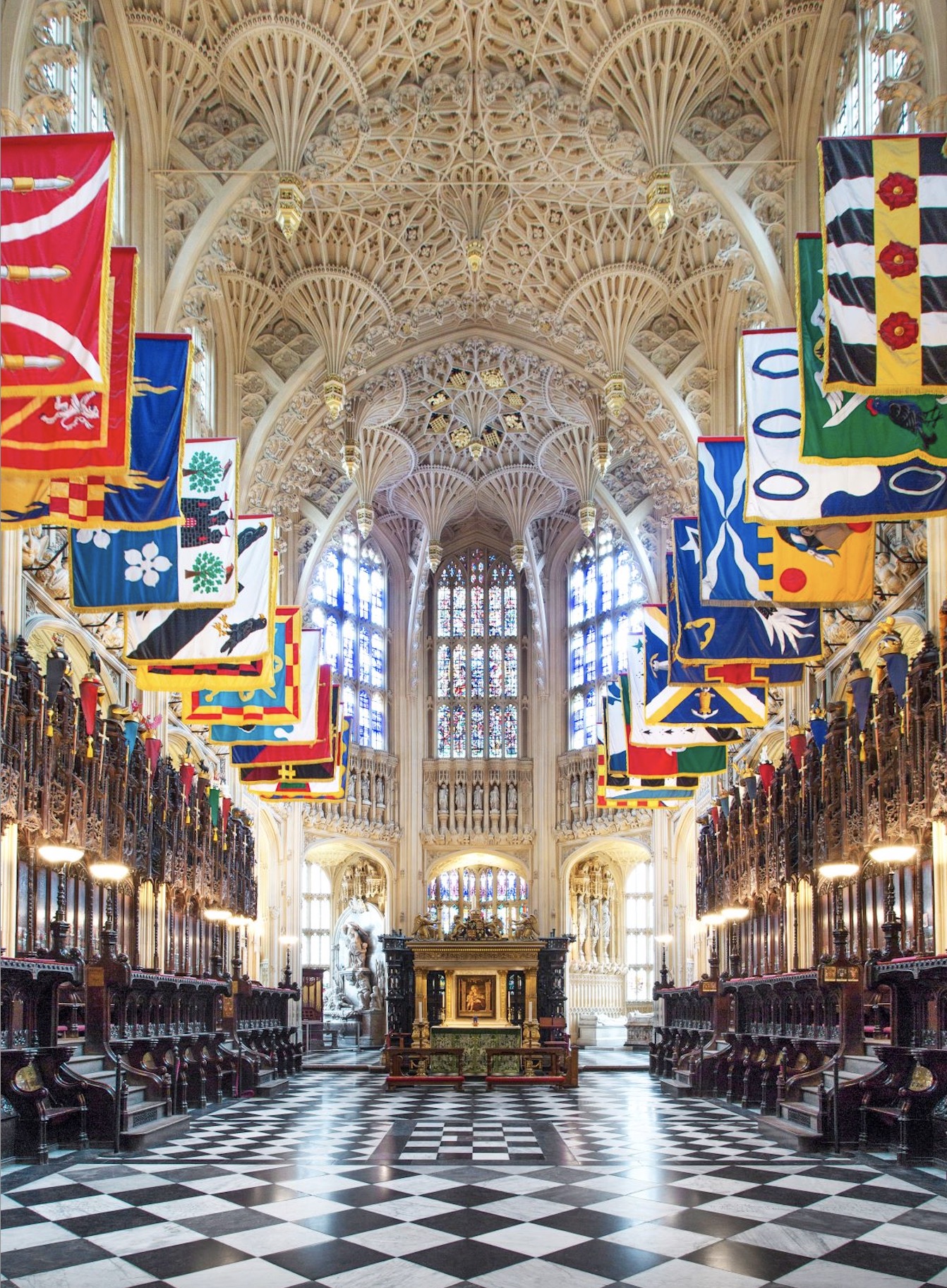
The spectacular fan-vaulted ceiling is decorated with carved pendants and Tudor emblems including the rose and the portcullis.
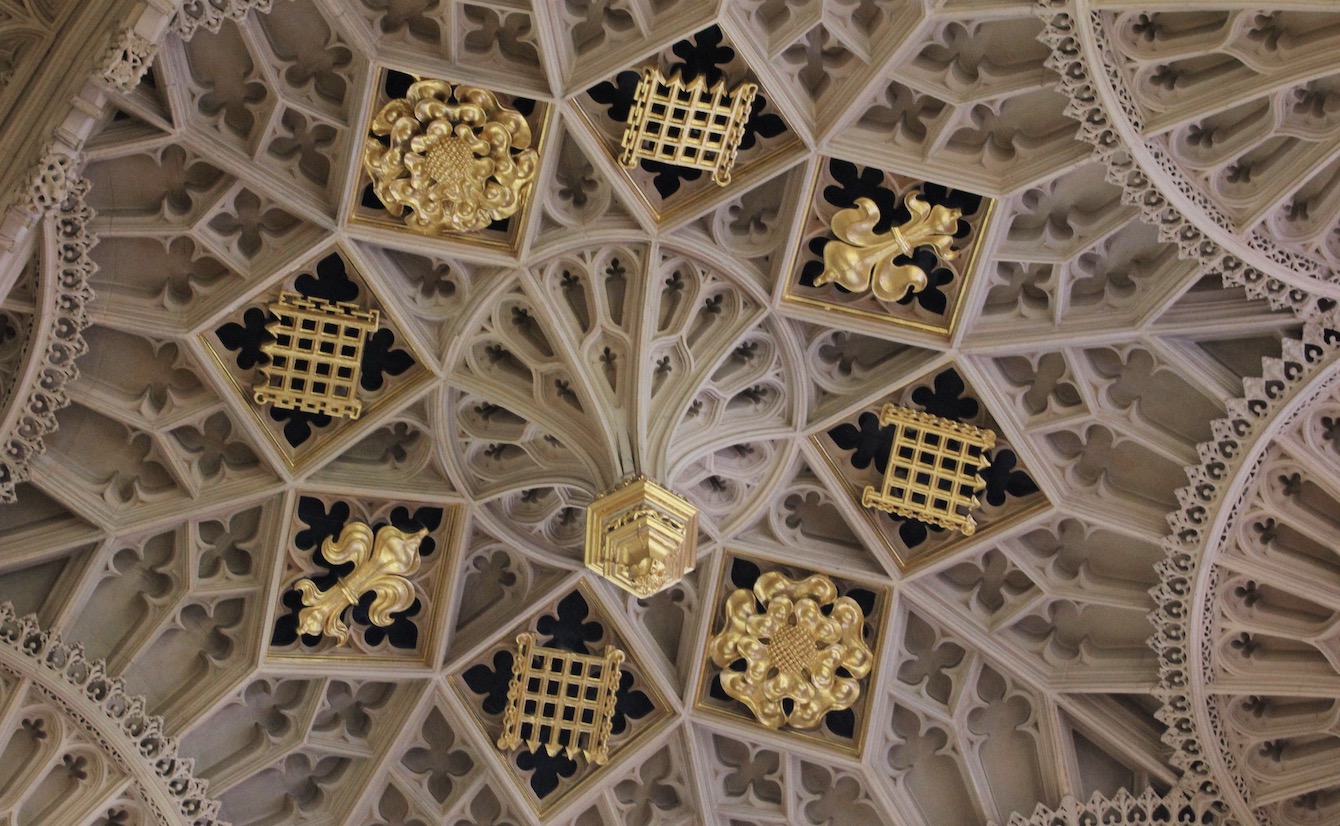
The chapel is the final resting place of fifteen kings and queens, including Henry VII, Elizabeth I, Mary I and Mary Queen of Scots.

Winchester – Guardian Angel Chapel Ceiling
The paintings on the ceiling were a collaborative effort over many years with 8 large and 12 small roundels of angels originally, with paintings of stars and flowers and leaves added approximately 40 years later. These paintings were last restored in the 1950s
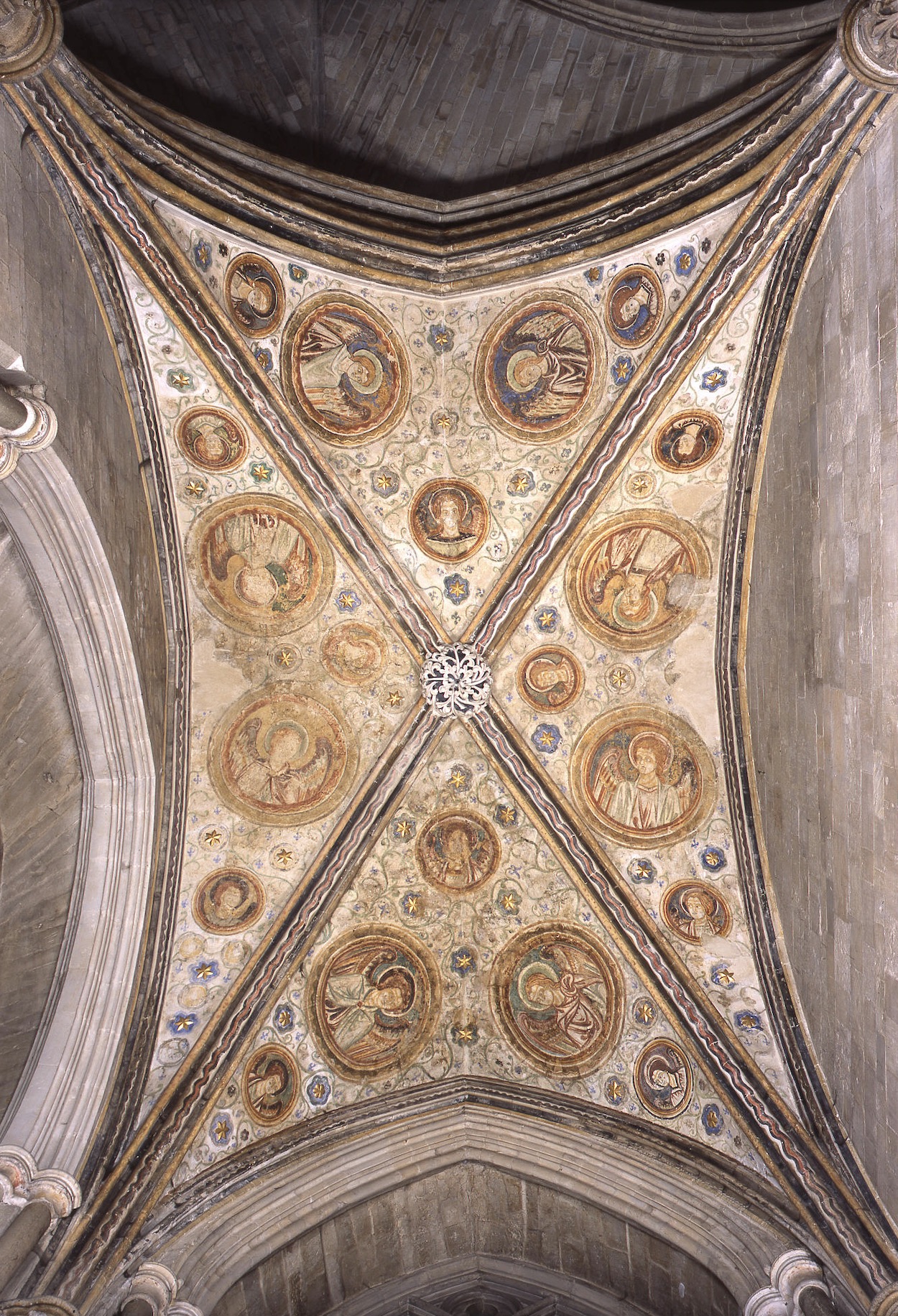
This chapel is named after the paintings of angels in the vaulting which were executed in 1240.
Winchester – Lady Chapel Ceiling
The vaulting dates from the early 1500s and was restored to is original colouring in 1994-5.
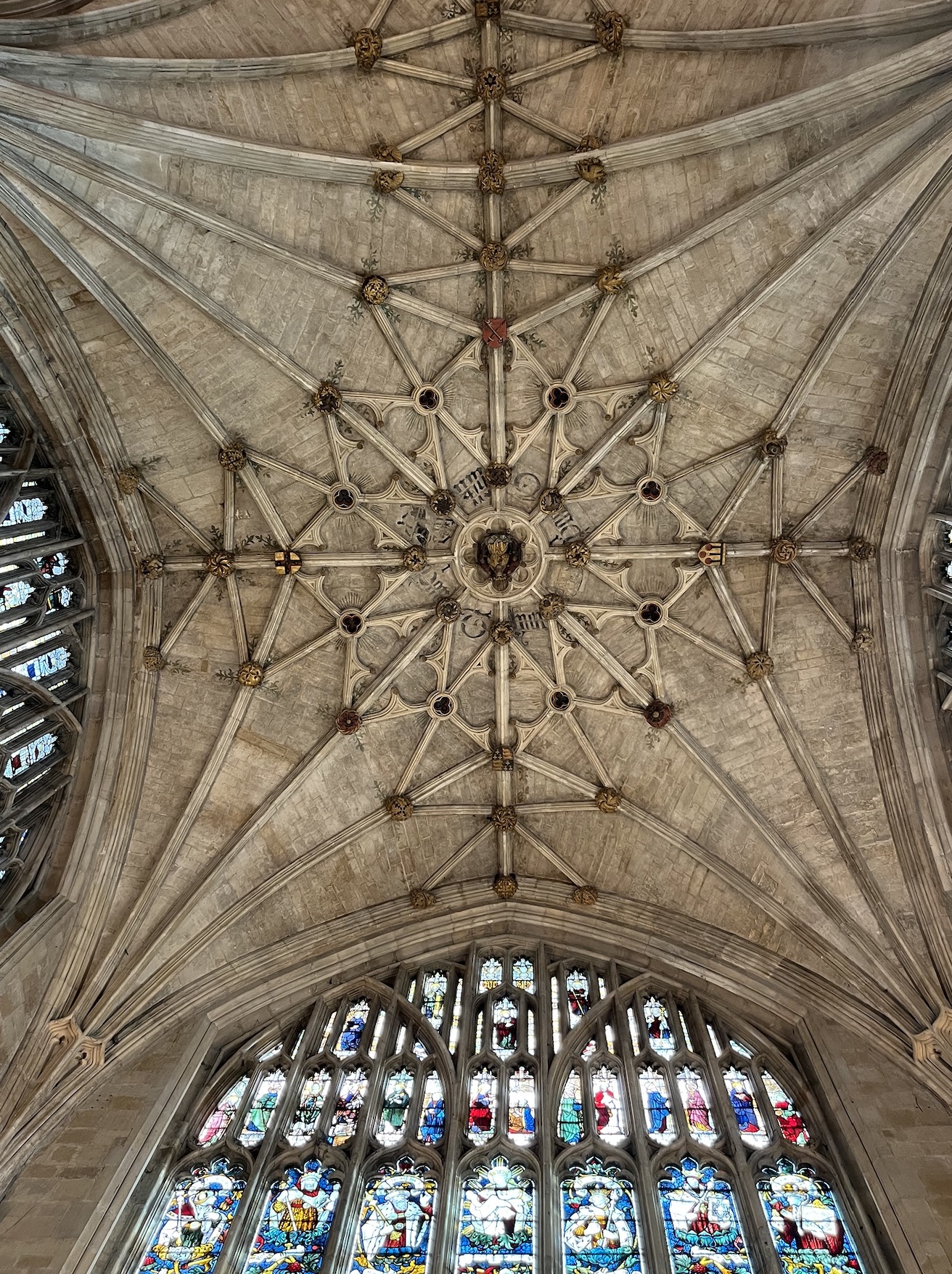
The large boss at the eastern end is “God the Father” and at the Western end “The Assumption of the Virgin Mary”
Within the ceiling there are Coats of arms of 4 bishops including: Cardinal Beaufort, William of Waynflete, Peter Courtenay and Thomas Langton.
Winchester – The Nave ceiling
The decorated curved ceiling was completed in the early 15th century with decorative bosses and carved pieces of stone placed where the ribs intersect.

Winchester – Roof bosses
Over a thousand bosses can be seen today in the vaulting of the Cathedral and some weigh over a ton.
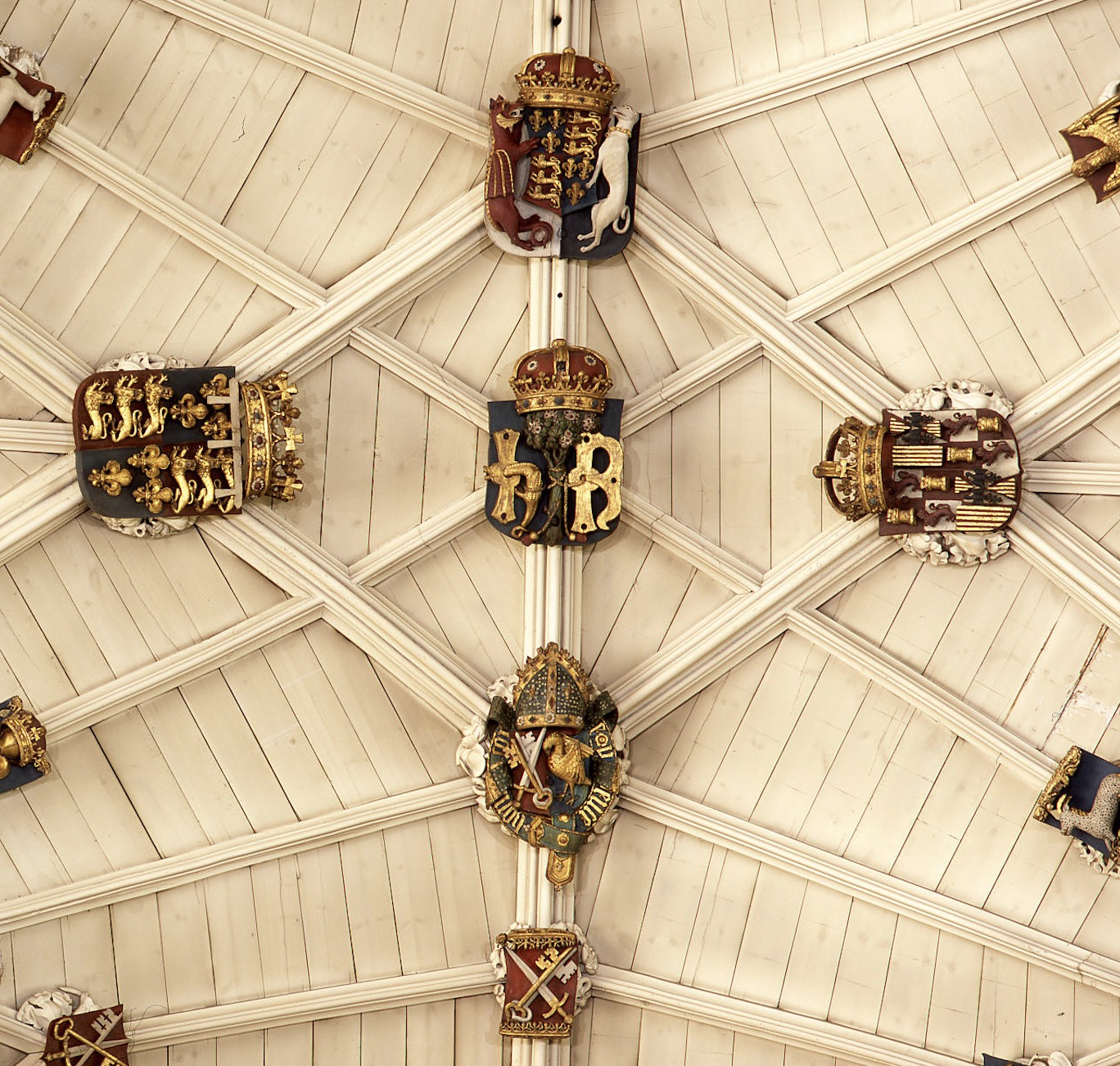
Worcester
The 12th century Chapter House of Worcester Cathedral is thought to be the first round Chapter House in the world.
Its circular structure & beamed ceiling can leave you feeling dizzy! Rumour has it the ceiling once featured a series of paintings, lost since the 15th century!
But did you know the ceiling hasn’t always looked like this? It holds a fascinating secret, that will have you looking up at it in a whole different light.
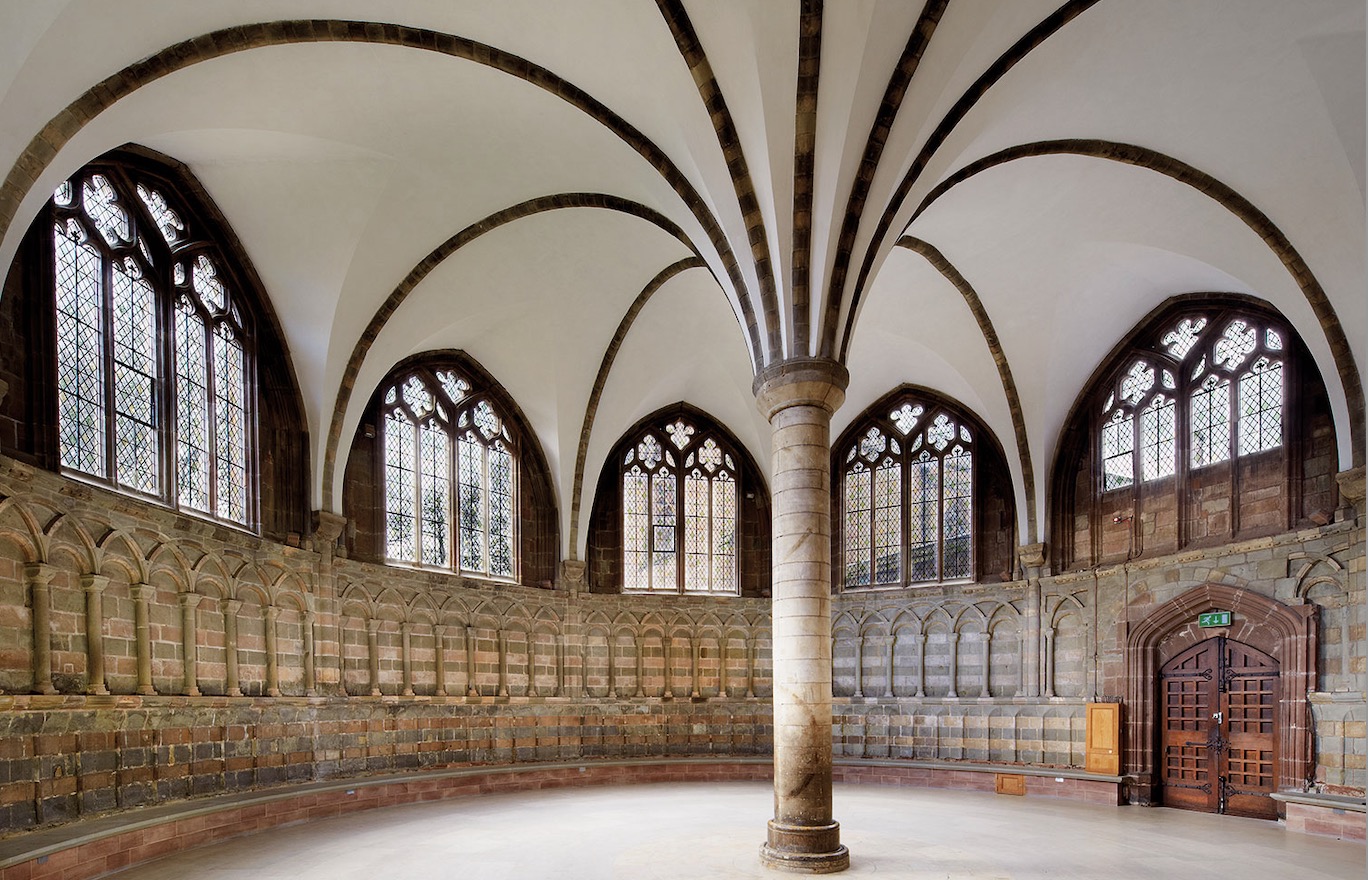
The famous ghost story writer Montague Rhodes James OM FBA – an English medievalist scholar and author who served as provost of King’s College, Cambridge, and of Eton College as well as Vice-Chancellor of the University of Cambridge – produced a document showing
- That the Worcester Cathedral Chapter House once had a series of paintings on its ceiling, lost since the fifteenth century, and
- that Eton College has illustrations known collectively as the Eton Roundels, that seem to have been copied from those paintings.
There are nine which represent the presentation of Jesus, the baptism of Jesus, Jesus carrying his cross, Jesus’ crucifixion, Jesus’ resurrection, Jesus’ descent into Hell, Ascension into Heaven, unveiling the Synagogue and Jesus and the Church.
Canon James Wilson, himself a scholar and a Worcester Cathedral librarian, was a contemporary of MRJ and he published his own detailed study of the Eton Roundels. He acquired a handpainted drawing of one of them. The Nativity illustration as copied and coloured is shown below:

More recent research on the Chapter House paintings, as recorded in the Worcester Jerome manuscript and illustrated by the Eton Roundels, makes very significant claims for them in the history of medieval religious art arguing that they are in some ways unique in Europe[v]. The building of the Chapter House was a later part of the Cathedral reconstruction that had been started by Saint Wulfstan in 1084.
The tenth subject ‘Jesus and the Church’ may show the first depiction of the Coronation of the Virgin Mary in European art, and could even refer to the marriage of King Henry III to Matilda of Scotland. The extravagance of these claims may deserve yet another Blog on the subject of the lost paintings!
Next time you visit take a minute to look up and imagine the magnificence of the lost paintings – and ponder who painted them, and how?
York Minster
The Chapter House of York Minster has stood as a meeting place for the Chapter for over 750 years. The ceiling itself with its bright central boss and intricate paintings is a beautiful sight that captures the imagination of all our visitors. However, there is much more to it than first meets the eye.
Most vaulted ceilings of this size would require a central support column to distribute the immense weight of the roof, however the builders at York Minster devised an ingenious way to spread the load throughout the beams above, resulting in a true marvel of medieval engineering.
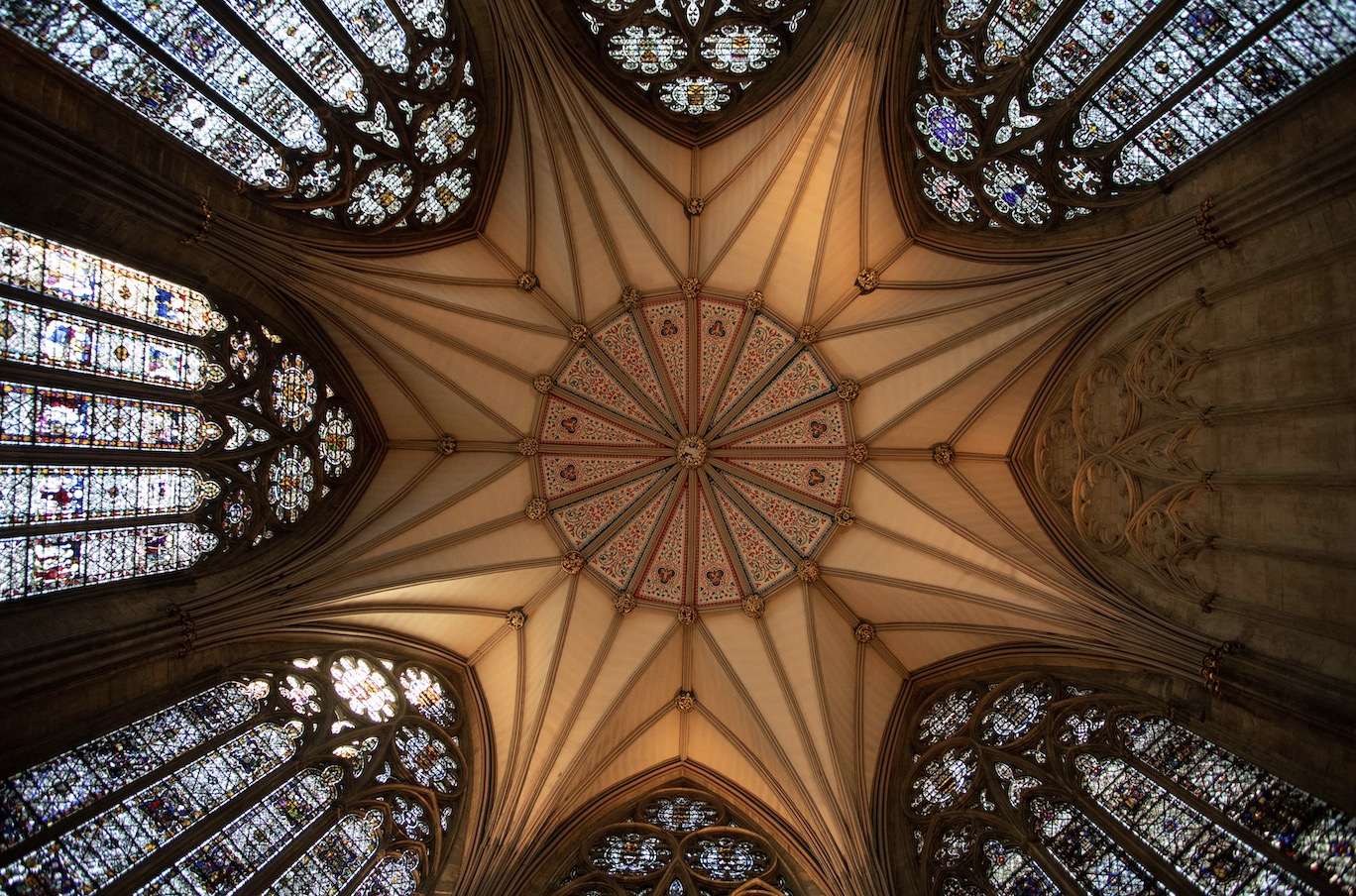
The mechanism behind the incredible ceiling can be viewed on a behind-the-scenes tour, where visitors gain an appreciation for the true complexity of our beautiful chapter house.
Huge thanks to all the cathedrals who provided these brilliant photos and the stories of their ceilings.
Take a look back at our earlier campaign ‘Cathedral Doors – Look In‘, there are some fascinating stories and pictures there too.
Also our Cathedral Treasures Campaign is packed with great photos and stories – take a look here.